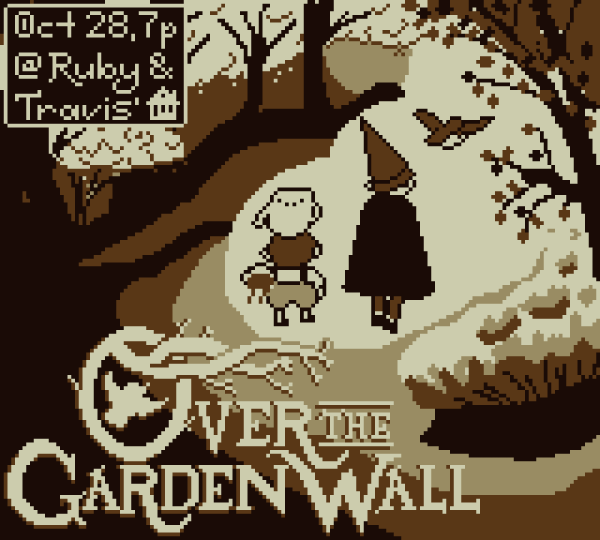
We hosted some friends recently to watch Over the Garden Wall as a nice October tradition. I want this to become a regular thing and honestly, this is the biggest reason I’d want to upgrade our already pretty cozy living room.
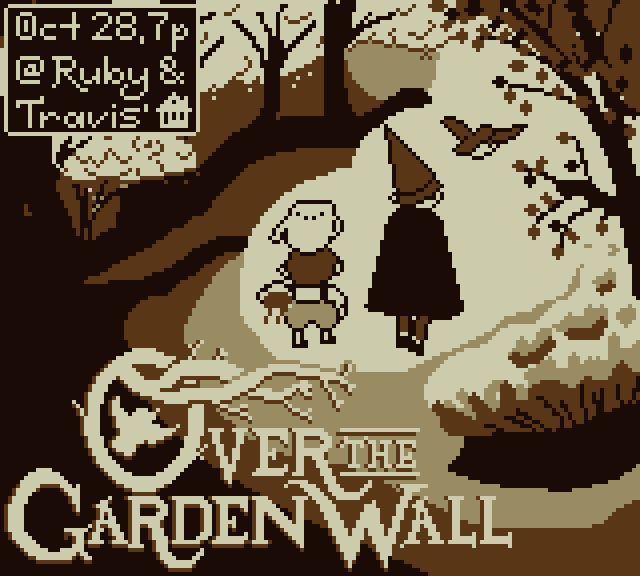

We hosted some friends recently to watch Over the Garden Wall as a nice October tradition. I want this to become a regular thing and honestly, this is the biggest reason I’d want to upgrade our already pretty cozy living room.
My boot camp loan is fully paid as of today. 5 years ago, I finished a software engineering immersive and began volunteering with Code for Philly while job searching and closing down Cycles PHL.
The choice to take that on and switch careers dramatically changed my and Ruby‘s life. But it was not a decision made lightly. Ruby and I planned for me to start that in early April 2020 after a devastating (second) rejection for a salaried job at a nonprofit.
I was working as a courier at the time, and wanted to get away from that work and also the seasonal nature of working in bike shops. I also wanted health insurance. After that rejection that I was led to believe I was a shoe-in for, I decided to get out of “bike world” entirely. Ruby suggested trying a boot camp and that she could cover our bills while I did that, which made it possible to actually do it.
I did a lot of research and settled on General Assembly‘s Software Engineering Immersive program, because it offered outcomes coaching after completing the certificate. This meant taking out a loan for roughly $15,000. General Assembly offered a “Don’t Pay Until You Get a Job” plan but my bad credit didn’t qualify me for it, so I took out a loan that I had to start paying during the course. This cost was factored into what I needed to save to be able to help cover some of my personal expenses while Ruby covered our shared bills and costs.
I got very lucky and after a six month job search, I found my first tech job with Urality. This led me to work with some great colleagues and mentors at Azavea. All of these experiences helped me get to my current genuine dream job developing web and data tools for Community Legal Services.
The shape of my life has dramatically changed from this choice. Ruby and I own a home! I never thought it would be my name on the deed. I have health insurance that isn’t catastrophe-only. My credit score is excellent which opened up even more opportunities (that system is still a scam and is specifically built to keep poor people poor so we should abolish credit scores entirely).
Granted, somewhat surprisingly, I don’t necessarily advise doing a boot camp to get into tech. It can still be a good idea for sure, especially if it’s what you want to do. But the landscape has changed. A lot of the entry level jobs that were there in 2020/2021 largely dried up when interest rates rose and money was no longer free for VCs to borrow.
I often feel like I was Indiana Jones sliding under a closing door and reaching through to grab his hat. I searched full time for six (6) months and put in 250 applications to get my first job. But often I hear from Code for Philly volunteers, as well as people at networking events, that they are sometimes two years and a thousand applications into their search. It is hard out here for junior tech workers looking for their first role.
I got lucky and feel grateful for it. And I am also grateful this loan is finally paid off, and I even paid it off early! The original schedule would have gone another 6 months. In total I have paid about $21,000 for my $15,000 course. But it was well worth it. I am very happy with that choice.
I am consistently impressed by ribo.zone‘s website, but this entry is downright marvelous. But the question does remain: Is this a post?
It seems like it’s calmed down now, but I had two weird spam interactions this past weekend on my personal site.
The first seemed pretty benign, three comments from webmentions on recent posts saying very nice things. The comments felt believable as people individually, but when I saw a third with the same shape of comment from the same IP as the other two, I knew. The language in the comments felt more genuine because of some typos weirdly enough.
There were no links or anything in the comments themselves, but the “from” websites in the mentions led to Playstation-themed blogs with I assume malicious links. In looking up the IP address, it had been reported as a spammer on various services.
The second seemed much more like an attack. Repeatedly for about 48 hours, two different IP addresses posing as many different accounts were using “trackbacks” (an older Indieweb comment format), to comment “Buy [medication] in [country/continent] at [link].”
Where I got three in the other batch, this set left 1,117 comments in total over about 54 hours. The final six hours were being auto-moderated once I limited the IPs and keywords. From this set there was what I think was a test post on Thursday morning and then the spam started in earnest on Saturday.
This was my talk for the HOPE_16 conference:
Travis Southard (he/him)
For HOPE_16
Hello! My name is Travis Southard and today I will be talking about planning a project without a budget
Sometimes this looks like having a contract for a specific set of money with a maximum amount. So it is up to the development team to spend time on the most vital parts, and plan accordingly. There’s a lot of shapes of this, but they all come to:
How much time do I want to spend on this to pay myself/my team what we deserve to get paid? SO: What then about volunteer projects? Or internal ones?
We’ll get into what I have learned in my career so far from a couple of those angles and what I have found works, and what really doesn’t.
We’ll ease in with why you should even be listening to me, defining what we’re even talking about, and a method that is one of my worst working habits that’s GOTTA GO
At the top, I want to explicitly say: These are my opinions based on my experience both at work and volunteering and that these are not the standings of my employer or volunteer organization. While, of course, we may align on some things, the following is my opinion.
Here’s a few things we are NOT COVERING today, and I will not really care to dive into much. These are well-tread paths and boy do so many of you already have strong opinions on them.
Which, by the way, this will not be a “recipe” with explicit steps, but new tools for your toolbox, of which some of these listed are too.
I’ll be covering project-team-level planning, which like my professional work, may be a team of one. Complaints about other teams is a workplace issue, not a project planning one.
Let’s talk about what we, ourselves, control.
Community Legal Services Philadelphia
So why should you even listen to me?
Like I said at the top, my name is Travis Southard.
During the day I am the Senior Developer & Data Analyst at Community Legal Services Philadelphia as the sole member of our Digital Innovation Lab. CLS’ mission is to fight poverty, challenge systems that perpetuate injustice, and change lives through cutting-edge advocacy and exceptional legal representation.
I build web and data tools for our case workers, help them with data analysis, and administer our case management system. Has anyone here worked with LegalServer?
I volunteer as Co-Director of Code for Philly, a member group of the Alliance of Civic Technologists. use tech, data, and design as a mode of civic engagement. We’re making Philadelphia into the city we know it can be by bringing together a community of people dedicated to using their talents to improve their home, and themselves.
For years, I was a volunteer and lead of what is now the PAX (PA Expunger project), with various teammates over that time.
Before getting into software, I was a bicycle mechanic, bike tour organizer, a courier, and many other jobs.
We are going to make a website specifically for the IndieWeb that is a gachapon/bubble machine with a finite set of little pixel art guys of various rarities. Until I reset the machine with new little guys, I want people to only be able to play once.
No NFTs. Yuck.
What would you start with and why?
I want to do a quick icebreaker. We can’t spend the whole time on it though I would love to spend the day on this. So:
We are going to make a website specifically for the IndieWeb that is a gachapon/bubble machine with a finite set of little pixel art guys of various rarities. Until I reset the machine with new little guys, I want people to only be able to play once. No NFTs. Yuck.
What would you start with and why?
No right or wrong answers, raise your hand if you want to answer.
My first: Draw it out with notes of what different features I want. This helps me fill out fuzzy details and make firmer choices about the design.
$0.00 budget – What we typically think of. We have no money to spend on people or supplies and need to be scrappy. These are most often volunteer projects we are making because we just want something to exist.
No Budget – We might have funding for people and maybe supplies but not a cap of hours, so we have to direct our own time. This is my work situation where I am paid but if I ask, “Is there a limit to place on this?” I might get an answer like “Oh, don’t spend too much time, it’s just a nice to have” or “This is mission critical. Make this happen.”
Urgent – Having high priority for finishing before anything else; typically because of a hard deadline or others being blocked by this not being finished. When you can avoid letting things become urgent.
In approaching working on a project, whether new or ongoing, I need to know what it is I want to work on right now. What are the things that need my attention the most right now?
When we think of project planning, we often think of looking at the whole project at the beginning and laying out steps or maybe sprints. While that is certainly part of this, for today, let’s consider the scary question: What am I working on today?
Sometimes that is obvious, but often it’s not. I work on a bunch of projects of various size and progress. This means constantly checking in with my team to see where we are and what is urgent.
I want to approach projects by laying some basic infrastructure, working with loose doodles of where I want to end up (kind of like dry-fitting or laying out the pieces into their rough places), and then fill in details.
Those details should be the functional parts first, then styling them. That gets fuzzy in the laying out phase. But it is better to demo an ugly dropdown that does a task so much more seamlessly than how we’re doing it now, than demoing a beautiful, finely crafted element that you then have to explain what it does with your mouth. Show don’t tell counts for demos too!
Also what the tool does decides how it looks. Yes, you can style in many ways, but the style needs to help communicate what the tool does and how to use it as well as being beautiful. This may feel like it cycles back to the big shapes step, and it does. Design is iterative and we get better products that way.
Here are a bunch of questions I ask myself when planning out what to work on when. These require honesty with yourself and with your team.
What skills does our team have? This changes as the team changes and even sometimes day to day if teammates are out sick, on vacation, or attending conferences.
How much can your team work in parallel is two parts: Do these tasks have a specific order or prerequisites? AND Is my team capable of this? We want it to be. It should be. But this comes from practice and process.
Prioritizing based on urgency and deadlines is huge given we have “unlimited” time but also very limited time. How much time is left is a consideration, but also, especially at CLS, missing some deadlines are much more detrimental than others. These must constantly be weighed and re-weighed.
Is there something already built that does this? Do I need to build an index of websites and catalog the web for my caseworkers?
If it exists, why aren’t we using it? Cost? Missing features? Completely unnecessary invasive data mining that would both break our duty of confidentiality and make our world a worse place? A really annoying UI? If you have too many things in process, “It’ll be fun” may not cut it.
Also, constantly ask yourself, what does done look like and what to we need to do to get there?
What does not work? What I started calling just-in-time delivery, based on the concept in shipping and manfuacturing logistics, which we saw spectacularly fail in 2020 globally and again with the Evergiven getting stuck in the Suez canal.
The idea is, I owe my coworker this dataset on Tuesday morning so I will do it Monday. Another deliverable is due Wednesday morning so I will give myself only the underestimated time I thought it would take to complete that task while I am really under the clock. That suuuuuuuuucks!
This is completely unnecessary pressure to put on yourself where you will make poor decisions from desperation or rushing. There’s no way to ensure you’re doing your best under these conditions. Our clients, stakeholders, and we deserve us doing our best.
This is also incredibly fragile since any delay will only add more onto the next task and so on recursively until you are forced to exit dramatically. Which is often the only way to break this cycle and give yourself any sense of stability in your workday.
Working this way will only pile stress on you and will prevent you from being able to take sick days or vacation without completely ruining timelines and disappointing your coworkers which then compounds more stress on.
So again: Do not do this. It will only lead to doom!
Let’s talk about making plans so our projects are getting done sustainably and reliably. Like I said at the top, this is not a recipe or set of steps. I want to outline some considerations, questions, and checkins that you should be doing with your team consistently.
Also, no, I am not doing this perfectly. I am a team of one-ish with a lot of different projects of different sizes for different teams at a 200-person organization. This is largely some work therapy for myself, and thank you for your time. You can each bill me later.
I have implemented most of these, but it all comes with practice. Let’s help ourselves get things done.
Know how fast you actually work. How much time does it take your workers to complete and deliver work?
This will change over time based on who on your team is available at the time. Who is on vacation or out sick? Are you shorthanded? (Probably) Is there something happening in your workplace, city, country that might distract us or make our jobs harder?
Now: there are PhDs dedicated to this idea, so I won’t solve this in a slide. But I have some tips for evaluating.
Tracking time on tasks or calculating completed tasks per sprint/week/month. I worked on a team at Azavea that tracked this very well. We would track what we got done considering our days off and missing people, and then use a running average to predict how much work we could expect to get done in the next sprint considering days off and who would be available. Granted, we did still feel too slow. That we were spending too many hours per task.
Whatever time you think it will actually take you, plan for it taking 125-150% of the time. So “Oh four days” becomes 5 or 6 because of course things will come up. But tell your stakeholders/collaborators/team-waiting-on-you-to-finish 200% or 8 days in this case. Under promise, over deliver. Give yourself room!
Speaking of giving yourself room: The time you spend fixing mistakes, making changes based on feedback, or writing documentation (and you should write docs, please!). But time on docs counts towards that time.
This is often a set of time we don’t really think about if we’re not having to report hours, and even then, we might miss it.
Even if things go well and smoothly for you, leave room because it happens to all of us and having that room avoids a panic situation.
Remember: It will likely take you 125-150% of what you think it will take.
Break your tasks down to the smallest possible steps. Write them down. List out the steps you think of at first. For each item in the list write out the steps it takes to do each thing.
Also yes, write them out on your index-cards-on-a-board of choice. “I’ve got it in my head” or “I told you what to do” does not count. Do your team and yourself a favor and write these down. Yes, they will change over time, but these cards are editable.
If you find yourself writing a card with a checklist on it, there is a good chance that each of those checkbox lines should be their own cards.
When I was leading a Code for Philly project, I was lucky enough to take on a fellow who would be spending 10 paid hours a week on the project for 8 weeks. That was easily double what I was spending on the project. She deserved being able to independently pick up new tasks as she finished them. And she really did. Elizabeth kicked ass!
Before she came in I kept telling volunteers “Oh ignore that task, it’s not relevant anymore ” or “Don’t follow the docs, this is how to get set up” which was bonkers. In rep for Elizabeth starting, I rewrote our documentation and combed through our cards and broke them up, filled in holes, and labeled them by difficulty, priority, and what parts of the project would be involved. The project still follows that standard
If you are in charge of your project, doing these steps and doing them well will mean that there will be much less “Hey what does this mean?” or “What should I do next?”
This also applies to larger or in-progress projects, but I have found especially helps smaller projects that come up quickly.
For projects that you plan to use similar tools to what you have used in the past: Make yourself a template. Don’t spend time asking “Wait. How do I set up X? I remember it being easier.” Use a project that is set up the way you want this next one to be, copy it, and strip it down to the infrastructure. That’s a template. You can then fork that and get going on the work.
For any project: Every time you spin up a new teammate, have them set it up from the documentation without you. Then, every time they ask you “Wait. How do I get past this error?” figure it out with them and have them update the documentation with that info. If this is built from a template, add those changes to the template’s docs as well.
This is harder to remember to do but: When you fork that template, if you update anything, also update it in the template. That will help it stay up to speed with you.
Also, wait: Does this already exist? Why aren’t you using that? This is a valid decision, but make sure the answer to “Why aren’t you using that?” is satisfying you and your team. “Because it’ll be fun” may not be enough if we have limited time and resources.
Make yourself a calendar with your deadlines on them. This will help you estimate urgency and know when your promises are getting too dense in a particular month.
If your team is regularly meeting in a particular place, a paper calendar may work to help keep those timelines top of mind. A cartoonishly big one? Events in a digital calendar too, but it’d be good to keep those in a separate folder so you can hide them when you need to.
The big part of this is understanding there’s not actually that many days between delivering this to one team and that to another. Like I said earlier, don’t trap yourself like that. Being able to see a fuzzy version of the future is a great way to (hope to) avoid that
Okay this one isn’t hard but it’s also very hard. This is about being honest with yourself. Don’t try to reassure your colleagues if you know you are in a spot where you are going to be later than expected.
Leave room for error. Remember that whole slide? Under promise and over deliver. It makes you look good and reduces stress. 125-150%
Tell them once you know (for sure) that you’ll need more time. Some deadlines you cannot flex though so you may need to reduce your scope, or skip some nice-to-haves to make that deadline.
Know what your MVP is. Know what you need where if you had to hand it in or make it live, that it would be usable and trustable.
For me, easily the biggest part of planning (and executing) a project is having a practice, as in, approaching your project from a consistent set of steps you do in every project, every feature, or every task to keep your work consistent. Those steps will change slightly each new cycle as you learn which steps are less helpful and as you find a better way to execute that step.
If you can believe it, I was a theatre kid in high school and in my early 20s. I don’t remember the scene, but I remember there was a two or three person scripted scene. After we finished, the director asked me why I chose to stand when I did. I argued that I didn’t make a choice, I just felt we were all too still. Which is that I felt we were boring and wanted to add movement for movement’s sake.
She was right to point out that was a choice I made (a bad choice), and knowing why I made the choice will make me better at my craft. Knowing why I chose to put this button here or an image there. Knowing why I moved this variable to a contants file or named a function in a certain way.
Practice is a key part of what we do. Having an intentional process with intentional choices makes us better at what we do as teams; saves us (long-term) time; establishes patterns to make reading and developing our work easier.
Thanks to the HOPE staff and volunteers for letting me ramble a bit about project planning. The conference was so fun!
Had a fantastic time at #hope_16 this weekend! Watched cool talks, met cool people, and got to give a talk myself that went well!
Will post a blog post about my takeaways and the slides and recording from my talk, but first: I must sleep!
Currently reading Karen Hao‘s Empire of AI while also needing to advise more at work about responsible use and data safety around AI. I have largely been a curmudgeon about generative AI in general, being concerned about environmental impacts, data leaks, and it genuinely just having underwhelming products.
But my grumpiness shouldn’t stop me from continuing to keep up on the topic and learning how the tech works. After being frustrated by a lot of reporting that is obviously booster hype or just copy-pasting press releases from the AI companies, I have been ignoring a lot of it.
Who is doing up-to-date, clear-eyed, critical reporting on AI and the industry? I would love to read reporting about AI similar to Molly White‘s Citation Needed newsletter about the cryptocurrency industry. Ideally an RSS feed with regular updates and context both about the tech itself and the industry. This will likely be multiple sources, but who do you like? No boosters and no doomers, please.
Votes for the Tiny Awards are open! These are awards for the “best of the small, poetic, creative, handmade [websites]” that were created in the past 12 months. They are all impressive and powerful in their own ways.
The websites featured (this year and the previous two) are great sources of inspiration for building websites. I find they are especially good for breaking me out of the patterns and habits I fall into when designing.
I won’t say who I voted for here until the voting is closed because I don’t want to influence votes. Happy to chat about it offline or in DMs after you vote.
I am delighted to be speaking at the Hackers on Planet Earth (HOPE_16) conference in Queens in a few weeks! I’ll be talking about “Planning a Project with No Budget” based on my experiences at CLS and Code for Philly.
Been a 2600 Magazine reader and Off the Hook listener for years and am excited to share some of what I’ve learned. Even more excited to attend some of the rad sessions they have planned! Especially the ones on open source development, art, and community building.
I’m old enough to remember when it was both illegal and inappropriate that the President of the United States would forgive $10,000 of federal student debt for borrowers and $20,000 for Pell Grant recipients.
That would have hindered the income of the hard-working Americans who own student loan servicing companies. These entrepreneurs following the American Dream paid $7,000 for a $30,000 loan and thus EARNED the $50,000 borrowers will pay over 20 years.
How unpresidential and overreaching!
Andrew Dana Hudson looks back on “On the Political Dimensions of Solarpunk” after 10 years. When I was first learning about Solarpunk in 2021 (and getting my eyeballs on every piece of media about it that I could), this piece resonated with me strongly and I refer back to it often. And today, Andrew looks back on that with both wonder at how it’s taken hold and want for it to be more realized in the material world.
We’ve spent over ten years imagining better futures. When I wrote “Dimensions,” that task itself seemed daunting, obscured as alternatives were by the choking neoliberal smog. But, in a tremendous feat of collective imagination, we did it. We pulled it off. From the policy-wonkish, to the pro-topian, to the perfectly utopian, we’ve created a range of answers to the question, “what does a sustainable world look like?” Solarpunk can now serve as a vital shorthand for that set of imaginaries.
I’m not saying the worldbuilding work is fully complete, but I do think we’ve reached a robust place. It’s time we turned our attention to other tasks, to the other part of the definitional question: “how do we get there from here?”
Also if you like Andrew’s work, subscribe to solarshades.club. The RSS feed is how I got this post.
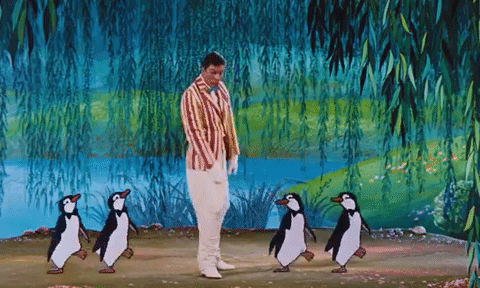
I saw a post come through my RSS about an IndieWeb Movie Club. dead.garden chose Mary Poppins as the movie for June 2025. Ruby and I watched it together a few nights back.
Ruby said she didn’t remember it all besides the “Spoonful of Sugar” scene. I thought I remembered it, and certainly remembered most scenes, but for a lot of songs I was surprised at stuff that went much longer than I remembered. Also there were so many more songs than I remembered. They are (at least listed from the soundtrack):
There are also so many little scenes where the characters drift in and out of singing like Bert’s One-Man-Band at the start and especially “A Man Has Dreams”. Some of this is fine, though unexpected and doesn’t feel super motivated, but this was made in a different film culture and also at the end of the mainstream popularity of the musical film.
One thing I noticed this time around is that a good bunch of the songs didn’t really have strong connections to the growth of the characters. The only dynamic characters in the film are Mr. Banks, Jane, and Michael, who over the course of the film learn to really see and respect each other. Everyone else are just about the same at the end as they were at the start. This I had noticed before (or more likely my sister pointed this out to me), but so many of the songs didn’t really lead to any character growth (or only contributed some of the things Mr. Banks would realize were charming at the climax).
I don’t necessarily think it’s mandatory for every song in a musical to be tied to the plot, but it does feel important to my enjoyment of them. The ones that don’t contribute much are still charming as hell and fun scenes, but largely feel meandering. I have here each song paired with what I think it’s contribution was to the growth of Mr. Banks, Jane, and Michael.
| Title | Character Growth/Learning. |
| Sister Sufragette | Introduce Mrs. Banks and her condescending relationship to the people she employs and her children. |
| The Life I Lead | Introduce Mr. Banks and his condescending relationship to the people he employs (which from his view here, the employees group includes his wife and children). They are here to serve him. |
| The Perfect Nanny | Introduce the children’s wants in how they want to be treated (but really what they want from their parents). |
| A Spoonful of Sugar | Mary Poppins is here, takes no shit, and is magical. Teaches Jane and Michael about how to get through a hard task. |
| Pavement Artist | Nothing really except that Bert is cute. |
| Jolly Holiday | Nothing except that Mary Poppins is incredibly magical. |
| Supercalifragilisticexpialidocious | Teaches the word to Jane and Michael as a setup for Mr. Banks’ epiphany. |
| Stay Awake | Mary Poppins is sweet to the kids. Motherly lullaby. Something otherwise missing. |
| I Love to Laugh | Teaches Jane and Michael the wooden leg joke as a setup for Mr. Banks’ epiphany. |
| A British Bank | Mr. Banks digging in his heels that discipline is the one true way, despite how much happier everyone else is with what Mary teaches. |
| Feed the Birds | Mary Poppins shows the kids some class consciousness! But also this sets up the conflict where the kids stand up to their dad. |
| Fidelity Fiduciary Bank | Mr. Banks tries to appeal to the kids… through investment? Gives a face to the world Mr. Banks is in that the kids haven’t yet seen. |
| Chim Chim Cher-ee | Charming as hell! But otherwise just a tonal break between the crisis at the bank and the kids apologizing to Mr. Banks. And gorgeously filmed. |
| Step In Time! | See Chim Chim Cher-ee. |
| A Man Has Dreams | Mr. Banks is on the verge of his epiphany. What is truly important to him? Leads us into the climax. |
| Let’s Go Fly a Kite | The family is together and happy in seeing each other fully as people. |
There’s certainly an argument that introducing a concept for a later payoff is key, but generally the songs that stay with me the most are the ones that are tied to character growth. Those are the ones that give me the warm feelings and goosebumps.
But also, these scenes are delightful and fun and I do love them. Including them is certainly not a bad thing. I think it stands out to me because so many songs in Disney movies especially are so tied to the characters and where they are in the film.
And maybe there’s something I’m missing about these scenes and would love to hear about what you’re seeing that I’m not. Thanks to dead.garden for triggering this rewatch and getting me to think on a movie beyond the evening.
Phenomenal essay from Molly White.
“When we throw up our hands and say none of it matters, we’re doing the fascists’ work for them. They don’t need to hide their corruption if they can convince us it’s pointless to look. They don’t need to silence truth-tellers if we’ve already decided truth is meaningless.”
https://www.citationneeded.news/it-matters-i-care
I’m very happy to have so many people around me who care like my queer and anarchist friends, my civic tech peers, and my justice-focused colleagues.
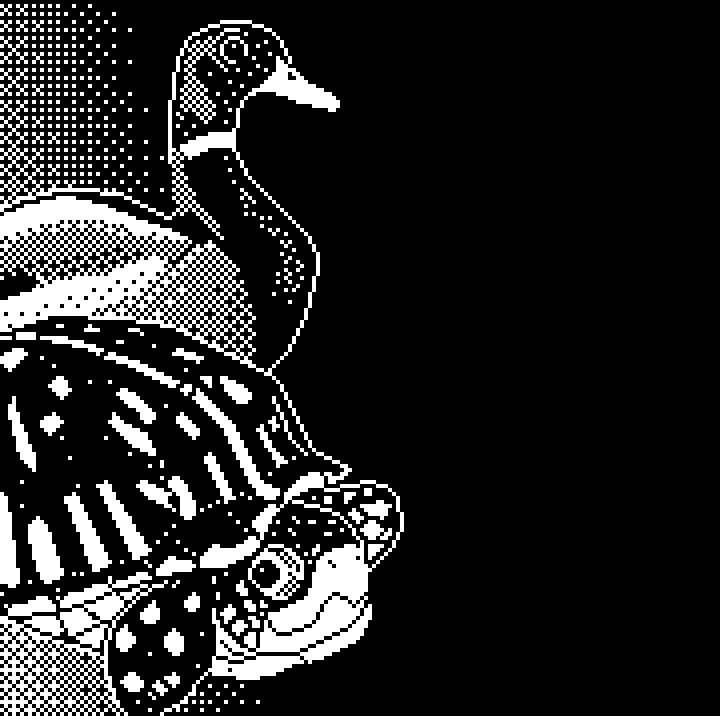
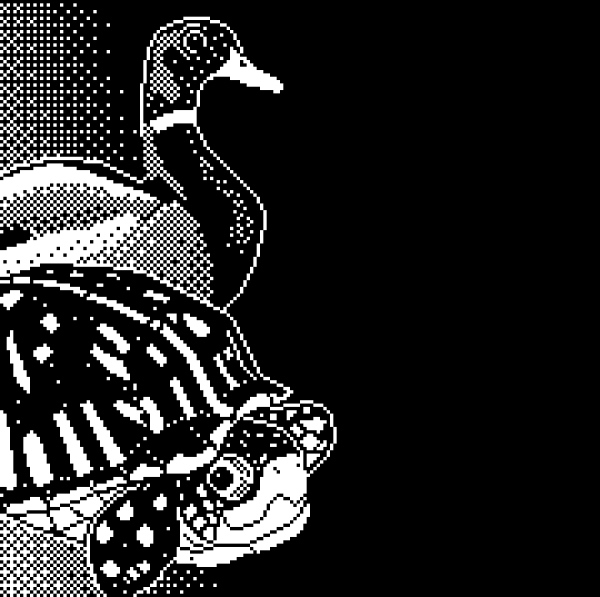
I use a phone with a square screen and recently switched to a minimal launcher. I like the launcher and appreciated being able to pare down the visuals, but then looking at just the white text on a black screen was too minimal. So I drew out this cute mallard duck and box turtle to liven up the screen. Very happy with how they came out and a great exercise in 1-bit techniques.
Update: I ended up using the image flipped on the phone because while I can set the menu on the right on the home screen, I can’t move it in the apps menu. But I am very happy to have put in the effort to add this to my phone!
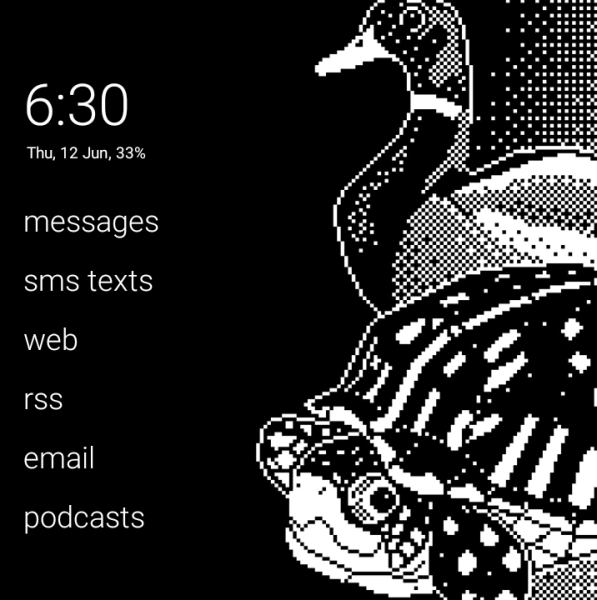
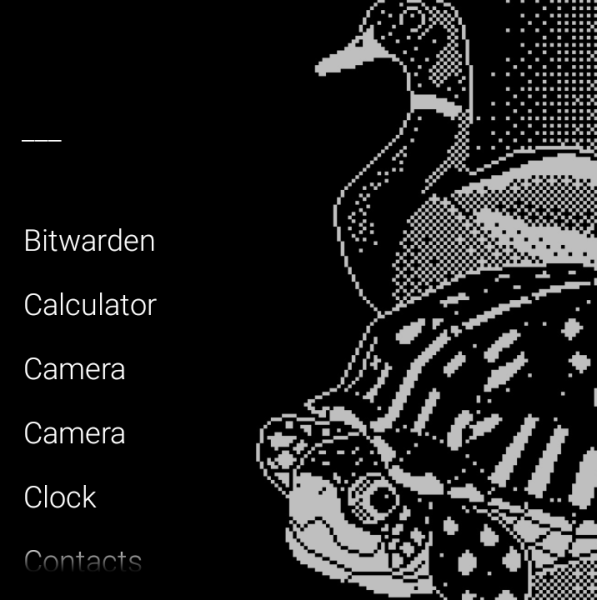
Look at these charming little guys
The SOLARPUNKS blog published a short little post about an IGA grocery store in Montreal that has a 25,000 sq ft (over half an acre) garden on the roof!
https://solarpunks.net/post/785808510802935808
This is a great model! I hope they do that with the parking lot next! You can even see it in satellite imagery!
We have just installed the window units for the summer before it gets too hot to do it without being frustrated (Though our second floor is warm already)
If you feel like you have to put “Reader Caution Advised: This post was written by AI and has a bunch of errors” on a blog post, just… Just don’t press the publish button then?
Nominations are open for the Tiny Awards, “[celebrating] the best of the small, poetic, creative, handmade web”.
If you came across a delightful website made in the last year, you should nominate it!
More info here: https://tinyawards.net/faqs/ #indieweb #webdev #webdesign
Also the Tiny Awards website is an absolute delight and you should check it out!
https://goodinternetmagazine.com/ Enjoying reading through. Looking forward to the print version!
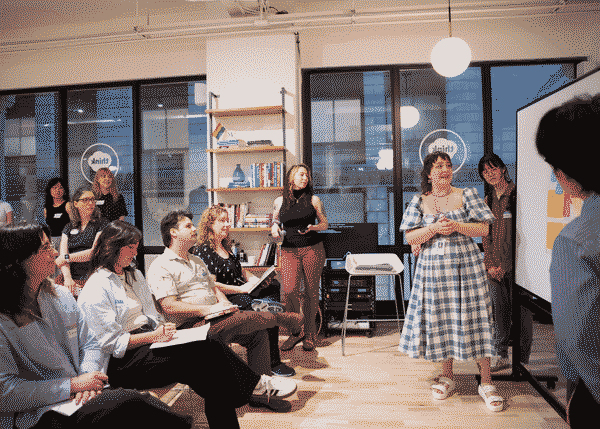

Last week was Philly Tech Week and I was asked to appear “on stage” at two events. For the Technical.ly Developers Conference, I got to host a series of presentations about technical obstacles and their solutions in three Code for Philly projects: Balancer, PAX, and Clean & Green. Later that same day I was asked to judge a Philly CHI design slam working on ideas for the frontend of another Code for Philly project, the Benefit Decision Toolkit. It was certainly a long day but it felt great to get to show so many people the genuinely cool projects we are working on.
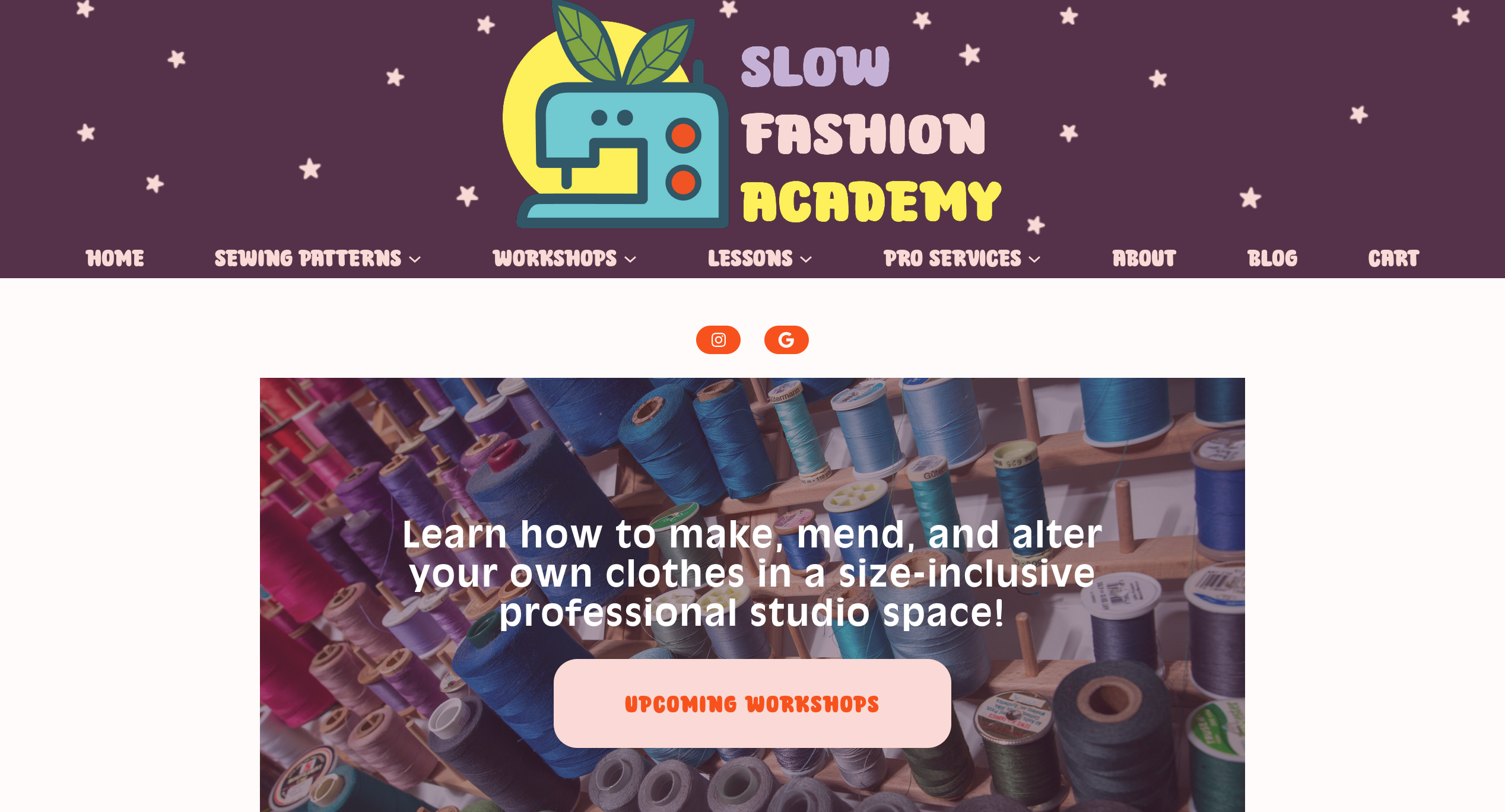
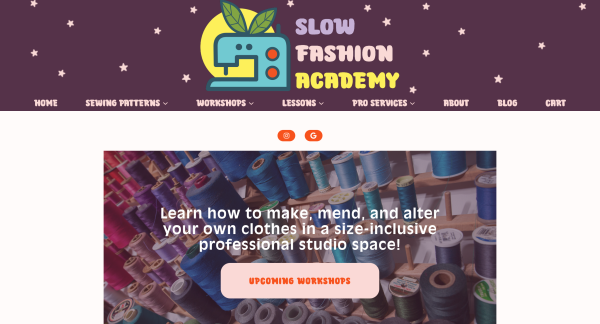
Ruby asked me to help her get her vision for a new website for her business up and running. I got to do one of my favorite web developer activities: She gave me some mockups and I worked for a weekend to make it happen.
The site is a WordPress.org site customized with CSS, a little JavaScript, and a lot of fiddling.
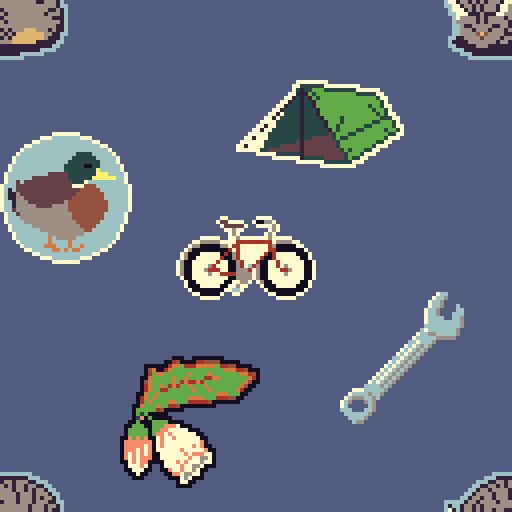
I have been maintaining this website for over ten years now. I love having my little space on the web to do whatever I want with it. For most of that time I was stuck on making it “professional” (read: acceptable to bosses). I have used colors I liked at the time and mostly very basic rectangles and images. This has even been true in the years since becoming a web developer.
Over the past year or so, I have found a lot of joy in the Indieweb, and its various principles that make the web better. The biggest for me being: Own your data. Ruby and I went on a whole data-cleansing trip this past winter. Though there’s certainly still more to do with that. One step in owning my data is putting my stuff on my site first; that this site is the source of truth.
I also wanted some of the cool Indieweb tools like webmentions, automated POSSE (Post (on your) Own Site; Syndicate Elsewhere), and microformats. Initially I started to roll my own server and lost steam realizing I spend most of my days maintaining websites and I just wanted a place to post. Self-hosting is a skill I’m currently learning, but will take me some time before I get there.
To get a pretty out-of-the-box solution, I chose to go with WordPress.org on some shared hosting. For a place to just post, this meets my needs, and there are some good plugins for the Indieweb features I wanted. I spent a lot of time over the past few weeks setting up Ruby’s and my new sites, and did a lot of learning (read: bashing my head against documentation) and the biggest lesson I learned is: WordPress is fiddly.
I am used to controlling and writing every line of HTML, CSS, and JavaScript (give or take a template or framework), so this was a challenge. Once I understood the order of what gets loaded when it got much easier. Mostly, both sites were CSS efforts. I do like styling in just CSS whenever I can, and I set out to have some fun with this one. Inspired by sites like ribo.zone and maya.land, I wanted to make some very weird, very me things.
I decided to lean into some of the things I have enjoyed in my life: maps, books, movies, and themed the pages based on those. I am most proud of how the About and Blog pages came out! I will definitely be revisiting a lot of the designs, especially in the showcase pages, and I need to really rework some mobile views.
I am also particularly proud of the little animated GIFs on the home page. They were very fun to animate! I would love to revisit those because I want the movement to be more intentional, but for now it feels a little magical and a little throwback-y to early web aesthetics.
I have been stepping away from some online platforms recently, mostly because I don’t like going to them anymore. So many have stopped being places to see my friends, and just become riddled with ads and slop. I do keep up with news and online happenings through RSS and newsletters mostly. That has been a huge improvement for my web experience.
I love the cool places on the web and hope that my site is becoming one of them.
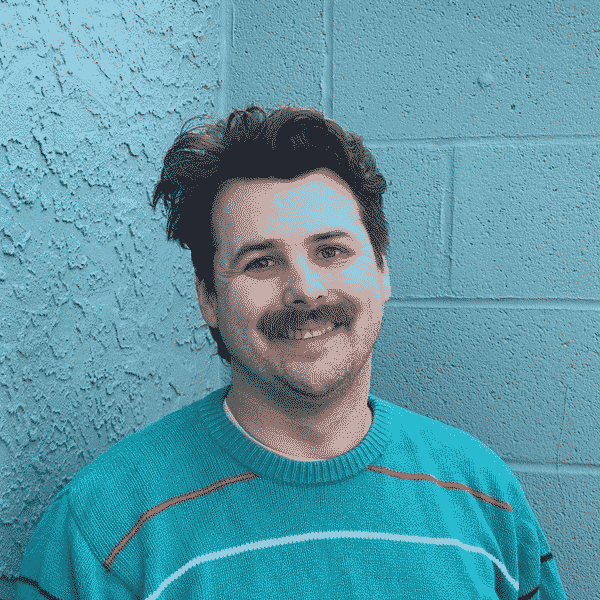
I started a new role at CLS at the beginning of the year. My previous supervisor, Nate, moved on to work at a new workplace, and now I am the sole developer at CLS. In fact, I am now a Senior Developer & Data Analyst. It’s certainly been an adjustment to be managing our projects, administering our case management system, and being my own project manager. But I am making it happen and have finally gotten into a groove.
I don’t think I’ll be comfortable with managing all these projects until summer (hopefully),n but I have found the rhythm of the work. Juggling projects and having many different things to work on is fun for me and thrilling, for better or worse. The projects themselves are often exciting for then tech they use, the topics they address, or even just being a satisfying new way to interact with an tedious task. I’ve been busy but not overwhelmed.
I’m also adjusting to the Senior in the title too. It certainly fits the work I’m doing and all of the tasks I need to keep up with to make the work happen, but I’m not sure yet if it fits me. Only two years ago did I start to feel solidly in the “midlevel” category. But I haven learned throughout my career that meeting the needs in the space is the work. A bike needs fixing. Data needs to be delivered to DHS. A spreadsheet has gotten too complicated and should be a database instead.n They need to get done, so I need to make them happen. Regardless of my feelings about new words in my title.
Over the last ten weeks, I have felt myself leveling up and it feels fantastic. Already I was grateful to have a job where I get to work on cool projects that help Philadelphians, or at least help our caseworkers help Philadelphians. Five days a week I get to do meaningful and autonomous work. A dreamy state for a worker. None of this is to gloat, rather to express gratitude and reflect on how I’m growing as a developer. I am genuinely enjoying this job and especially the work I get to do.
Last week, I was listening to Spotify for the last time. Already I was planning a breakup and starting to collect more physical and digital albums, but this particular session was genuinely the proverbial last straw. I had queued up a few albums while I was working. I had planned that when they ended I would wrap up what I was working on and go take a walk. But after the last album ended and the queue was over, Spotify had already loaded another album I did not choose into the “Next Up” section underneath (and separate from?) the queue. Because it was by the same artist as the previous one, it took me a few songs to notice.
I had had a plan for how I wanted to listen and Spotify overwrote that plan and overstayed the party. It all but refused to let me wrap up, sit back in the silence after the album ended, feel the music linger in me a moment, and then get up to take a walk. This is part of a pattern that has been wearing on me a long time, but I didn’t know the exact issue yet: Most contemporary media platforms don’t let things end.
I often have a slight tension with friends at a movie theatre about 30-60 seconds into the end credits of a movie. The sometimes-animated cast and highlighted crew names has ended and the white names and titles on a black background is scrolling up. My friends have all stood and have started to grab their things and I am planted watching the text scroll up and listening to the credits music. There’s a pause before we clock each others’ intention and plead with each other, first silently, then out loud to persuade the other to join us. My mom often points out that I have always been like this. That, long before blockbusters were doing end-credits scenes, I always sat through all the way until the final production card flashed.
For me, that’s a part of the movie experience. More for the soundtrack than anything else, but also because I was always fascinated with how movies are made and was genuinely curious what people worked on. It’s also a great time to sit in the context of the movie with your friends and talk about what stood out to you, good or bad, or just to process what you just took in for 90 to 200 minutes.
Watching movies and series on streaming platforms is such an obvious part of this “Don’t let it end” problem: As soon as the credits roll, they are minimized to a corner, a new flashy poster (or trailer in the worst sins) is put center stage and a 5-10 second timer starts winding up in the lower right corner. By the time you get a hand on a remote or keyboard, the next thing is already playing. The music and moment are interrupted and thrown away. Instead of reflecting on themes, scenes, or costumes, your brain has been hijacked by either the new movie or the “Oh wait, shit, where is the remote?” scramble. “The content is dead! Long live the content!”
YouTube and other video streaming platforms also have by-default autoplay. As soon as the video is over, you often aren’t even given a timer and are just thrown into the next video they clumsily recommend. With a playlist along a series or theme it’s one thing, but jumping from a quiet contemplation on the finer points of the 80s/90s Ninja Turtles Movies by Mikey Neumann to being screamed at about how Honey was a scam the whole time is horrifically jarring to put it mildly.
When I finish a book on my e-reader, Kobo immediately suggests the next book to read (often a sequel or thematically relevant), rather than just let me close it and stare out the window meditating on what I just finished reading. When you get to the end of the loaded posts on Tumblr or Reddit, the next page has already loaded for what is literally called “Endless Scrolling.” And yes, closing a tab, hitting the menu button, or putting the device down are certainly options. An even better option is turning off autoplay on everything you watch or listen with, but the default option matters. Also, please disable autoplay. It’s so much better this way.
We don’t have to design things this way. Granted, corporations are incentivized to keep people on their platforms for as long as possible to juice every last drop of advertising money and psychographic data out of each pair of eyeballs they come across, but even free software nonprofits like Mastodon or Pixelfed have endless scrolling by default. “Opt out” design for anything will almost always suck. Many people have no idea that some websites, apps, etc. even have settings, let alone thinking to change them. We as developers, designers, writers, and creators can design for a better experience though. And we should.
It’s okay to let things end. The album can end and you can sit while your brain finishes buzzing and you get up and do something else. The playlist of videos can end and you can look out the window, charmed by whatever you were watching. When the film ends, you can let the credits roll and allow the ending music carry you out of that world and back into your own. When the book ends you can close it, sit with the texture of the pages in your hands, process the themes of the work and look around you, with different eyes than you had when you started. It’s okay to let things end.
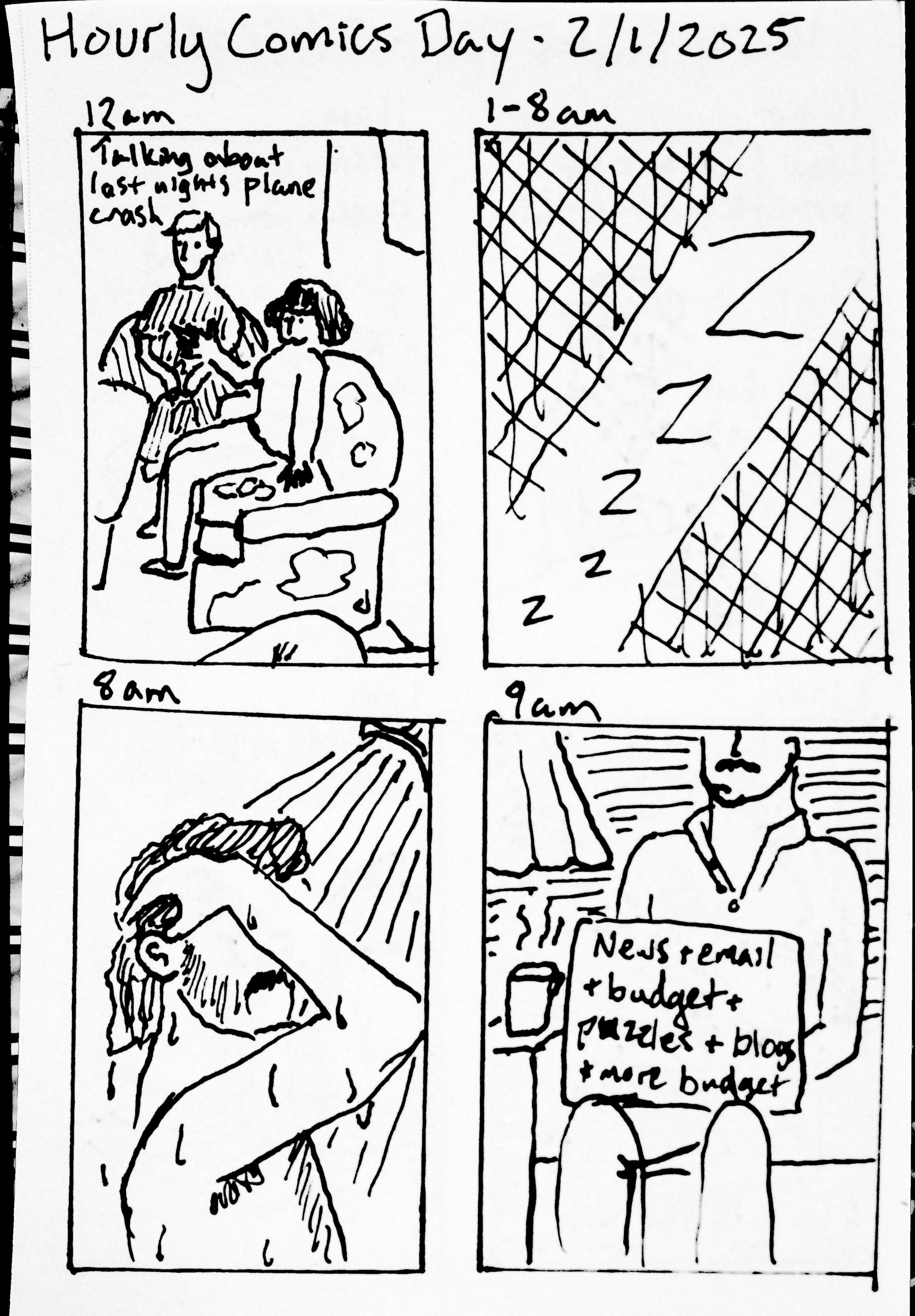

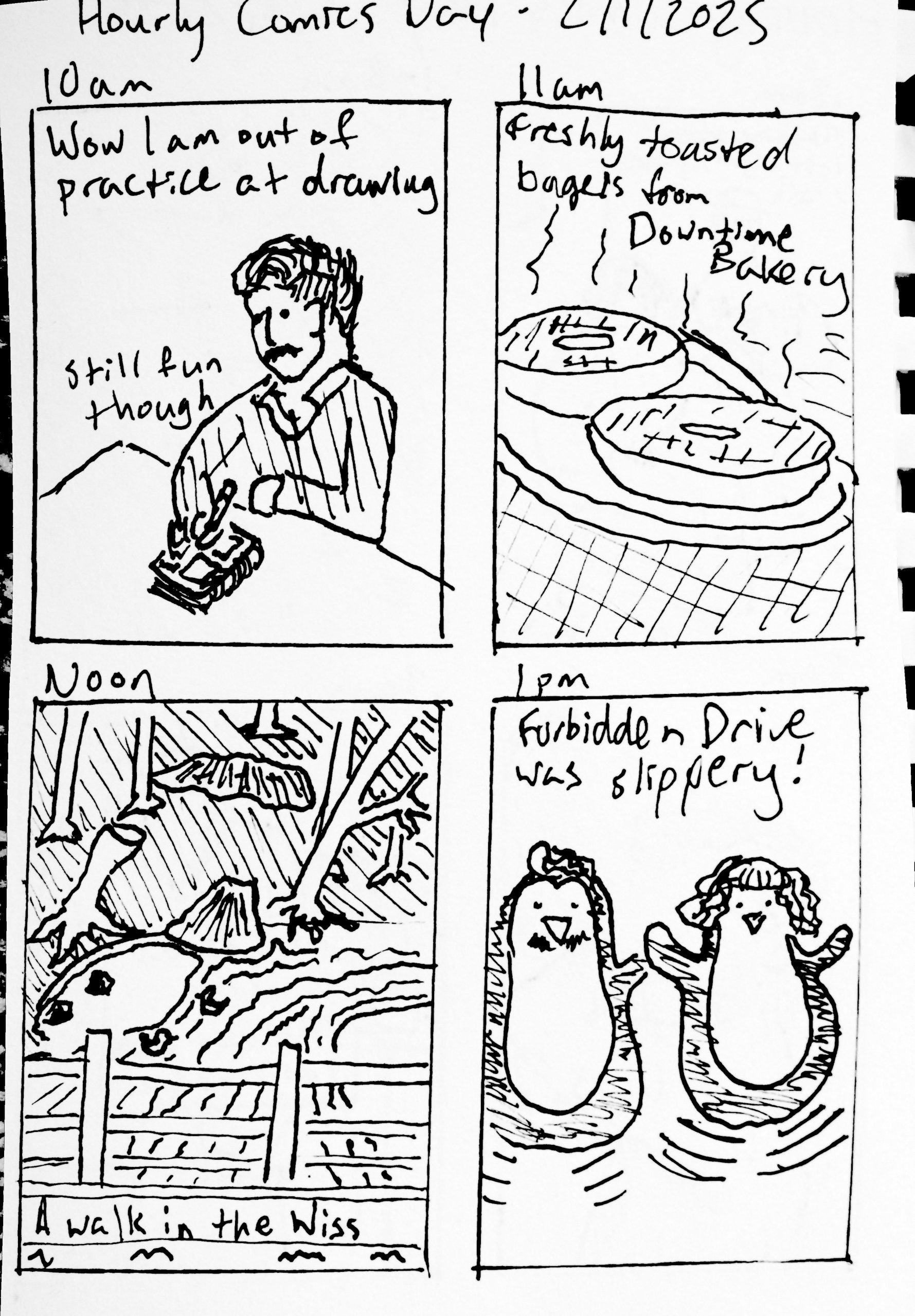
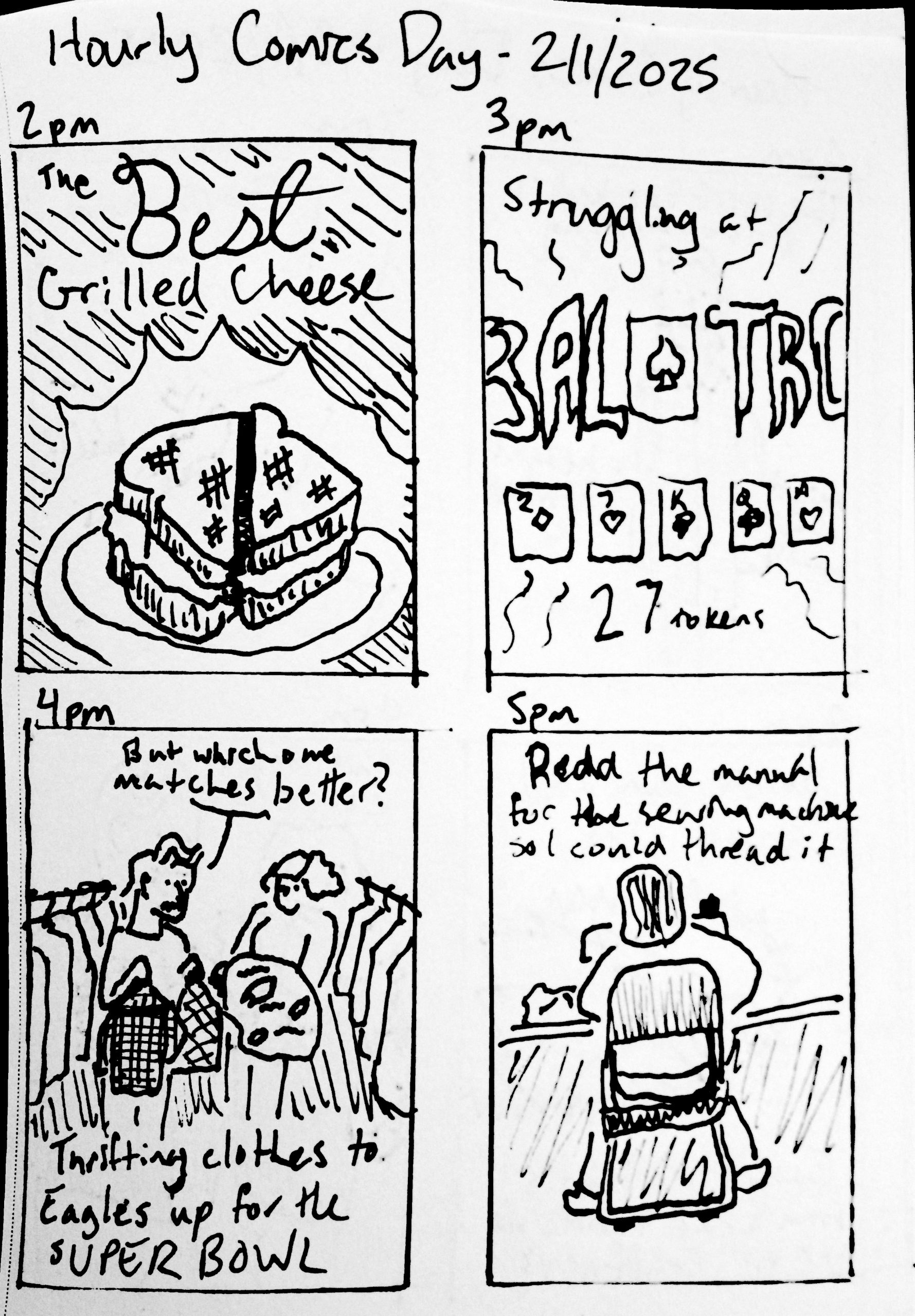
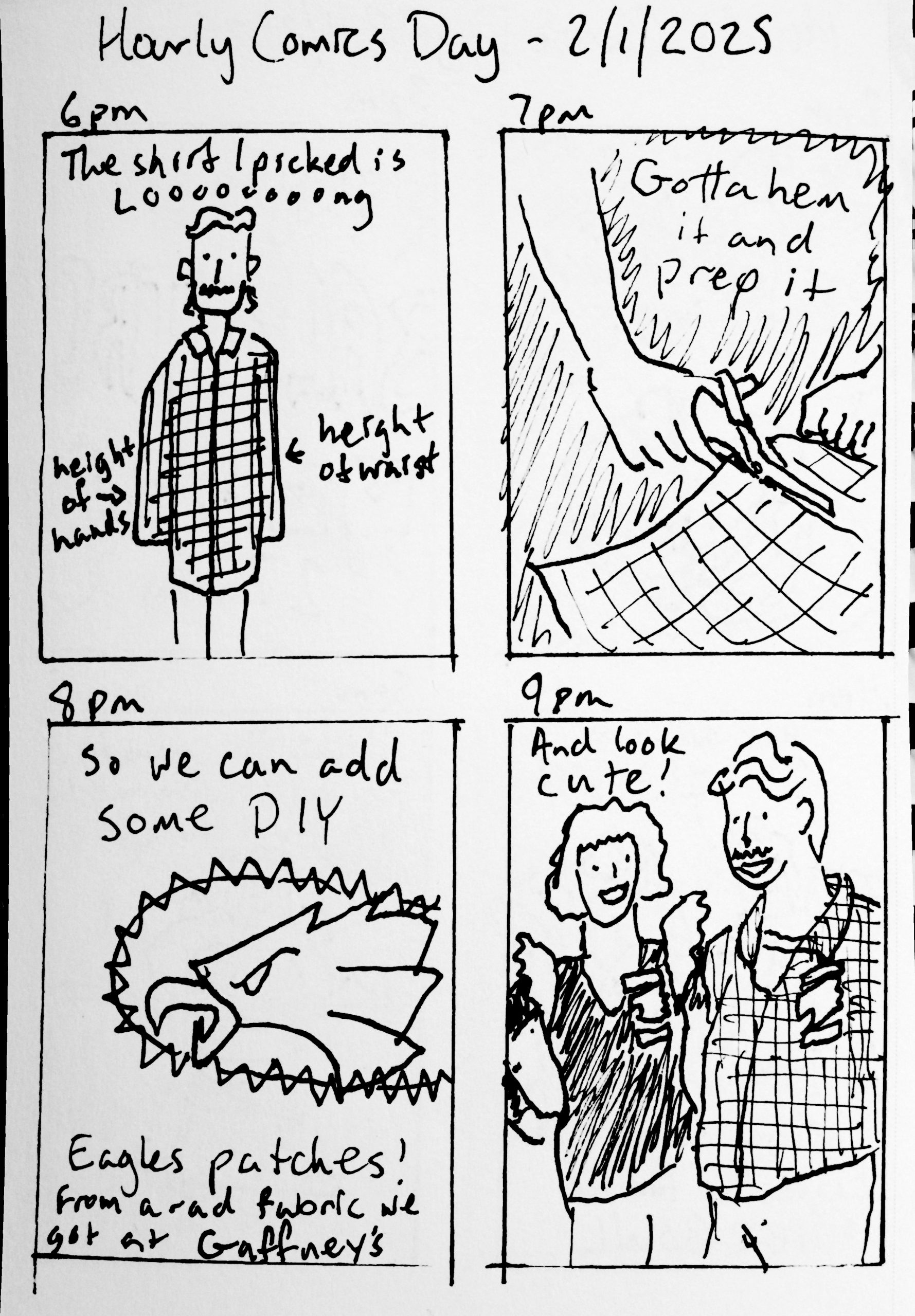
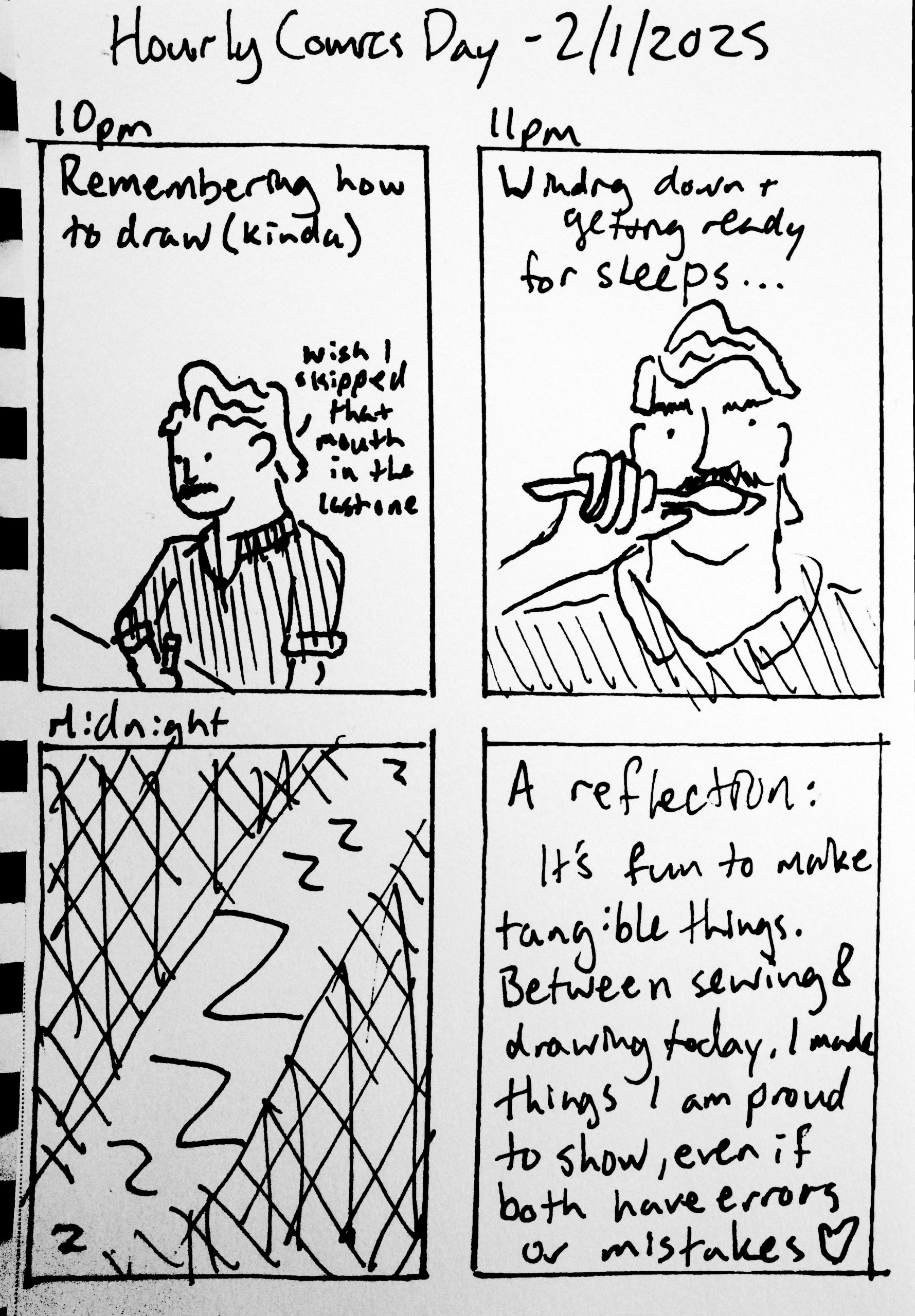
It’s fun to make tangible things. Between sewing & drawing today, I made things I am proud to show, even if both have errors or mistakes.
Community Legal Services | Philadelphia, PA
January 2025-Present
Working with the Development & Communications unit to deliver reports, data anaysis, and tools to the attorneys and paralegals of CLS to help them in their mission to to fight poverty, challenge systems that perpetuate injustice, and change lives through cutting-edge advocacy and exceptional legal representation. Projects are built with Django, Dagster, DBT, R, pandas, and LegalServer.
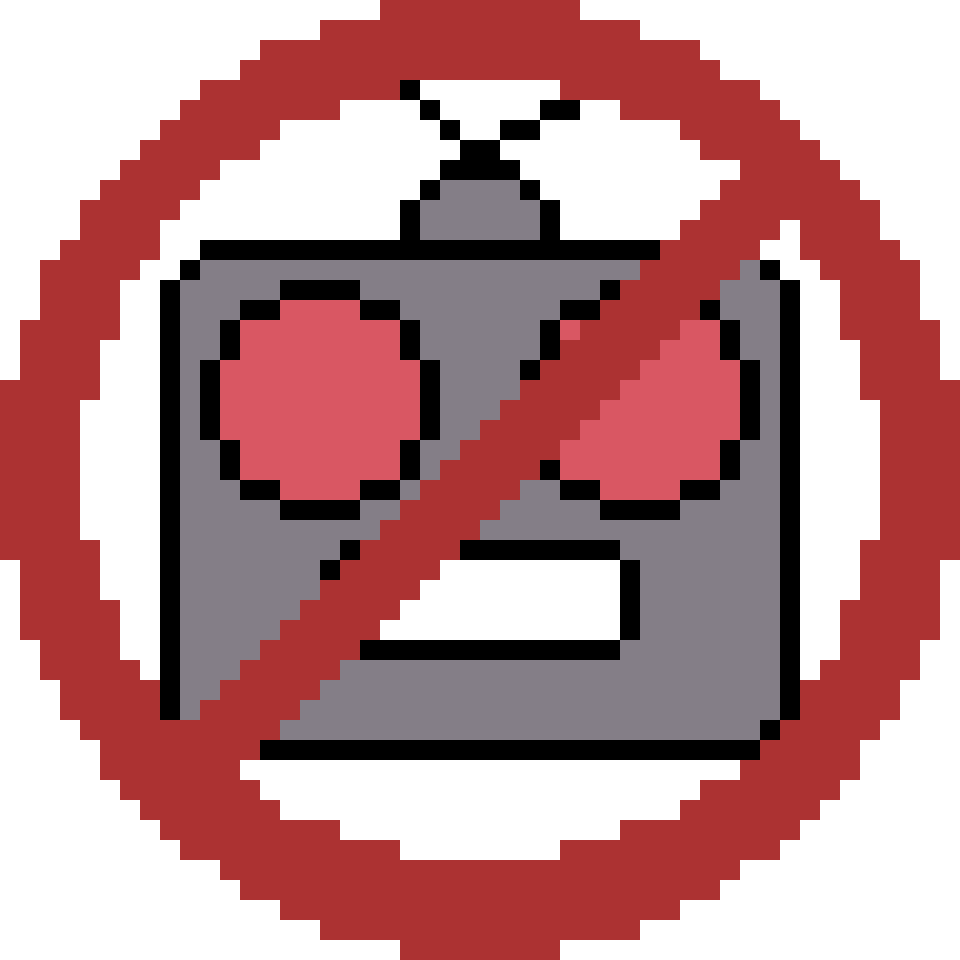

A 48×48 pixel image I made as the favicon for insteadofai.site.

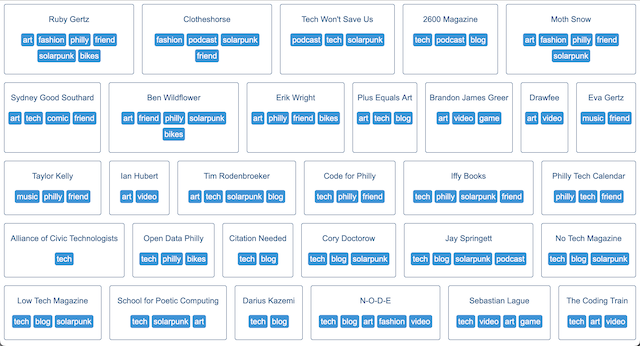
I have made a blogroll! This feels important to me as I try (along with many others) to build a better web. This was a project I have been meaning to take on for some time. I did start with a basic set of links to friends in the footer of my website, but I wanted to use it more to show the web I usually interact with.
I would still like to add a little flair and some organization to the blogroll page, but I am trying to build this website without delivering any JavaScript, if possible. I do think the current iteration could go into a noscript block and then go and implement the immediate method I am thinking of. I did spend quite some time trying to use a force-directed graph to help me layout the Venn-diagram-like design I was originally imagining. In this case, a “Done is better than perfect” approach had to be taken.
The web has become less magical. There is a lot of evidence pointing to search engines largely getting worse and nigh unusable and the state of the web (as most people use it) has become “five websites, each consisting of screenshots of text from the other four.”
I remember the web feeling very magical and largely found the best websites from word of mouth from people I knew. The exception to this largely was finding webcomics from the footers of webcomics I was already reading. Many of the comics I was reading would have a “My friends” section with links to their comics. Even then that felt very powerful and community-oriented, but as discovery and recommendation algorithms have dominated those five website we go to, that kind of list feels almost transgressive.
Facebook and Twitter both punish users for linking to anything that’s outside their walled gardens. Instagram only allows for one external link per account (the famous “link in bio”), which has led to services like Linktree because of course we all have more than one link to share. But these are all platforms where, if you were to be banned, you would lose access to everything if it was the only place you kept your photos, videos, jokes, etc. Or the site may have a catastrophic data failure and lose everything.
The method I have appreciated for avoiding getting shut out by some billionaire has been POSSE (Publish (on your) Own Site; Syndicate Elsewhere). I post blogs, art, and projects on my own site first, then share them to social media I use. Having your own website is a way to have aesthetic control over your own space as well! Almost none of the large platforms allow you to customize your page with more than a profile picture, banner, and MAYBE a highlight color. But those aeshetics matter. They help set us apart, express ourselves, and signal to others that we may be aligned just on sight.
Making a website can certainly seem daunting. You don’t have to handcraft code for a website (though it is fun, and I like it myself). There are many WYSIWYG (What You See Is What You Get (pronounced wizzy wig)) options out there from the big corporate spaces or more indie spaces like NoBlogs or NeoCities. In an increasingly online space, having your own little place to call your own feels more and more necessary. And if you want to jump into the deep end, you could learn to code and also how to self-host a website in your own home.
We all have cool businesses, practices, hobbies, and more that we would like to share with others, so we should have control over how we present that, and how we connect to each other. So please, build your own sites. Make them how you want them (which may include making something crazily maximalist, go for it), and link to your friends and the people whose work you like most. The Indie Web is already a growing movement and there’s some great things being built. The future of the web is many more small connected sites each with cool, niche, resource-rich pages.
Edit May 3, 2025: This was initially written with the word “webring” instead of “blogroll” but they’re not really interchangeable, though I thought they were at the time.
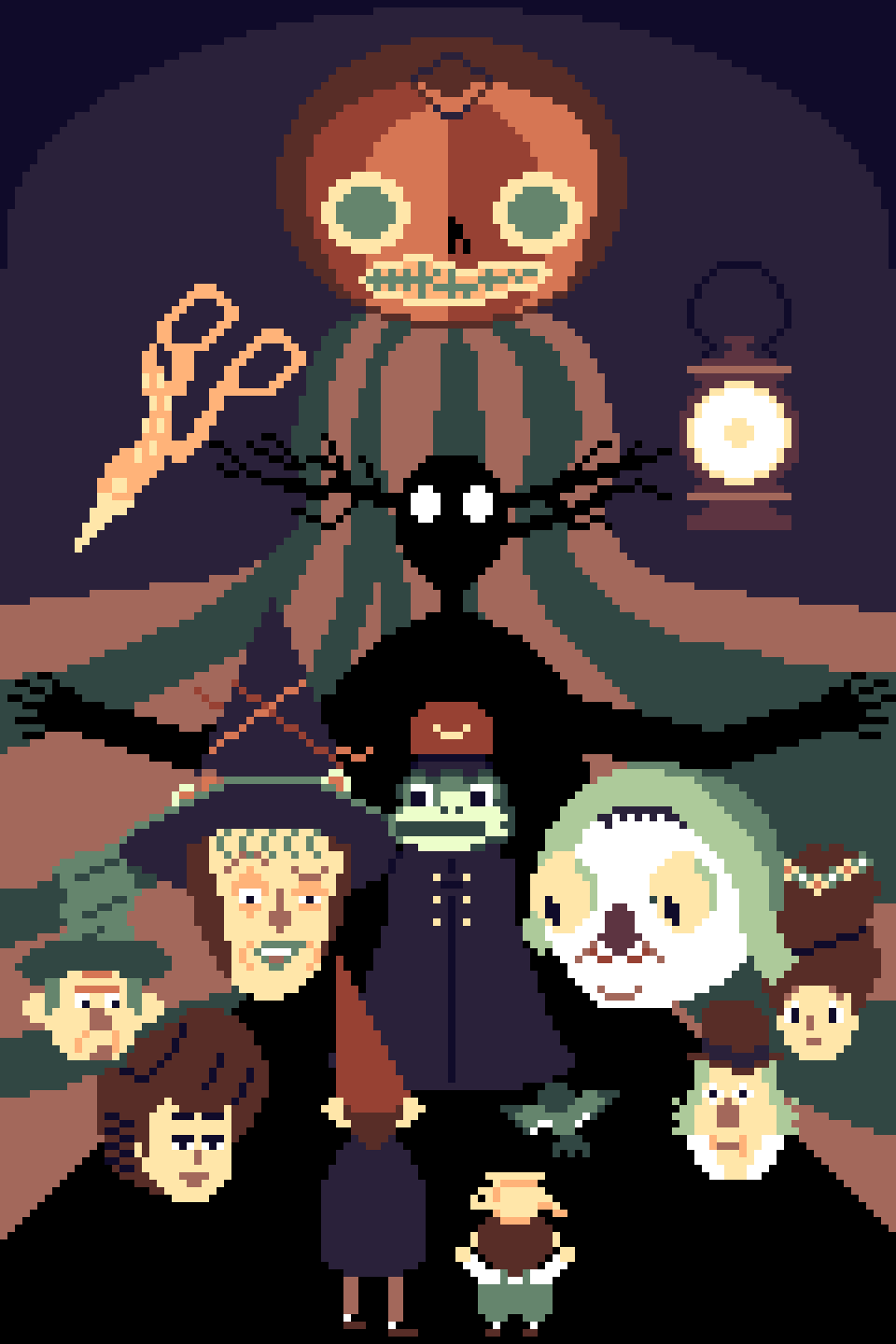

Very excited to watch Over the Garden Wall again with some friends! This is easily one of my favorite pieces of media in general.
It is a wonderful piece of Americana and plays with nostalgia in a delightfully bittersweet way. Beware the beast!
This piece was a little more of a challenge with wanting to use a 1-point perspective and shading, but I am happy with how it came out! I used a great color palette by Pixel Hoo!
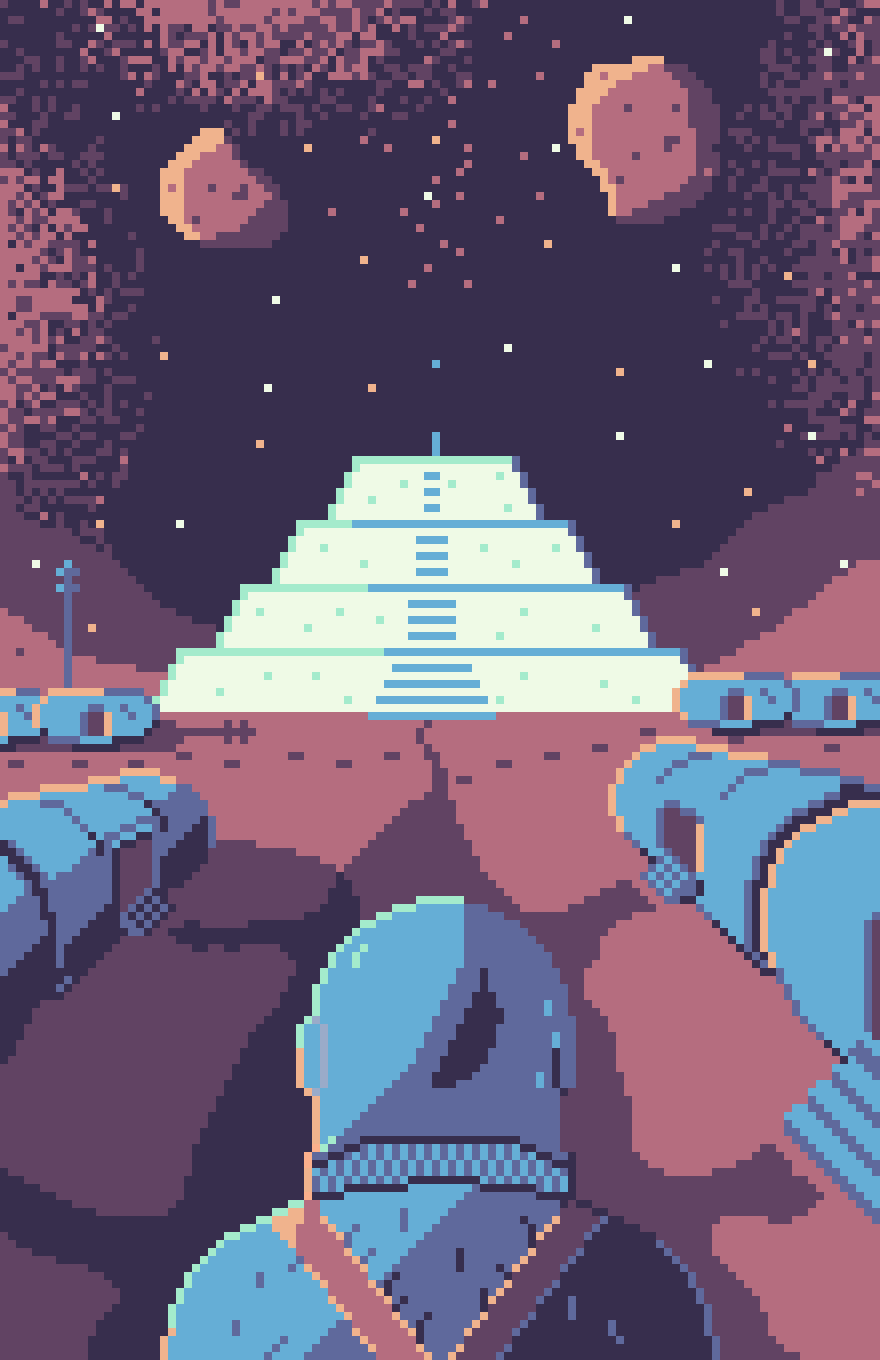

I’ve been reading the Mars Trilogy by Kim Stanley Robinson. I’ve been loving these books and flying through them. This was how I imagined the initial settlement, Underhill, with it’s barrel-shaped shelters and giant salt pyramid.
I also read his more recent The Ministry for the Future, which I would highly recommend for some great speculative fiction on addressing the climate crisis.
This piece was a little more of a challenge with wanting to use a 1-point perspective and shading, but I am happy with how it came out! I used a great color palette by Anubi!
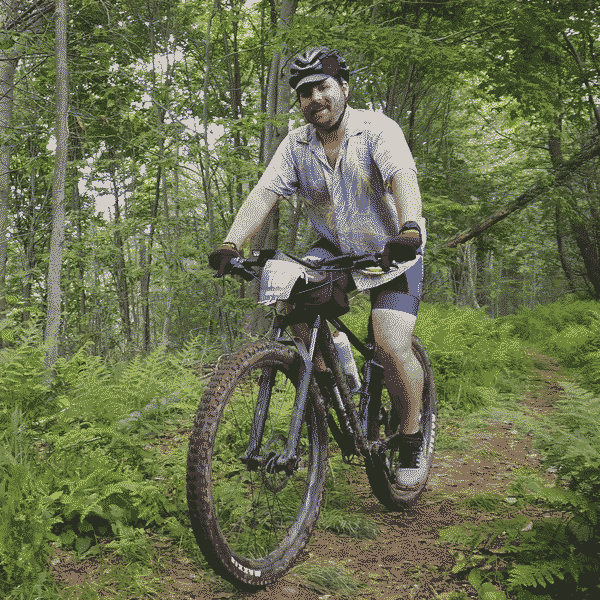
After reading a blog post from Andrew Dana Hudson about thermochauvinism, I have begun referring to July as “Hot Winter,” a time of year when I spend most of my time indoors because it is uncomfortable and even dangerous to be outside. I tend to spend my free time similarly to actual winter: video games, home DIY, reading, taking care of house plants, and wishing I could ride my bike or work in my garden.
As soon as the heat broke last week I went out and went on a longer mountain bike ride than usual. It felt wonderful to be out on the trails, using my body, and just gazing at water, birds, and plants. Riding a bike is almost always just a shortcut to feeling better for me. Physical exertion and fresh air do wonderful for my dopamine producers.In the first week of June, I rode with a friend on Grinduro PA, a 70(-ish) mile gravel and single-track ride in and out of Loyalsock State Forest. It was a challenge but I was pretty in shape for it, though I could certainly have used more training on climbing specifically. It was a great time and worth doing if for nothing else than reminding men I am capable and enjoy days where “all you have to do is ride you bike” as one of my Bike & Build teammates puts it.
Having done that ride towards the start of the summer has been good for me in riding casually afterward and having a recent difficult accomplishment to compare against when a ride or section of a ride starts feeling like a slog. I have also been feeling this in my day job lately. Getting stuck on a particular issue and struggling to find a solution, but pushing through with memories of solving past tough problems or errors and remembering the satisfaction of having beat those.
That is such a hard thing to overcome when working on any project: A problem without an obvious solution and little findable community support. These are awful and can end a project without enough skill, motivation,n or some combination of the two. I have always struggled with asking for help and been too stubborn with myself that I can definitely find the answer on this next search around. Luckily I have great colleagues and peers who are happy to work through a problem with me.
For other developers (or anyone working on any shape of project): Please ask your peers, community, and colleagues for help. Your project is worth completing or at least worth getting to a proof-of-concept well enough to know it’s worth abandoning.

Maintenance and repair are essential to a more sustainable, and frankly pleasant world. Well-maintained bikes feel, sound, and ride better. Well-maintained roads are easier and safer for everyone to navigate.n Well-maintained gardens look and smell better and are more productive. Maintenance is boring and tedious though compared to starting fresh. Repairing a broken thing is harder than repairing something regularly maintained.
What I particularly find difficult is perceiving that something that has gradually worn over time is at an optimal time to repair. A squeaky bike chain is past time for cleaning and lubing. A thirsty throat is already partially dehydrated. Those are easy fixes though usually, and if you already have the supplies,n nearly instant repairs to make. What’s harder is seeing pants wear out, masonry decay, or street markings disappear. Some of these need specialized skills, licenses, or interaction with government. These take more time and care and sometimes convincing the maintainer it is the time to make that repair.
Especially in the case of city, county, or state infrastructure, convincing the city, county, or state that the time has come to make a repair can be a herculean task. Often the “We can’t afford to do it now” excuse leads to putting off the repair, only adding to the cost. We see this in health insurance plans as well,n where the insurance companies refuse to pay for preventative healthcare, leading to suffering, and often more expensive and more painful medical interventions. Typically, if you can’t afford to make the repair,n you definitely can’t afford to skip the repair either.
I am currently thinking about this because of reading the great work by iFixit, Cory Doctorow, and others in the ongoing fight for the right to repair our own things. But also because my house does need a masonry fix, and we have some bikes in our house past the need for some regular maintenance that I have the skills, but haven’t made then time for yet. The longer I wait on any of these, the harder it will be to get those things back into good repair (and the more expensive it will be).
For example, I was letting a bike chain stay squeaky for a little too long. Part of this was not noticing until I was leaving for work and not wanting to take the time to take care of it so I could get to work faster. But then I would just store the bike when I got home and not pay attention til the next day riding out again. I managed a bike shop for years and certainly know better, but it is incredibly easy to just let those little things slide. We tell ourselves “It won’t hurt that much really.” But that does build up over time and effectively shortens the lifespan of the chain, meaning I may have to prematurely buy a new one.n Grand scheme of things, it won’t cost that much, but over the lifetime of the bike (I plan to ride that thing forever), I will likely spend more on chains than I would have to if I was keeping it regularly lubed and clean. (I recommend every two weeks, 100 miles, or rainy ride, whichever comes first) And once I did lube the chain, it was easier to ride!
In Pennsylvania, due to some large federal money coming in, we are finally making some long-past-needed repairs on bridges that have been failing evaluations for years. These repairs are far more expensive than if we were doing regular maintenance on them. But like I said above, maintenance is boring. New bridges are exciting.n Or novel ways to repair a collapsed highway bridge in less than two weeks when it also took two years ton fix riverpath bridges with smaller repairs or more years than that to update then same highway.
In a recent piece of art I made, I expressed that it will be better for everyone to own their own home, but with prospective homeowners in Philadelphia needing an annual income of $75,000 to be able to buy and keep a home (including maintenance costs), that means that the 50% of Philadelphians who make less than $57,537 each year just do not have that as an option. Housing costs must come down. Homelessness is a policy choice. Repairing that worn-out spot of our society will certainly cost us so much more than if we had always ensured people would be housed and fed, but it is still a necessary repair.
Maintenance is boring and tedious but essential to a more sustainable and more pleasant world. We constantly feel as if we can’t afford to make the repairs, but we definitely can’t afford to skip the repairs either.
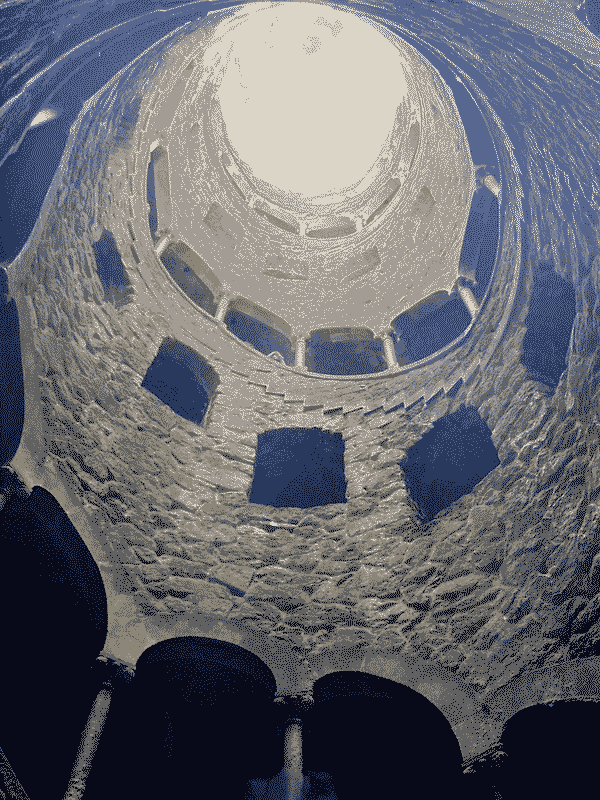
Recently returned from a ten day vacation in Lisbon, Portugal to celebrate my mother-in-law’s birthday. This is the longest trip I’ve taken since Ruby and I spent three weeks in Ireland for our honeymoon in 2022. Wen stayed in a cute apartment with a garden and walking proximity to the city center. In and around Lisbon, wen were able to walk and ride trains and busses to most of the places we wanted to visit and that was such an great way to get to know the city. Any time we took a cab or ride share, I would very quickly lose my sense of space.
We visited a few places like Sintra National Park, the Oceanarium and even some of the airports we flew through where having a physical map would have helped. Since my dumb phone only works in North America, I brought my iPhone I used to use with me ton make sure I could communicate easily with my travel companions. So I had access to mobile map apps, but those maps do not often have the context needed to navigate from one airport terminal to another. Each of these places had some sort of “you are here”-style map that I could take a photo of and reference. But trying to pinch to zoom to find small features in a photo of a map taken through glass is a rough user experience to say the least.
The Quinta de Regaleiran palace and ground had a QR code with a PDF map that was much clearer to use but still had the pinch to zoom issue of zooming in to see small things but losing the overall layout. What I really wanted in each of these circumstances, was an theme-park-style paper map that would give a sense of scale for the places and provide place-specific context for where to find restaurants, features, toilets, and transit routes. Near the Sintra train station one kiosk had these displayed but was closed so we couldn’t grab one.
Great maps like these were regularly posted around on small billboards but were unavailable to carry. And yes, handing these out by default to every visitor to a place would create a lot of waste since not everyone is a map nerd like me who will frame and hang maps on their walls. But having these available to visitors by request or purchase would be a good compromise.
Having a paper map in a park or region really adds to the sense of exploration that many tourists and visitors want to experience. Of course, most places are set up with a plethora of wayfinding that means moving around is more navigating than exploring uncharted territory, but the place is new to that visitor son the feeling is still one of exploration. Filling out the map in their mind by connecting their understanding of the symbols on the map with the physical features in a new-to-the-visitor place is a satisfying experience.
The City of Philadelphia recently reprinted an updated bike infrastructure map that they stopped printing in 2015 or 2016, and having a new tangible map of then city felt so special and I was so excited to see it in my local bike shop. One of the owners knew I would be excited by it and set one aside for me. I have a strong mental map in my head of our bike lanes already (complete with my own (sometimes snarky) notes and updates), but having that map to look at, point to, mark on, and show guests is such a valuable asset.
Making a good map is hard, and like drawing anything else, the choices involved in what to include or omit are daunting and require expertise of the thing itself and the experience of viewing that map or drawing.n What features, colors, icons, etc. will all also vary depending on who the map is for. The best map of an single place will be incredibly different for a tourist, a courier, or a telecommunications engineer.
Maybe its just because I use a dumb phone now, or maybe I have always been this nerd, but I really value having a paper map to walk around a place with to navigate and also as a tool to enhance my mental map. I’d like to make more maps for fun, especially something in the realm of the Philly Bookstore Map or theme park maps of neighborhoods. I would especially like to learn to design maps for print. I have experience designing maps for the web, but recently learned how much harder it is to design a static map since you can’t click an icon on a paper map for more context. Do you know any good map design books?
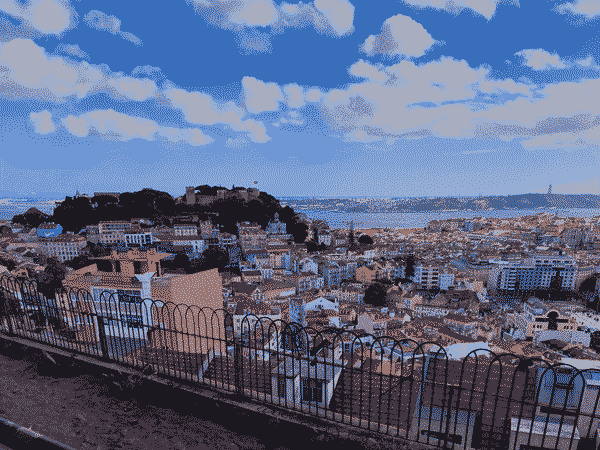
Over the past few years, I have been taking in a lot of Solarpunk influences. Solarpunk is a movement/genre/aesthetic/practice based around ultra-sustainability, averting climate climate catastrophe, and community-centric social organization that has been growing and evolving over the past 15 years, largely starting in Latin America, and I first came across it with Andrew Sage’s “What is Solarpunk” video and got such a craving for more things like this.
Already, I had been looking for more art and literature that makes sustainability look desirable in an way that wasn’t just corporate greenwashing, but also wasn’t just the cottage-core fantasy or the machismo-filled bushcraft stuff. I read a lot of dystopian fiction as a teen and young adult, and like many others, I tired of that sort of imagery being a warning and co-opted by venture capital funded companies. I wanted something that could actually serve as both a cultural escape and as a playbook of how to improve our odds as a society against climate damage, rising fascism, and increasing apathy in the face of both.
Solarpunk has already been included in greeenwashing campaigns of corporations and is often reduced to “glass towers with greenery poking out,” but is, and can be so much more. I enjoy reading Solarpunk books liken Walkaway and Inifinite Detail (both of which have excellent playbooks for decentralized,n community-based living) as well as art when I can, but I am especially interested in trying to incorporate as many of these things into my daily life as I can.
Of course, I would love to stick solar panels and a battery on our house and retrofit it to be as sustainable as possible, but that is expensive (to do quickly) and there are smaller things to make life more sustainable like remembering that “reduce, reuse, and” are the words that come before “recycle”,n repairing whatever I can, and only buying new things when I need them. In finding a new aesthetic, many of us (Americans, especially) are drawn to throw out our current possessions and buy the starter pack of then New Thing™. Typically, the answer to “what is the most sustainable ___?” is “The one you already have.” Of course, if the object in question is a fuel-hungry thing that creates a lot of waste, that may be worth retiring and replacing.
Ruby has taught me a lot about repairing clothes, and I know how to maintain our bikes and some parts of our house. But, I have been recently trying to learn more about repairing electronics like my early 2015 Macbook I bought used from an previous employer and I would love to migrate this website from GitHub Pages to my own device in our home. Even as it is,n using a static site that delivers a few kilobytes per page is far more sustainable than serving gigabyte-sized packages for websites made of mostly text.
Like many things, living sustainably is an iterative process and we all learn more each day. Even as my own work is influenced by it, my interest inn Solarpunk is less trying to look a certain way, but rather how to behave. I certainly don’t claim to be doing this perfectly, but I aspire to it and am currently slowly transforming an empty lot by our house into a garden/pocket-park, learning to repair electronics and clothes, and engaging my local communities in these as much as I can. What small, slow progress are you making?
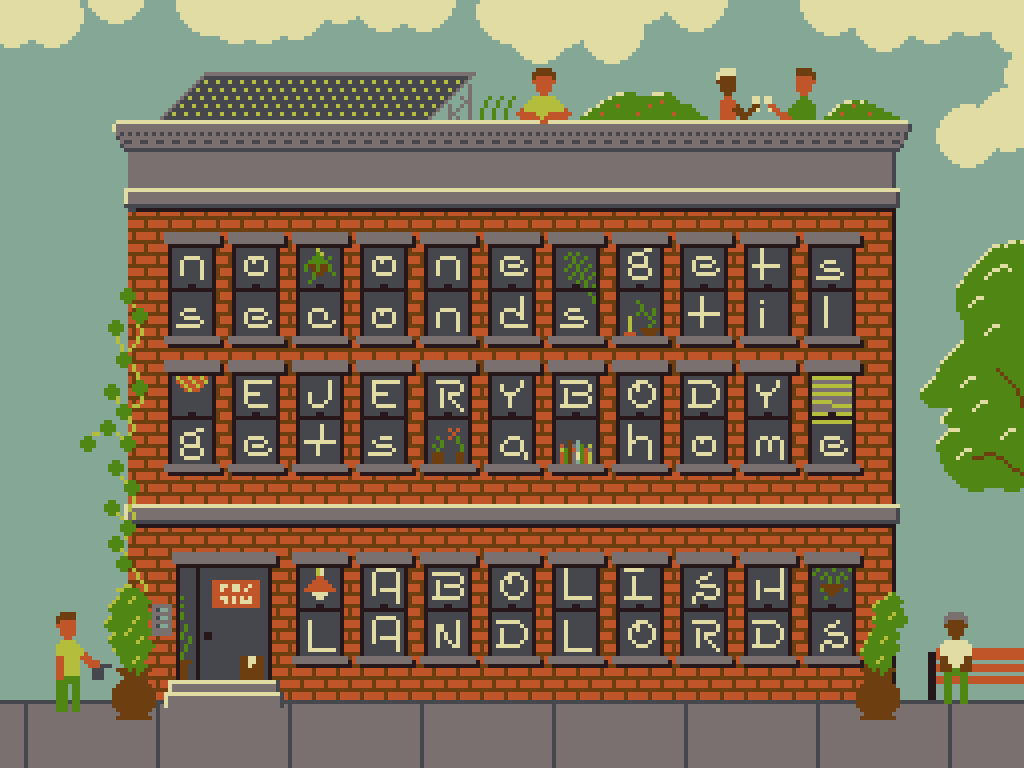

No one gets seconds til everybody gets a home. Hunger and homelessness are policy choices.
This was a fun piece to work on and I was happy to have found a great n color palette by polyphrog to make this with! It was a great study in making some low-res people.
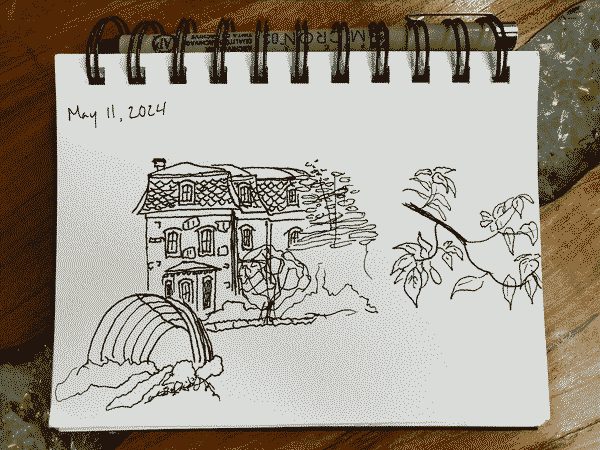
I have been sketching lately. Mostly sitting in a place and drawing a building or plant within view. Some of these sketches are better than others, but these sketches are mental exercise more than making final pieces. In have been wanting to get back into making more art, whether pixel art like I have on this site already or more algorithmically made works. So sketching in this case is to help me understand what shapes I am seeing and thinking about them and what details to include and not include when trying to render something.
These have been fun to work on and it has been serene just spending 30-60 minutes sitting and just observing then details of one object in the same space as me. An object I might glance at regularly but not really take inn beyond a quick glance of “That’s pretty” or “Huh, neat”. I have been trying to notice regular patterns inn texture and struggling to render irregular stone wall textures.
A lot of this process is frustrating and hard, but I keep doing it because it is ultimately very satisfying ton see the drawings come together. A large part of that satisfaction comes from the drawings being tangible objects with many flaws and irregularities. I was reading recently about adding more irregularity into our websites. As I mentioned before, rendering irregularity into something you want to be clear and read well is very hard, and something I struggle with personally. All the same, especially with appreciating these textures in the sketches and the subjects I’m sketching, I want ton start trying to add these qualities to the sites I build. Especially this site, since ultimately this site is meant to be a reflection of my current work and skills.
A few months back I introduced new fonts to my portfolio site, something I chose for looking more like text hand-written with markers or pens. I would like to add some more hand-drawn qualities to the site, but doing this with CSS alone is tricky as far as I know now. I will try to do some research and see what I can find because I think having a rougher, textured web with some human fingerprints on it will make it more friendly ton us, the humans.
In the past years since going from working as a bicycle mechanic and working every day with my hands directly touching the things I was working on to now, where I manipulate abstract, intangible things through a keyboard and mouse, I have found a new desire to make tangible, physical things. The sketches are part of this, but In also want to make some “final works” that can be touched, felt, heard. Some of this desire has gone into my garden and the empty lot behind our house I have been caring for with some neighbors.
Creating and working on tangible things is important to me and my well-being, especially as my professional and volunteer work both involve manipulating digital objects. Wrenching, planting, drawing, watering, painting,n sculpting, sweeping, and pedaling will all be incredibly important in keeping me happy. One thought that comes up is that my roles at work and at Code for Philly involve building community, connections, understanding, and empathy; none of which are tangible but all are vital in making our city a tangibly, perceptively better place.n Rough edges and all.
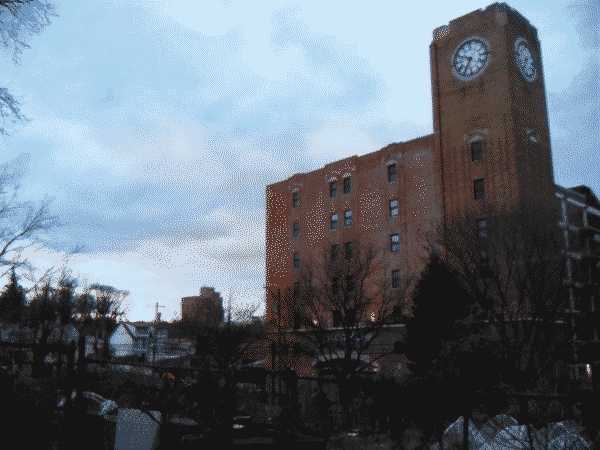
Despite a very full schedule leading up to the Social Justice Hackathon, I have been really enjoying springtime this year. Some warm days where we were lucky enough to be able to clear out a lot near my house that had previously invited dumping.n But also some last cold days that threatened this year’s early cherry and magnolia blossoms, but was gentle enough to leave them alone.
Part of enjoying spring has been trying to change some habits this year. The tl:dr; is that I severely cut down on phone time by switching to a phone that is extremely limited: It only does calls, texts, music, podcasts,n directions, notes, and a hotspot. This has helped to let me use my time better and be more intentional inn spending time.
For the past 8 years or so I have used some shape of iPhone, and even for about 3 years before that I used some odd smartphone or other (often something I found cheap enough at the time). Until my first bike shop job, In would just let every notification bubble up to the surface on both my handheld and desktop devices. Every social media like (or worse just those “Your friend liked a thing you may like” ones that should not be an notification).
I mention the bike shop job specifically because I remember the moment it was pointed out to me that every time my phone buzzed I looked at it, even if I had just put it down a moment ago. Once it was pointed out I noticed it each time: the weird habit that now seemed so strange and obviously time-consuming. In started by turning off any “like” notifications and just leaving messages and comments for the social media In used at the time.
But of course, each new platform and client has its own settings. So moving to one or starting a new one means going through settings and unchecking almost every box except the ones that were about people specifically reaching out to me (you know, the actual social part). I have historically always turned off all notifications off on laptops and computers since they are the same as the ones popping up on my phone.
I thought this worked pretty well for a while, but then I noticed another weird habit I had: In a moment of boredom, I would just open Twitter and scroll two thumb lengths and stare at the screen for a few minutes, close it, then do it again. I also would do this for Instragram, just opening it and not really taking in anything about current events or my friends’ lives. I would just scroll a little. In thinking about it now, the motion is not that different from using a worry stone.
I tried deleting those apps from my phone and using the web-browser versions instead which did an okay job cutting down on scrolling, but not really enough. I was still spending hours a day doing that and would really prefer to spend that time doing something else. Nothing specific, but just more active and intentional (or inn some cases, sleeping). Ultimately I deactivated or deleted my accounts on each of those and really only use Mastodon for social media now.
I do love short-form video (RIP Vine) and I tried Tiktok for a few days but recognized quickly that it was an genuine attention-sink and that I could not handle that so it went away quickly. I do still enjoy YouTube and want to keep it (or at least the videos I regularly watch there), but the Shorts feature also just sucks hours from a day. To help my time, I use a browser extension to completely remove Shorts from the site.
One of the biggest changes has been switching away from iPhones entirely and using a LightPhone 2 which has an e-ink screen, and can only do calls, texts, music, podcasts, directions, notes, and a hotspot. While they are improving it a lot regularly, it is a little rough around the edges, though I kind of like that. It does not do email or web browsing so that is now just something I do exclusively from a laptop.
Without having social media or scrollable media on my phone I find myself reaching for it less and haven taken to carrying an e-reader with me loaded with at least one library book. In the past three months I’ve read more books than I did all last year. I also find myself listening to more podcasts and music when I want some stimulation.
The podcasts app works like most: subscribe to shows, download or stream as they come in. The music app is much more like the early days of mp3 players: Put the tracks you want into a playlist and upload them. I tend ton prefer listening to albums so I added a bunch of digitized albums I own into the phone and have been enjoying that. I do wish the interface made it easier to both upload, order, and select albums specifically, but it certainly does its job.
This is certainly not a panacea for giving me my attention back. I do find myself still getting stuck inn scroll-holes (often before bed just clicking “one more” YouTube video), or over-analyzing my budget. But what’s great is that I have genuinely retaken hours of my days back. And this has changed my relationship ton notifications. When they aren’t flowing in constantly on my phone, they actually feel somewhat useful, though In am still very strictly only wanting any that are people actually talking to me. No “likes”. I have actually turned on some notifications on my work laptop even.
I also have needed to change how I take in news. I have subscribed to daily newsletters from local news orgs, and to RSS feeds of other news orgs and blogs I regularly like to keep up with. I do still feel a little behind on news (maybe a day or two?), but considering the other positive changes I’ve seen this feels like a fine compromise until I can find a way to get RSS feeds to automatically go to my e-reader.
I like these changes so far and am still trying to find a better balance between being connected to others but not being burdened by tech. I do not want to be watched, followed, or harassed by advertisers, scammers, and data brokers. I want to be reachable by those who need me. I want to be able to reach out to friends. I am then hand, not the tool. And today, this hand wants to go on a bike ride.
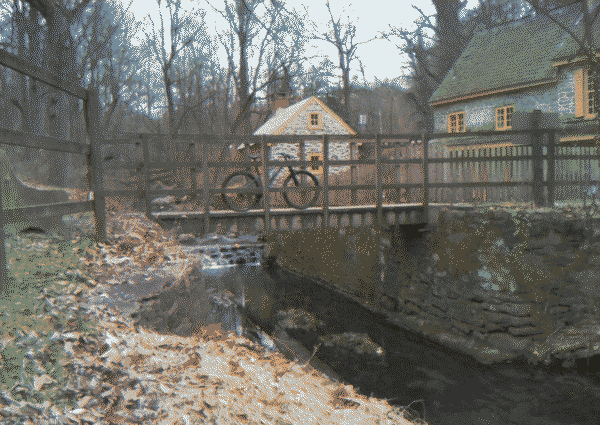
Coming through feeling sick and just in time for day light savings, which snuck up on me this year. Usually I am watching for it like a hawk, but this winter I was very focused on trying to enjoy what wintriness we got. With less than two weeks from the spring equinox, I am hoping we get a few weeks of actual spring weather before then heat of summer sets in.
I was grateful we got some snow this year, even if we got much more rain and warm weather overall. For a bunch of years of my adulthood (and probably before as well), I would yearn for spring to come and bring warm weather,n but the last few years I’ve noticed that rather than a longing, I have been asking spring to take its time and stick around when it does arrive. I no longer yearn for spring to come, I rather find myself begging it to stay as June comes around.
All the same, it really does bring me joy to see snowdrops, some early daffodils, and crocuses in people’s little curbside gardens (and in some more remote areas of the woods). Today on a bike ride in the Wissahickon I was lucky enough to see those flowers, many buds on the early trees, including some starts of cherry buds, as well as some wood ducks, and maybe some Greater Scaups, but I am not as confident that these ducks were those.
While I am certainly not a birder, per se, I do tend to pay attention to the animals at the edges of domains or ones that are straddling two worlds. I’ve always like amphibious animals like ducks, turtles, and frogs. As an kid moving around lots of places and with a mix of cultural influences from my family and the places I’ve lived,n I’ve always felt like I’m only ever at the shore of a space. This has been less so since living my adulthood inn Philly and getting deep into the bike scene, and lately the civic technology scene. But I often still have that feeling of existing at the shores between spaces, never wholly belonging to one or another.
This certainly isn’t a bad thing since I have found that I have skills in making connections between those spaces and helping to tie them together or to move seamlessly between them (though I often feel clumsy about it). There are a lot of benefits to this skillset/position as well including finding multiple perspectives on issues, learning different ways to solve problems, and ideally to learn the best parts of each space (though that is still something I’m constantly learning).
Once I get through this busy March (culminating in the Social Justice Hackathon April 5-7), I have a few projects I’d like to work on including some Code for Philly project ideas, some P5.js things I’ve been wanting to play with, and some home projects that unfortunately won’t make it to this blog. Until then I will be trying to be my best duck.
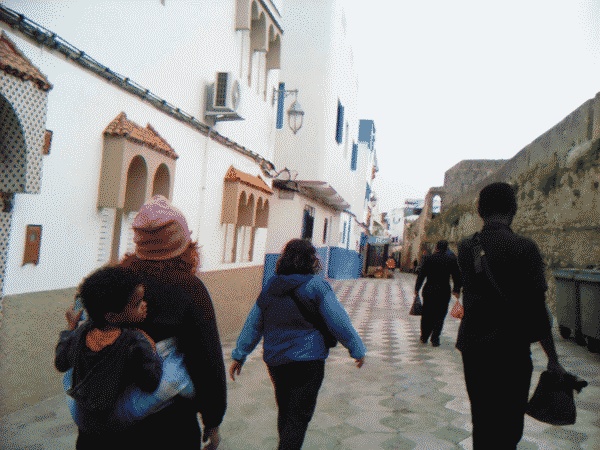
Excited to see that the sunlight is just starting to stick around after 6pm lately. A few hours of extra sunlight really makes a difference to my mood. Weirdly enough the snow in Philadelphia the past few weeks has had a similar effect. Ruby and I have been taking the time to go hiking or walking on some good local trails and walking over snow and seeing the snowdrops peeking out of the ground has been a big boost against our winter dreading. (Also I recently found out are poisonous if ingested!)
Ruby and I just spent a week in Morocco visiting a friend who has been living there. It was delightful ton visit our friends, walk around some ancient cities, and exercise our language skills (I retained more conversational French than I thought!). We were very happy to have a friend who has been living as a local as out guide since there were some serious cultural differences around tipping for services, shopping, and police state activity than Ruby and I were used to. Plus she was great at picking out interesting places to visit, liken the Caves of Hercules and Tangier’s Phoenician Tombs!
Now recovering from some post-travel sickness (not COVID, just yucky) we’re both diving back into our respective works. In particular work is ramping up for me as an organizer of the Social Justice Hackathon coming up this April 5-7. Besides that main event, we’ll also be hosting weekly hack nights starting with our first one this Thursday! We are still looking for volunteers for the event as well, especially volunteers who can serve as project leads. For that role, ideal volunteers have project, product, or volunteer management experience, especially in tech settings.
As spring creeps closer and snowdrops give way to daffodils over the next few weeks, I have a lot of work ahead of me. Between the above hackathon, Code for Philly, and my work at Community Legal Services. But also I gotta keep riding and exercising when I can because I am still planning to ride a 70-mile gravel ride in June. I promise I am not becoming one of those hustle-culture tech bros, I just have a busy March ahead of me. Just have to keep reminding myself to keep it moving one day at a time.
Despite it being so busy, I am really looking forward to spring and especially our neighborhood starting to waken up from its sleepy winter mode. As much as I can, I am looking to get social and outside as much as possible!
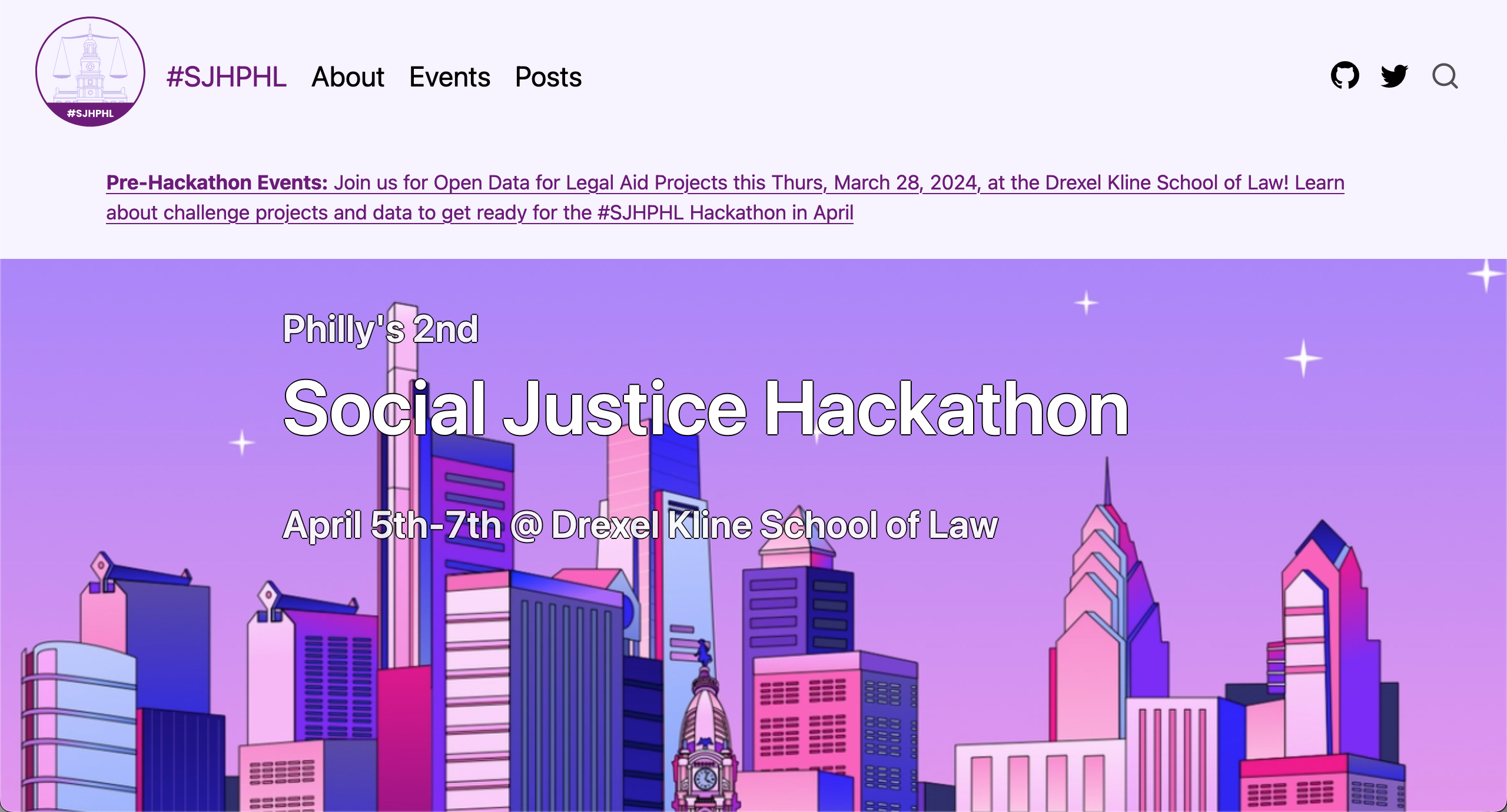

The website for the Philadelphia Social Justice Hackathon. Built with Michael Chow, Hao Ye, Jake Riley, and Iliana Miltiadous. For an event happening April 5-7, 2024.
See the code here

After a few weeks working at my new job and settling into new habits, there’s a part of me that feels like I’m waking up from something. I really did not enjoy my last job. While I knew it was temporary, I still resented the forty hours a week spent working with no benefits on a project that I found equally interesting and frustrating to work on.
My therapist mentioned back in December that I had been stressed about work for about a year at that point since it had just been announced that Azavea would be acquired while I was going through a performance improvement plan. And for the months leading up to and following the acquisition felt like shaky ground before being laid off in May.
Happily, after taking a few weeks off before starting at CLS, and with two weeks of learning new tools, legal terms, and company culture, I have really felt myself standing up straighter. I have felt like I am more aware of my surroundings. I have felt like that feeling where I suddenly come into focus and realize I have been staring into space for a while.
I remarked to Ruby a few weeks ago that I was feeling a low-level anxiety that was a similar feeling ton waking up from a nightmare. That feeling where you know you’re safe, but are still feeling scared and processing what it was you just went through. My last job was far from a nightmare, but I really wanted to be in an values-based space and really have been enjoying having that again.
I’ve also been biking more including mountain biking and that feels wonderful! My friend, Pat, convinced me ton sign up for Grinduro PA this coming June. It’s a 70-mile gravel ride through Central PA and I have not done any ride that long in over four years, let alone on unpaved roads. I said yes, first because I love riding with Pat, but also I have been wanting to get back into good riding shape and this essentially puts a deadline on that. Note: “In shape” is incredibly relative and for me it’s the ability to spontaneously be able to do a 60+ mile ride (if my schedule allows) when a friend asks me.
Getting back out on my mountain bike feels great and I am happy to be spending more time in the woods. A few days ago was my first ride since probably last July or August. While I felt shaky that first ride, a few days in I am starting to feel more confident again and able to get past some of the tricky obstacles I learned ton navigate last year.
Between my new job, co-directing Code for Philly, organizing a hackathon and a renewed cycling habit, I am feeling great both inside and out and hopefully I’m setting a sustainable pace for myself. Because I genuinely love how this is feeling.
Community Legal Services | Philadelphia, PA
January 2024-December 2024
Working in the Digital Innovation Lab to deliver reports, data anaysis, and tools to the attorneys and paralegals of CLS to help them in their mission to to fight poverty, challenge systems that perpetuate injustice, and change lives through cutting-edge advocacy and exceptional legal representation. Projects are built with Django, Docassemble, R, pandas, and LegalServer.
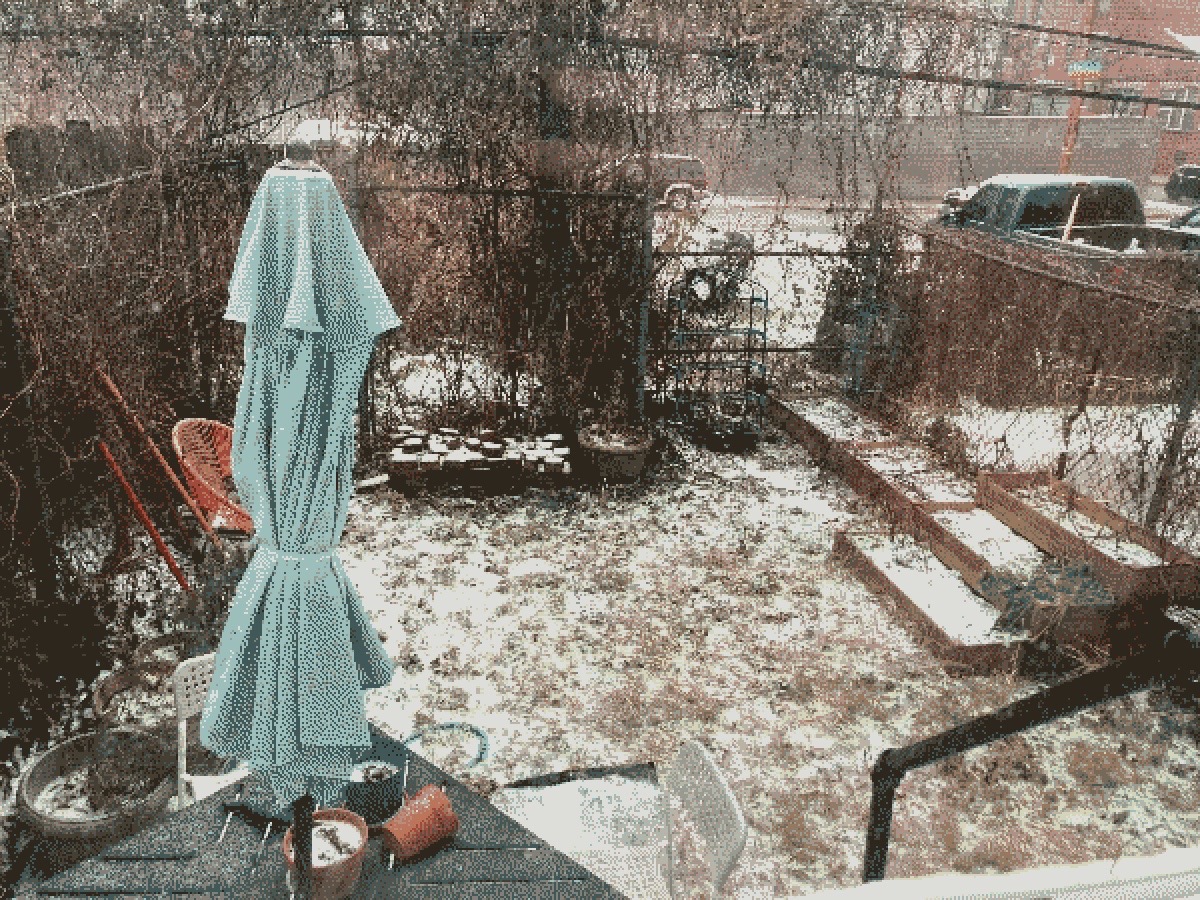
New year. I am newly 35 years old and just came through a tough but still good year. Many years have been tough for me, but in the grand scheme of tough years, 2023 was pretty easy on me. This year In was laid off from a dream job, joined the leadership at Code for Philly, didn’t ride my bike enough, worked in a large corporate environment that I dislike, but ended the year by securing a job that fits my values. Ruby and I also have some travel plans that I will talk about more once we’re back home!
New job. I will be joining Community Legal Services this week as a Developer and Data Analyst in their Digital Innovation Lab. I am excited to be working on local issues and helping Philadelphians, but I am also just excited to be working at a values-driven organization once again!n CLS is a great organization and I have been a fan of their work for some time.
New habits. I have a new Bonk planner and want to leverage it to build up some new habits and routines I have been wanting to build. I am using it as part tracker and part journal. Each day I note: How many cups of coffee I’ve had (less than I thought). Which meals I’ve prepared. When I woke up and went to bed. What exercise I did that day. What 3rd place I visited. What tasks I need to do and which I did. And finally a highlight list of what happened that day. I have been doing it for a week now and it’s already given me some insight into my habits and helped me build some new ones.
I was expecting that I would have more reflections I’d like to share from my usual birthday/new year introspection, but I think most of that is best left private. I am looking forward to this year, even if it is starting with winter (as Gregorian years typically do), but time with friends should at least make that easier.
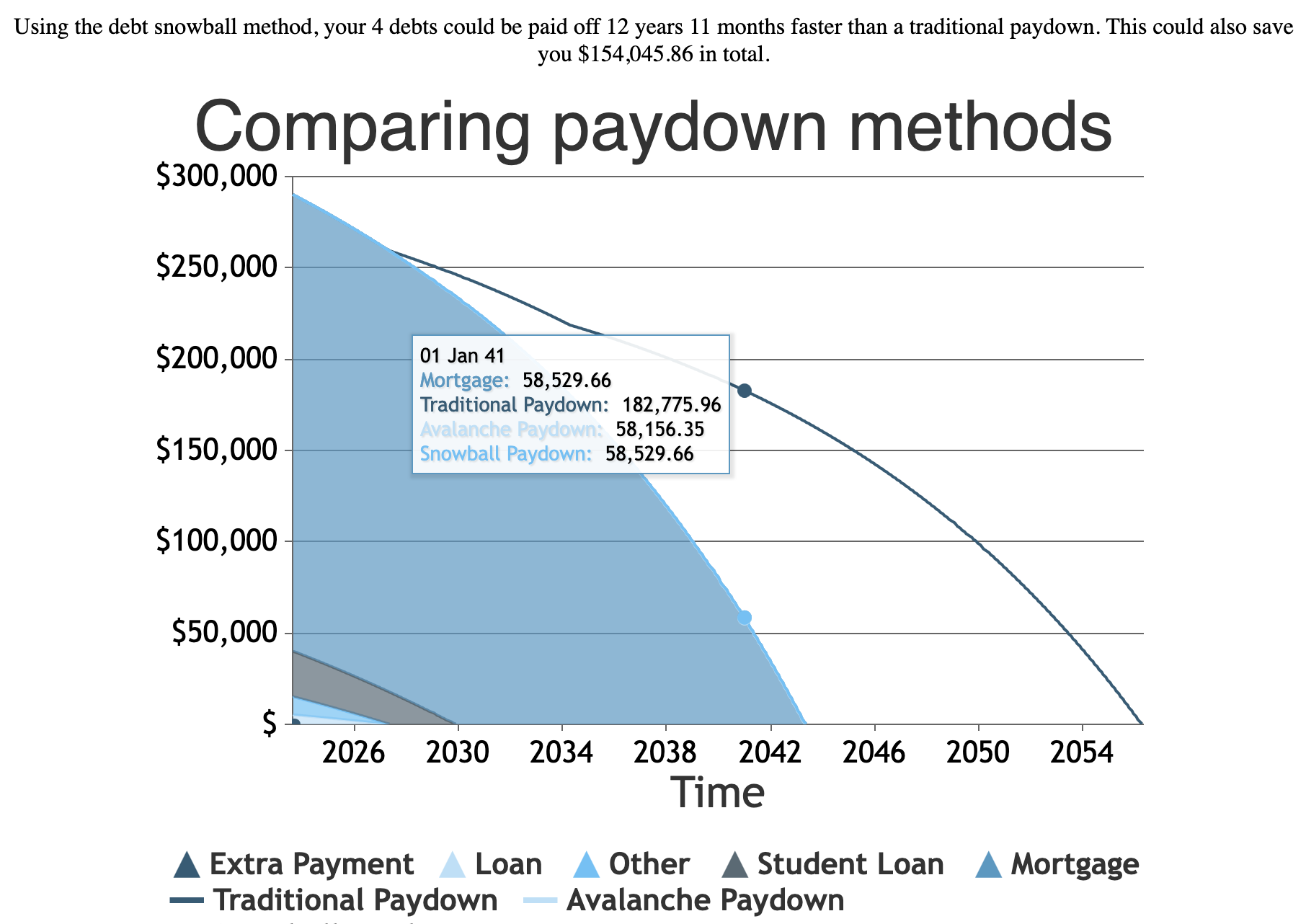
Earlier this year I built a project that came from a personal need. I have three student loans from my time at University of the Arts, my time at Temple University, and my coding bootcamp. My spouse Ruby has her own loans from undergraduate and graduate school. We also share a mortgage on our home. I have been exploring different options to ideally pay down these debts early and save both money on interest and time for ourselves in the future with less debt payment burden.
As part of my research, the most personally compelling plan I found is called the debt snowball plan. Then essence of the plan is:
What is nice about this plan is that, unless you are adding extra each month to accelerate the plan, the amount you pay towards your debts each month stays the same. Arguably this is also a drawback, since the monthly payment burden stays the same, even as debts are resolved. I am not a financial expert but appreciate then simplicity and effectiveness of this plan. There are similar approaches like the debt avalanche, which works similarly except that the first step is to order the debts from highest interest rate to lowest. My understanding is that while also effective, the avalanche is slower overall, but especially slower to start feeling the benefits of paying off the first debt in the sequence.
For our situation, without going too deeply into our personal finances, following this plan would allow us ton pay off our student loans a few years early. However, the much bigger effect is that our mortgage would be paid off about 14 years earlier than the 30 years our mortgage is planned for. If all goes to plan, this would save us a lot in interest and dramatically cut down our living expenses. Granted, all our loan terms allow us to pay down the principal ahead of schedule, and not all loans allow this (although they absolutely should). You should check your terms on your loans before making any plans.
Now that I understood this plan, I wanted to show Ruby how this may benefit us, but needed a way to show her how it works. There are many debt snowball calculators, and most have great written descriptions, but almost none of the ones I came across had any sort of chart showing how the plan is paid off over time. I am always one to make a plan with a spreadsheet (including vacation plans) and my favorite part of any spreadsheet is creating charts.
Having charts would also help me explain the concept and benefits to Ruby, but also would help me visualize for myself the differences between different plans and also continuing to pay the minimums. Faced with a serious dearth of charts amongst the existing resources, I did what all engineers do when faced with a missing tool: In began to build it myself.
To build this out I had to do some research on how loans, interest, and amortization work at a more detailed level than I had really thought about since learning about complex and simple interest in high school math classes. I started with an spreadsheet for myself, but quickly realized that what I wanted was a webpage. I found it much easier to create loops and recursive functions with JavaScript than with spreadsheet macros. Besides, if I was looking for debt snowball charts, others likely were too, so once I had a complete site, I could share it publicly as well. You should try it out and see if a plan like this might work for you.
I built this early on in my learnings about permacomputing and building out smaller websites with just HTML, CSS, and JavaScript. I wanted to lean onnand design around the HTML tags as they exist. I think I did an okay job with this but some of the parts of how this is built go against some of my better design sensibilities.
In particular, I think the site uses too much text without intentional visual hierarchy and too little color ton help orient a person to what to use or read first. I do still think this project works but I learned some things about designing a project from scratch and would like to revisit the aesthetics of this project sometime. Overall, I am still happy with how it came out for a weekend project. Plus, I do still use this to occasionally to recheck my own financial plans as our life and the world around us changes.
Excitingly, we have our snowball rolling down the hill and are just this week starting to see it picking up some momentum. My loans from my time at UArts were fully paid off at the beginning of this month and I was able to use what I was paying towards that and put it towards my boot camp loan payments. It feels wonderful so far and I look forward to completing this plan.
See the code here
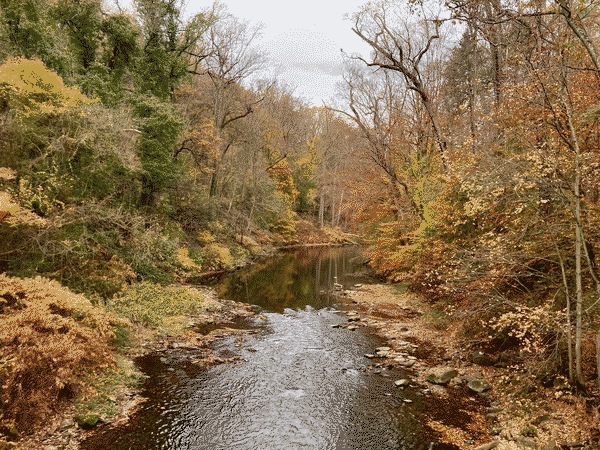
Autumn is in full show here in Philadelphia, at least up in the Northwest of Philly where I now live. The colors are a great time to reflect on the passage of time. It being the weekend daylight savings ends is also a big hint that time is always changing, even if only arbitrarily.
I am grateful to see the leaves change like this and for consistent access to more trees in general than I had experienced in South Philly. Despite being much closer to the Wissahickon park, I still don’t go there often enough (at least not as often as I’d like to). I also appreciate the irony that as a teenager, I completely took for granted the massive forests around me in Northeast PA, but mostly because I wanted to be closer to my friends.
I’ve gone through a lot of changes to my daily life this year: My employer got acquired, the new employer laid me off, I am joining the Code for Philly leadership team, and Ruby is kicking up her business again! I’m still expecting more changes to my daily life before the end of the year.
Changes can be very hard, and many people are resistant to them. I had to learn to weather changes as a child who attended at least one new school every year until the sixth grade. Then in my late teens and early twenties I welcomed changes to help get me into better places. When I can afford to, I also bring on daily changes as recreation in the form of bike tours. Each day is a different ride to a different place and I rarely wake up inn the same place twice on those trips. I even planned a trip in 2019 along the East Coast Greenway to follow the beginning of the changing leaves that year.
A huge change for me in the last year was buying a house with Ruby. What’s especially wild about that is that wen effectively signed up to be involved with this one house and piece of land for thirty years! Granted, we don’t have to stay here for thirty years if we don’t want, but a mortgage is still on that scale of financial planning. And for most future plans, selling this house would lead to buying another.
This is often a “stage” of American life where a person really wants to stop changes. They want to keep their neighborhood exactly like it was when they bought their home. But I try to remember change is inevitable.n Planets and stars continue moving through space. Water pulls mountains down towards oceans. Winds push leaves and seeds off plants. I hope I can continue to take on changes with grace and never try to lock my life inn place.
I still don’t feel ready for winter, but there is certainly still time to prepare. And arguably, that is then purpose of a transitional time like the fall to help us get ready for the cold and dark. That we can slowly approach the hard things and steel ourselves to them as they creep closer. I tend to be an optimist and one way that hurts me is that I spend most of the winter just looking ahead to springtime rather than embracing what winter has to offer.
This year I want to commit to changing my approach to winter: To use the inside time to improve my engineering and my art. To make more time for friends to get together. To take advantage of the slowed plant growth ton prepare an overgrown lot to become a garden. To spend time decorating my house. This winter I want to resist hibernating.
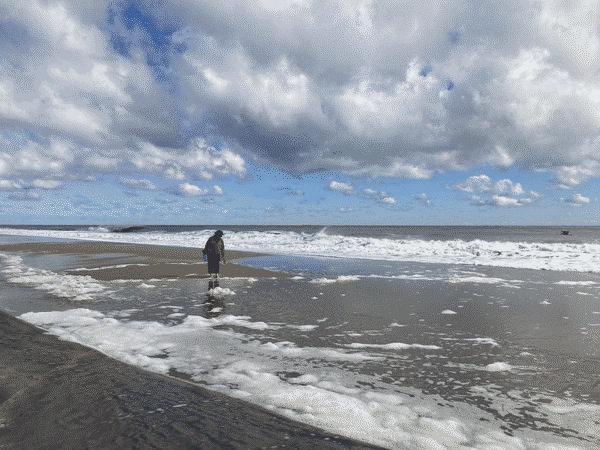
Over the past few weeks I have released a tutorial to make the classic video game, Minesweeper, from scratch using native web tools (being HTML, CSS, and Javascript). (Check out parts 1, 2, & 3!) I was motivated to write tutorials in general to help new developers bridge the gap between what they currently know and what they need to know to get a job developing code. The other half of that motivation is to help me become a better developer by teaching.
I chose to write tutorials about native web tools because developers do need to know what the browser is actually reading and rendering and why it does what it does. Part of this is that frameworks and libraries compile down to HTML, CSS, and Javascript, so developers should be aware of what is happening ‘under the hood.’ In was taught to try to be aware of how the tech is working at least one or two layers down to ensure my code will behave how I want it to. The other part of that motivation has been feeling more and more that we should be delivering smaller websites to end users.
I have been reading a lot of work around permacomputing, more sustainable technology, and making the web better for people, including developers. And one of the easiest ways I can do that as a developer is to write my own code that is easier on both storage and compute power and also to encourage others to do the same. One of permacomputing’s principles is to “Keep it small” since:
n Small systems are more likely to have small hardware and energy requirements, as well as high understandability.n They are easier to understand, manage, refactor and repurpose. –Permacomputing Principles pagen
There’s certainly more to permacomputing and sustainability than just making things smaller, and there is also an “code golf” tradeoff where the code becomes so small that it makes it harder to understand and thus will be harder to maintain. This blog and my portfolio site in general are built as just a static webpage and the only library I’m using is JQuery, though it could be rewritten in vanilla Javascript. Granted, there are downsides to this setup: one is that I cannot tell how many people are visiting the site unless they tell me directly. For now this is fine since I am writing these for fun and practice more than relying on them for any sort of income just yet.
Along the lines of not knowing who is reading, I have no plans to track readers ever. User tracking is creepy and invasive. I personally use tools to protect my privacy as much as I can, and I recommend you do too.n At some point, I will want to know how many times posts are being read (and if possible how many unique readers,n if there is a non-tracking way to do that). I currently have the site and blog hosted on GitHub Pages, which is easy to use and free. But to start seeing some readership numbers, I would have to set up my own server. I would like to do this anyway to improve how I’m coding the different posts, to fulfill my own DIY desires, and to taken more control over my work and the resources it uses.
In the meantime, I am reasonably happy with this site. It serves my need of having a consistent site for software projects, pixel art, and blog posts. One of my TODOs is to create a resume.html page with a list of all my past jobs and download link for the PDF. If you enjoy what I’m building here, please consider supporting my work to help me make more tutorials, blogs, pixel art, and everything.
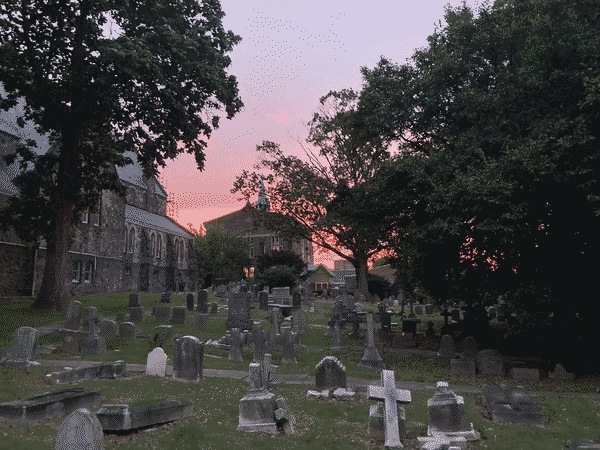
I have some updates from the past week and a content schedule for the next month!
Firstly I am honored that last Monday I was named one of Technical.ly‘s RealLIST Engineers of Philadephia for 2023! It always feels nice to be recognized for work and this is the first professional recognition I’ve received since transitioning into tech. I am especially honored that my work with Code for Philly was specifically mentioned because I am incredibly proud of the work that I’ve done there over the past three years.
Speaking of Code for Philly, my second update this week is that I am stepping up to join Code for Philly’s leadership team as the Operations Lead. Over the next few months I will be learning more about the different projects we facilitate, who the players are (that I don’t already know), and what needs and strengths each project team has. I will also be supporting the teams’ operational needs like making sure teams have the tools they need to thrive. I have loved volunteering on the PLSE Expungement team for the past three years and will continue to support them as team lead until a new lead is fully in place.
My final update from the week is that I have put in some work on updates to my personal website and portfolio! In have made the home page a little less scattered so that now it only shows my most recent projects, blogs, and pixel art pieces. There is also a separate about page so that it is easier to link to. Then biggest change is that the projects, blogs, and pixel art all have their own pages. Each of the pages shows an list of the content and when clicked on, shows a detailed view with the ability to navigate to previous and next posts.
This change felt relevant to my interest in writing blogs, doing streams, and making more pixel art. The thought was “If I will be making more content, it should be easier to look at content on my portfolio.” Granted this has been an upgrade to my website I have been wanting to do for a long time. But of course, priorities for a long time were elsewhere and finally I was able to make those changes. There’s always more to do but I’m pleased with this update and excited to post more and find need for things like pagination and a more robust database than a JSON file.
Speaking of content: I made a content schedule for myself for the next month! I am still figuring out a good way to do streams from my refurbished early-2015 MacBook Pro, so those will not be announced yet, but I will be sure to post them when they are officially scheduled. For now what I can say is that they will be Mondays from 7-9pmn Eastern Time. The blogs though are certainly ready to be sheduled! In the month of October, I will be publishing:
The titles and topics may change, like everything in life, really. And once streaming is figured out I will add that to the schedule as well. But, like always, the best way to keep up with this blog is to subscribe to this blog’s RSS feed and to my subscribe to my YouTube channel where I’ll be streaming (once I figure out the tech for it). You’re also welcome to join the test streams as they pop up.
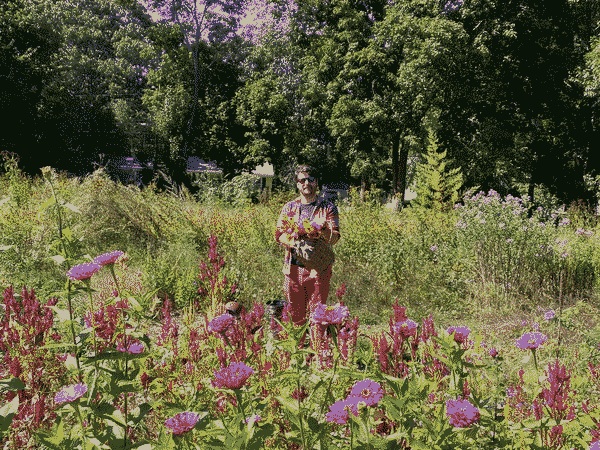
I have been working on personal projects in my spare time for a few weeks: stepping into a leadership role at Code for Philly, writing tutorials for upcoming streaming I’ll be doing, and working with Ruby to improve our house.
The PLSE Expungement team at Code for Philly has been putting in a ton of work lately and In am thrilled to work with such stellar volunteers. I recently wrote a new update for our project page talking about the progress we’ve made over the past year. We’re actively accepting new volunteers if you live in Philly and are interested in meaningful work and expanding your skills.
I decided to start writing out tutorials for weekend-sized projects in browser-only,n native tech (i.e. just HTML, CSS and JavaScript). I have one tutorial completely done, a second almost ready,n and a third one in the wings. Once I have all three done I will start hosting weekly streams teaching those tutorials as well as working through personal projects and pixel art. I plan to do those bigger tutorials monthly and edit them into more digestible videos and written blogs. I have found a lack of beginner-friendly written content in this area and am seeking to fill that gap.
There’s a few motivations for doing the streaming and content creation despite being concerned about getting back into creating content. One is that I do like making videos. I spent years growing my video production skills and genuinely love making them. Another is that with the streaming, writing, and developing, I will become a better developer and continue growing my skills. The last is that I am interested in doing more independent work and that likely means trying to grow an audience (Hi!) and build out some options beyond just working for a boss.
That being said, I still plan to work full-time and you should hire me full time as a Software Engineer, I am certainly still interested in working on civic technology and geospatial projects that improve people’s lives. Doing work that is meaningful to me will always be one of the most important factors in how I choose to spend my days. A salary and healthcare are important ton me but I work best when I am working to make the world a better place. And that’s a huge part of why I’m interested in trying to take more of my workday decisions into my own hands. My goal with these projects is ton plant seeds so that I can begin to cultivate a career aligned with my values.
The best way to keep up with what’s happening is to check here or subscribe to this blog’s RSS feed. To see my upcoming streams subscribe to my YouTube channel where I’ll be streaming them.
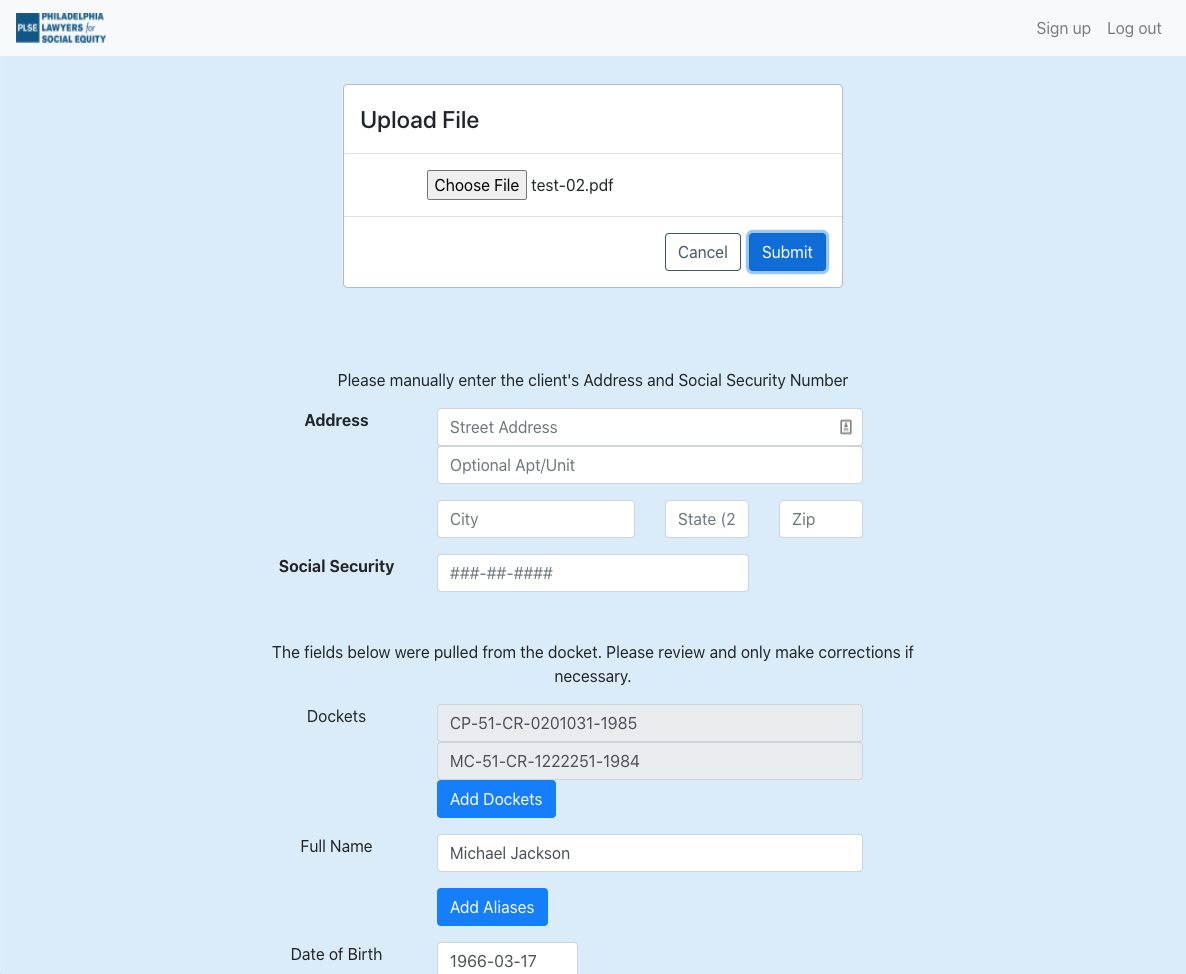
From the project page: The project we are currently working on is building out an expungement petition generator for PLSE. The application takes in PDFs of clients’ criminal dockets and returns fully formatted petitions to expunge the clients’ criminal records. Having a clear criminal record helps those clients to better find work, housing, and services.
Brooksource | Philadelphia, PA
July 2023-December 2023
Worked as a consultant full time at Comcast helping to build and launch the Iris tool built in Node.js, Express.js, MongoDB, Unity, and Angular.
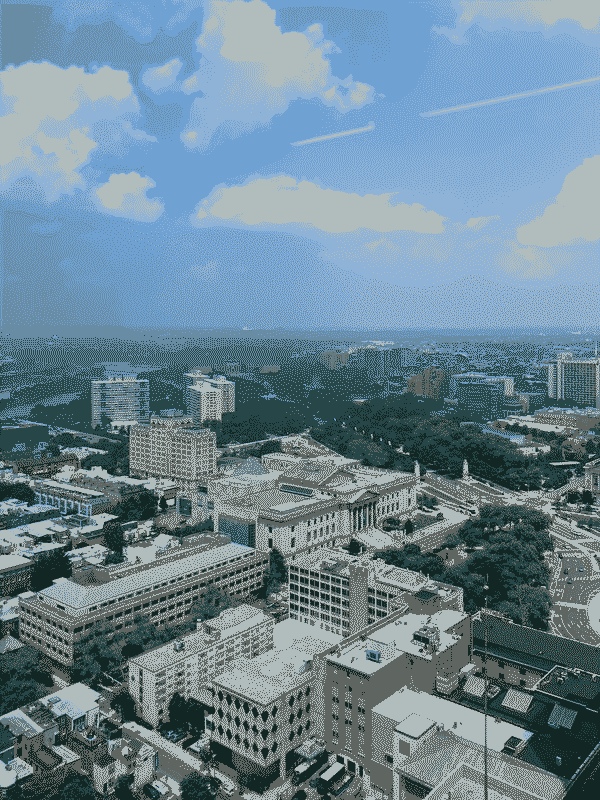
I have been arguing with myself for a while now about getting back into content creation for then past few years. I have started and abandoned moved on from so many projects over the years. None of them necessarily “gained traction”, but I also never gave things enough time to really find their audience. I’ve been consistently thinking for a year now that I did enjoy making those things at the time and probably would again.
Theoretically this is the “right reason” to be creating content: Just feeling a drive to make things. However, I really despise the phrase/title content creator for both its hand-wavey vagueness and especially the implication that one is not a filmmaker or an illustrator or a writer but a machine akin to a meat grinder whose main output is “stuff”. This is especially shakey ground to even acknowledge considering AI generated content.
But I suppose I am considering making intentional, scheduled work again. And while I am not quitting my day job (certainly not in week 3), I do have an interest in trying to grow an audience and add some commerce to the art. And that’s where I start to get nervous: When I have started to treat making things for fun as a job they haven gotten less fun. Specifically resenting time pressure, feeling like I have to make a thing or else, and that the things I am making are just not good. Often I felt like the “just to get it done”n factor was hurting how I felt about making things.
Granted, I say all that and yet: I was always far happier having made the thing and seeing it posted than I ever was not posting the things that didn’t make it. I genuinely enjoy the act of editing a video, hand-placing an pixel, and writing a blog post. Making things is fun, and as long as it stays fun I’ll be happy to make things. If I can continue to make things that make me happy and make some income from it without feeling burned out by it, then that would be genuinely dreamy.
This is not an announcement of anything in particular. I don’t have a specific plan right now, but I suppose keep an ear out because I’ll be making something soon. Which of course reminds me to remind you that you can get this blog delivered to you automatically by subscribing to the RSS feed I maintain for this website!
So definitely no promises, but lately I have been interested in:
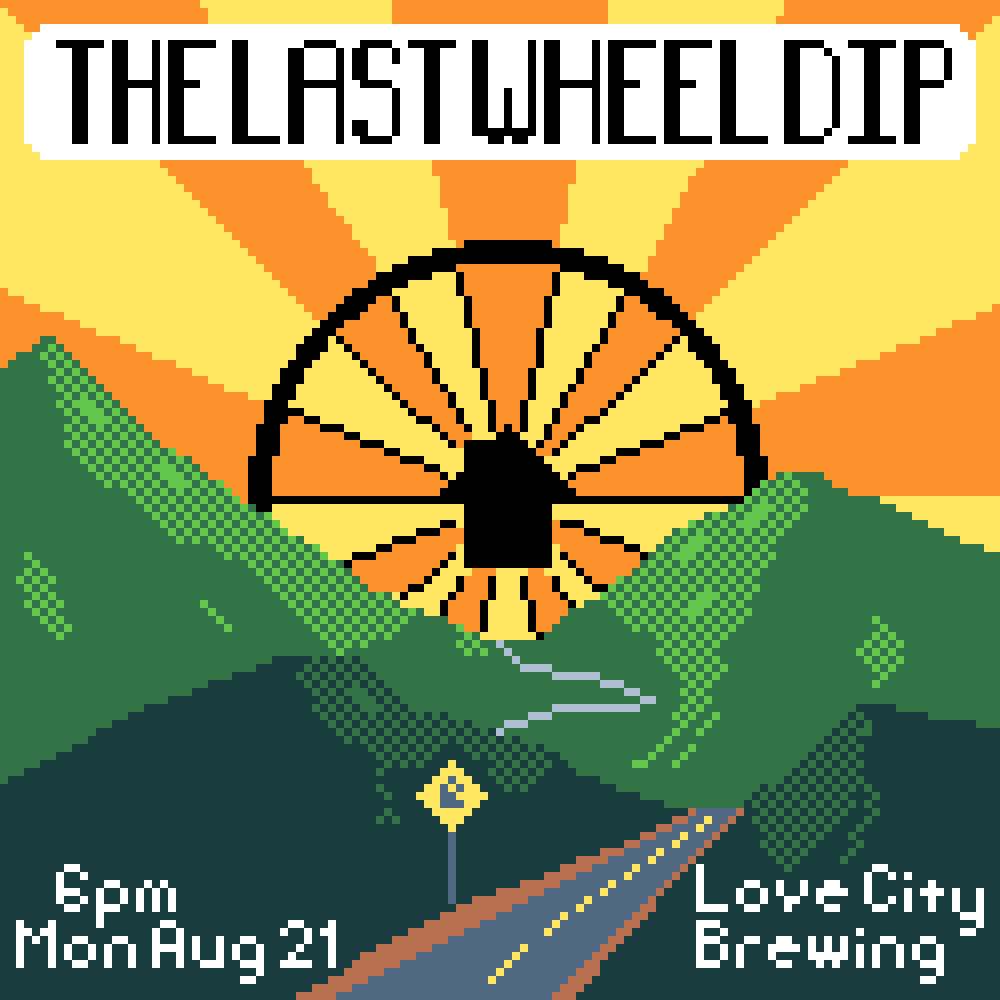
A pixel art poster I made advertising a party in Philly to acknowledge Bike & Build ‘s last ever trip ending and to celebrate with alumni and share trip stories.
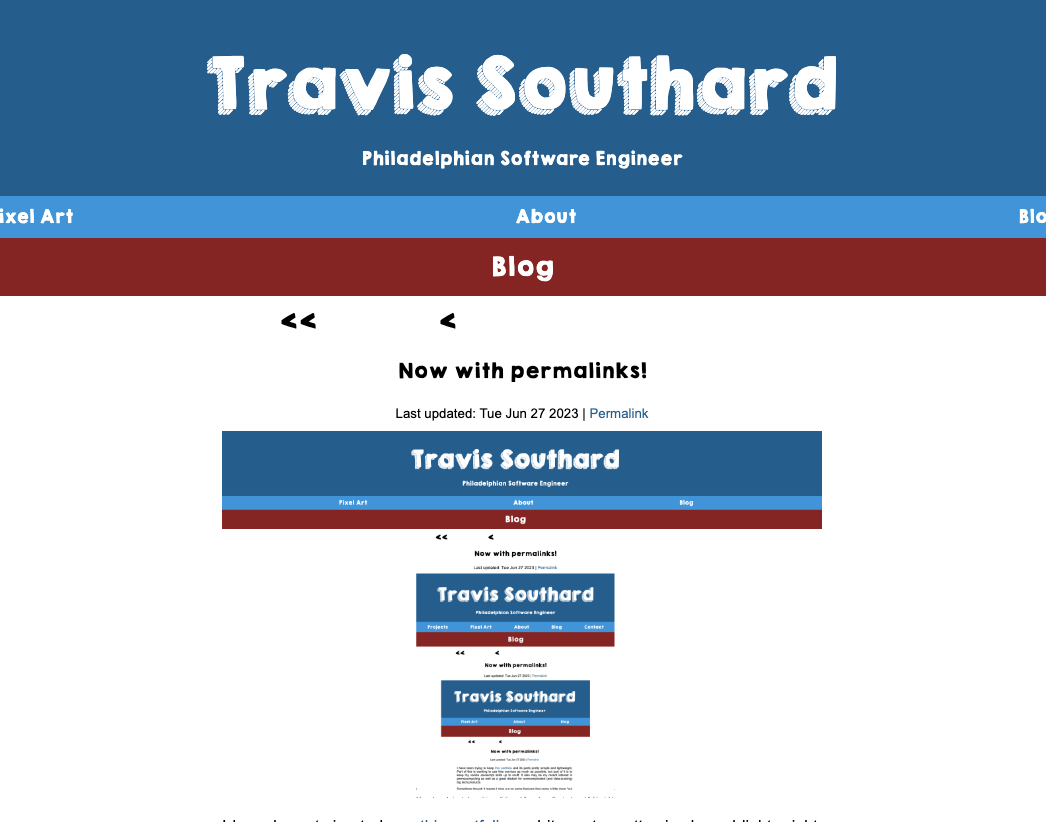
I have been trying to keep this portfolio and its parts pretty simple and lightweight. Part of this is wanting ton use free services as much as possible, but part of it is to keep my vanilla Javascript skills up to snuff. It also may be my recent interest in permacomputing as well as a great disdain for overcomplicated (and data-sucking) big tech products.
Sometimes though it means I miss out on some features that come a little more “out of the box.” I met up with an former colleague last week and we were talking about just this issue. He pointed out that while he has been enjoying reading these, there was no way to link to a particular post. Well no more!
I did some work this morning to add support for permalinks with these posts despite not using a backend or database. The solution I adopted here was to use query parameters from the url and a custom function to create slugs from the post titles as unique-ish identifiers. This was pretty easy to set up, luckily, and you can look at what I did ton put this together here. This also gave the the ability to refactor some functions to better organize what is happening where and add the navigation buttons to the top of then blog page as well.
Granted, this current system using a javascript array in a .js file will only last so many more posts before I want to convert this to using a database, but I have genuinely been enjoying this set up and the custom RSS generator to put these together. My tolerance for a too-long file may grow as that file does.
There is something powerful about mastering the “simpler” or lower-level skills in coding. I felt this way when digging more deeply into bash scripting, C, and SQL queries the last few years. But I think that since I am most interested in building out things for the web, I will continue to work in vanilla (or close to) Javascript and try to make things as lightweight as can also be readable (and maintainable).
Moreso than feeling more like a wizard with code, I am feeling good about having my own online space to put the weird things I am working on or just what is interesting me at any time. It is also nice to feel like I have more control over the presentation of that space and its content. I am not necessarily interested in becoming a Content Creator™, I am interested in sharing what I make, how I make it, and especially in helping others to learn how to create spaces like these for themselves.
These posts still feel good to write and especially to see them update in my RSS reader. These will likely continue to be a mix of project updates and personal blogs. I got a lot of good feedback on and have somewhat improved the way I am spending my days, but that is a whole other work in progress.
Thanks for reading!
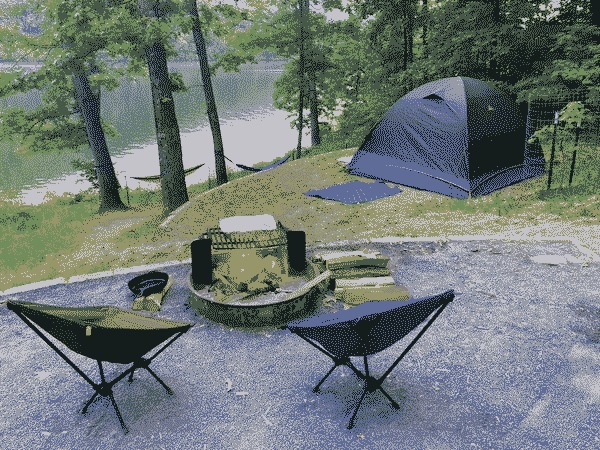
I am still very much on the job search. I am actively seeking a full-time (though ideally 32-hours-a-week) software engineering position in civic technology with geospatial work. I have had some great conversations and opportunities so far and In hope I can find something I love very soon.
While I have been home, I was hoping to establish a new routine that honors my physical, emotional, and interpersonal needs. Ruby recently prompted me to imagine my ideal life and I struggled to even begin. In have the ability and strength to imagine a better world, improvements to my city, and even fantasy elements, but apparently not my ideal day. I also recently thought about this issue because of a great (13-year-old) blog post about feeling helpless about how we spend our non-work time.
But recently, Ruby and I did a 4-day camping trip at Raystown Lake in Central PA. We drove out on a Monday,n brought our mountain bikes, an enormous borrowed tent, and a new cooler full of lovely foods to eat. At camp, In found I was able to live more like I want:
I have felt this feeling before; that I feel better at camp than I do at home. This was a large part of why I didn so much bike camping from 2016 to 2019 and tried to make bike touring my job a few years back. I have recognizedn that a campsite is a better environment for me than the one I make for myself at home.
Granted, that does not mean I understand the solution suddenly. When Ruby and I were talking about this the other day, she asked me what made the difference. I wasn’t really sure, but I did say, “WiFi.” And I think there’s some truth to that. I tend to stay up too late clicking on another YouTube video, or scrolling down a social media feed, or finding another reason to avoid bedtime. Part of this is a very ADHD struggle with transitioning activities, but I think I also feel resistant to be done with the day (even though all of those activities just reinforce that I am, in fact, done). Those late nights make it harder to get up when I want to and everything gets thrown off.
I have come to recognize that I am far more capable of harder and more complex tasks in the morning, whether that’s work, chores, or even a hobby. I was good at building that into my last job by blocking off the start of my day through 1 or 2pm. I think trying to build my day more like that above schedule is going to really help men just feel like I’m living more fully.
n
Especially the idea that I would have a morning block for harder things to do and an afternoon block for easier or less complex things to do. Another huge thing that I have really been needing more and more is ton specifically leave the house and bring my computer to a cafe or do chores outside the house (including outside my own backyard). I just don’t go outside nearly enough if I don’t already have a “thing” to go to. So it’s up to me and my adult self to make that happen.
Yes, the schedule above is simple, but having that as an established habit will be better than the current habit: Just throwing myself at tasks and feeling paralyzed so I just avoid them while falling in scroll holes until they are too urgent to avoid. Ton no surprise; that feels awful.
I genuinely believe that establishing such a routine would help me shake some of the executive dysfunction I’ve been feeling lately. Not to mention it will help me really feel like I’m living up to my potential and living an fulfilling and actually restful life. Building habits is very hard, but I have done it before and can do it again.
I am currently volunteering on a project as part of Code for Philly’s Launchpad 2023. I am working with a small team of developers and UXers to develop a project that will seek to connect Philadelphians to comfortable public spaces, with the focus being on finding places spontaneously.
We got started at the end of March this year and the launchpad demos will be on May 10 as part of Philly Tech Week 2023. Come see our presentation!n For the past few weeks we have been simultaneously going through the discovery of what we want to build and setting up the boilerplate to build our code on.
One speed bump I ran into was setting up a docker-compose.yml file. In my work life and in my other Code for Philly project, we use these to build, run, and manage our Docker containers for the frontend, backend, and database. However, I realized this week I have never set one up from scratch since those above projects were either already built or built from a template we couldn’t use for this project.
For context, we are going to be building a React frontend with Leaflet for our map component, and a Django backend with PostgreSQL and PostGIS. We also decided to set up React with Vite to avoid create-react-app.
Setting up the Dockerfiles and docker-compose.yml file were easy enough using the Docker setup documentation. In made sure each docker container built and ran on its own, but when putting them together with compose, I was getting this error from Docker:
error: cannot resolve import from 'vite' from vite.config.tsAfter a lot of searching, looking at forums and docs, and trying many different things, this error mostly pointed to the idea that vite is missing. Where a lot of the solutions pointed to an old issue with Node 14, Typescript, and Vite and that solving it with updating Node to 16, that wouldn’t work for us since we are using Node 18.
I checked to make sure it was in the package.json, and making sure that npm install was running successfully. And there I found it: Despite, the Dockerfile calling for npm install to run when building, the logs showed it wasn’t actually running.
The solution I found pointed to using the following line in the Dockerfile in our React app:
# From:
ADD . .
RUN npm install
CMD ["npm", "run", "dev", "--host"]
# To:
# See the PR for the full Dockerfile.
ADD . .
ENTRYPOINT [ "/entrypoint.sh" ]
CMD ["npm", "run", "dev", "--host"]
And of course adding that entrypoint.sh file with:
#!/bin/sh
npm install
npm rebuild esbuild
exec "$@"
The npm rebuild is there as a precaution for a problem I was running into with the wrong esbuild coming from the Docker host, but using that entry point file did successfully get the node_modules installed with the correct esbuild and now we are happily boilerplated and ready to roll building out as much of our demon as we can in the next week!
Edit: 6/16/23 – Fixed a tab error in the code portions.
See the code here
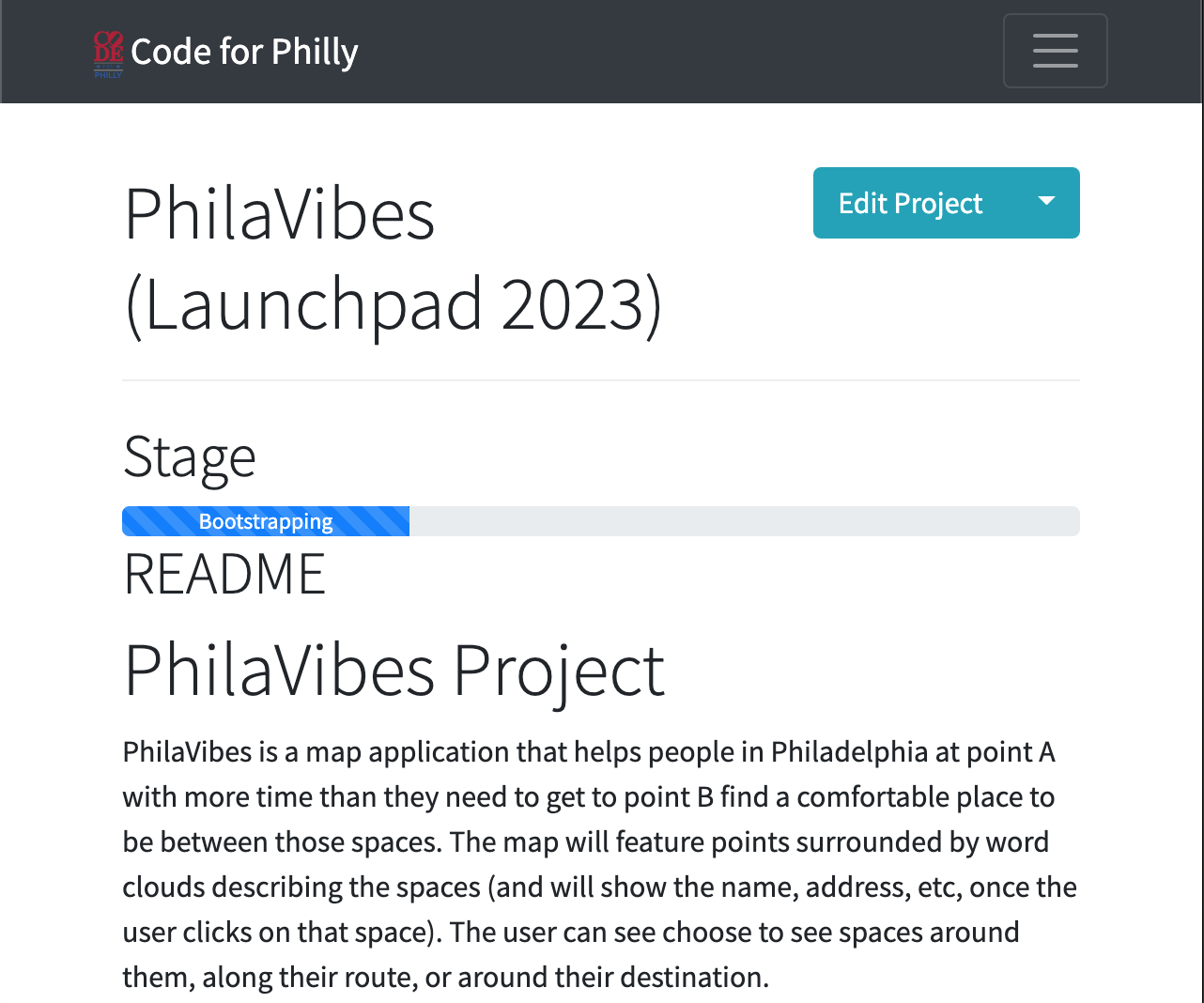
PhilaVibes is a map application that helps people in Philadelphia at point A with more time than they need to get to point B find a comfortable place to be between those spaces. The map will feature points surrounded by word clouds describing the spaces (and will show the name, address, etc, once the user clicks on that space). The user can see choose to see spaces around them, along their route, or around their destination. Philavibes started as a Code for Philly Launchpad 2023n project.
See the code here
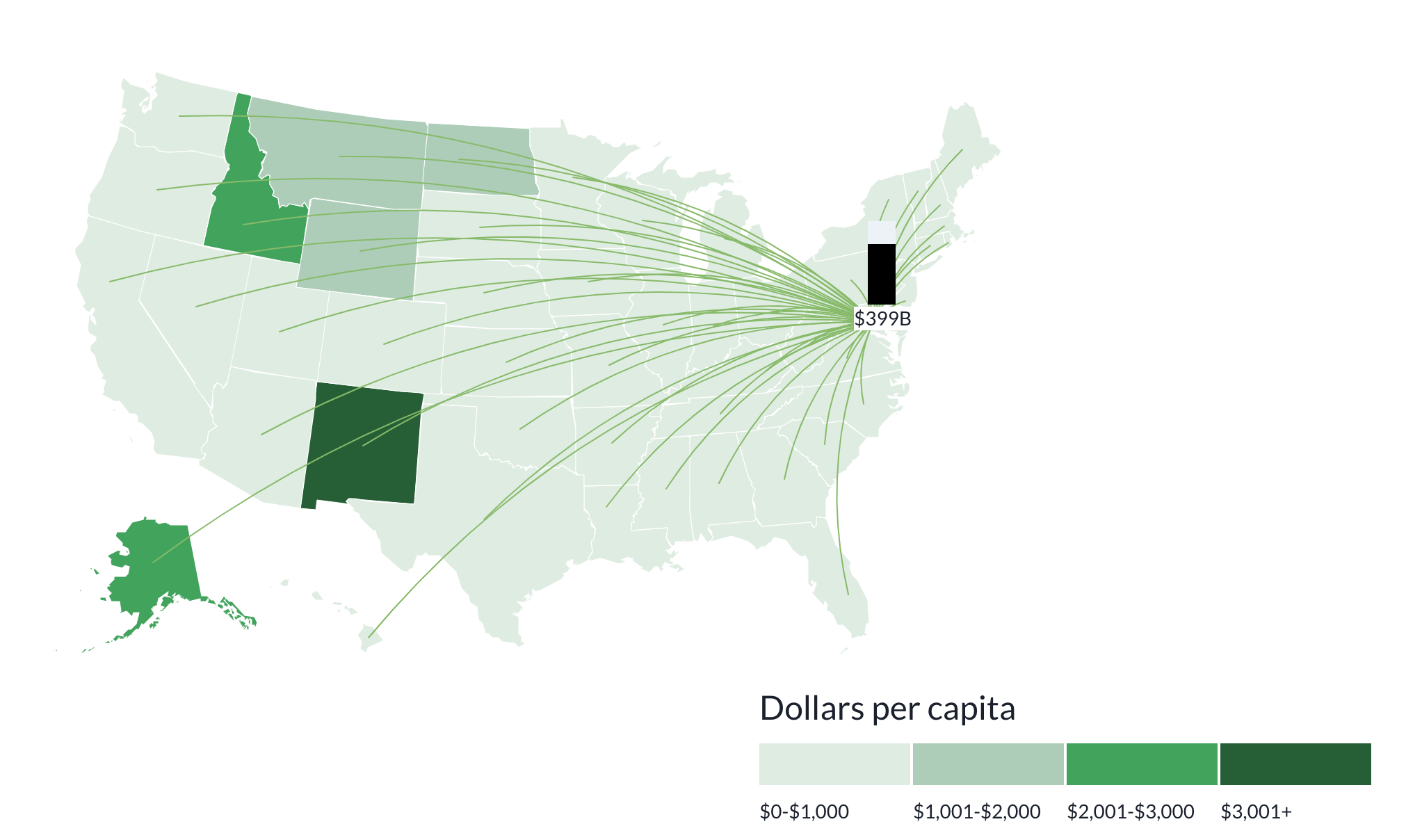
A demo project by Azavea (now Element 84) developers to show Bipartisan Infrastructure Bill Spending by state.
See the code here
Element 84 | Philadelphia, PA
February 2023-May 2023
Element 84 acquired Azavea. I continued to work on the Civic Applications team working on client services projects to build and maintain geospatial web applications built in React, Django, MapBoxGL, and PostGIS for governments, non-profits, and corporations.
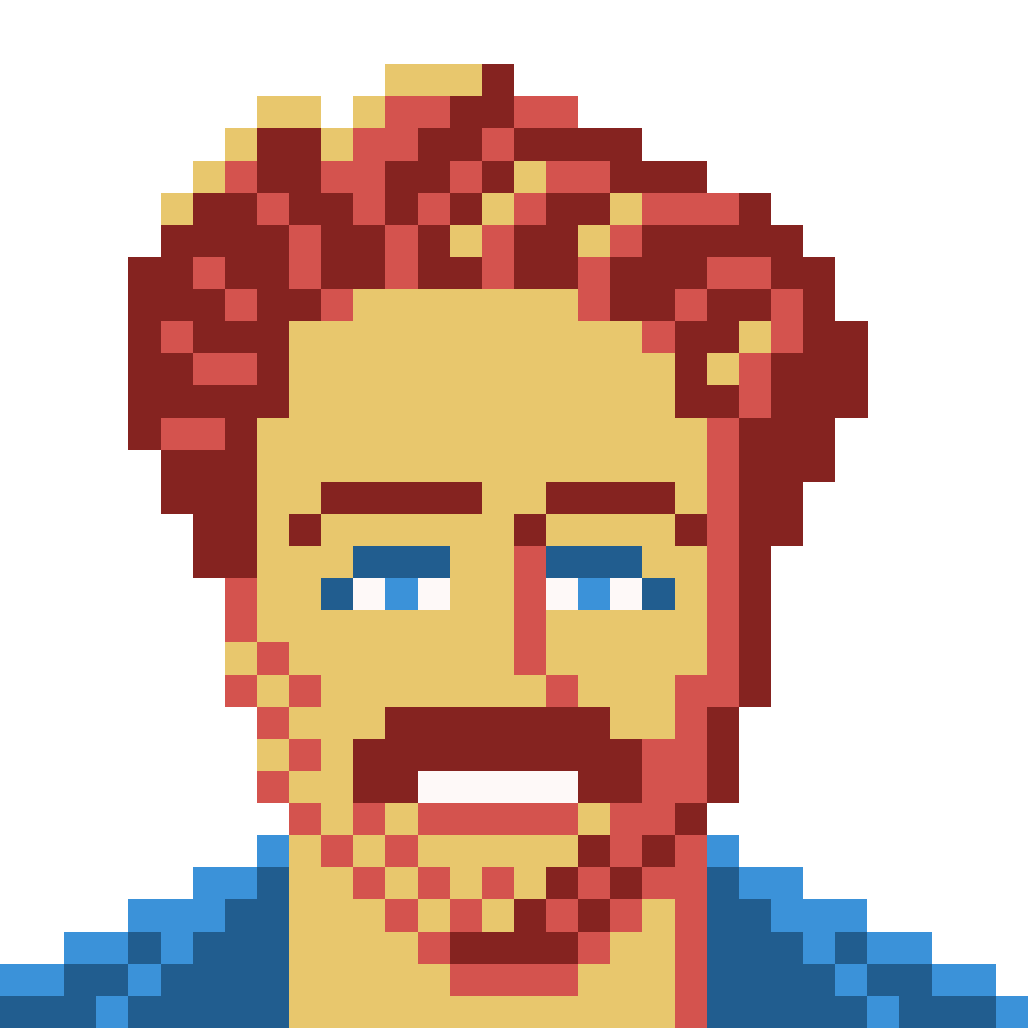
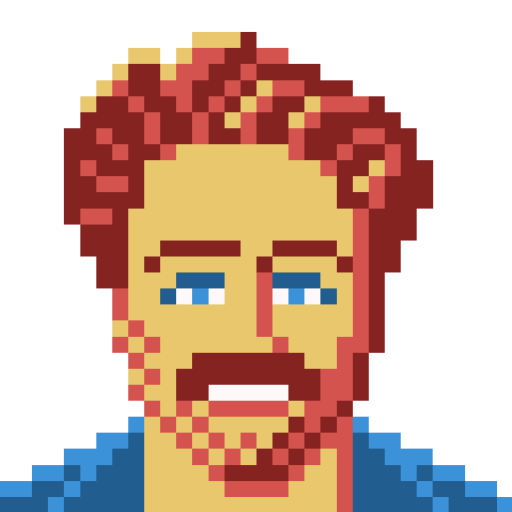
A small resolution pixel art self portrait I made.
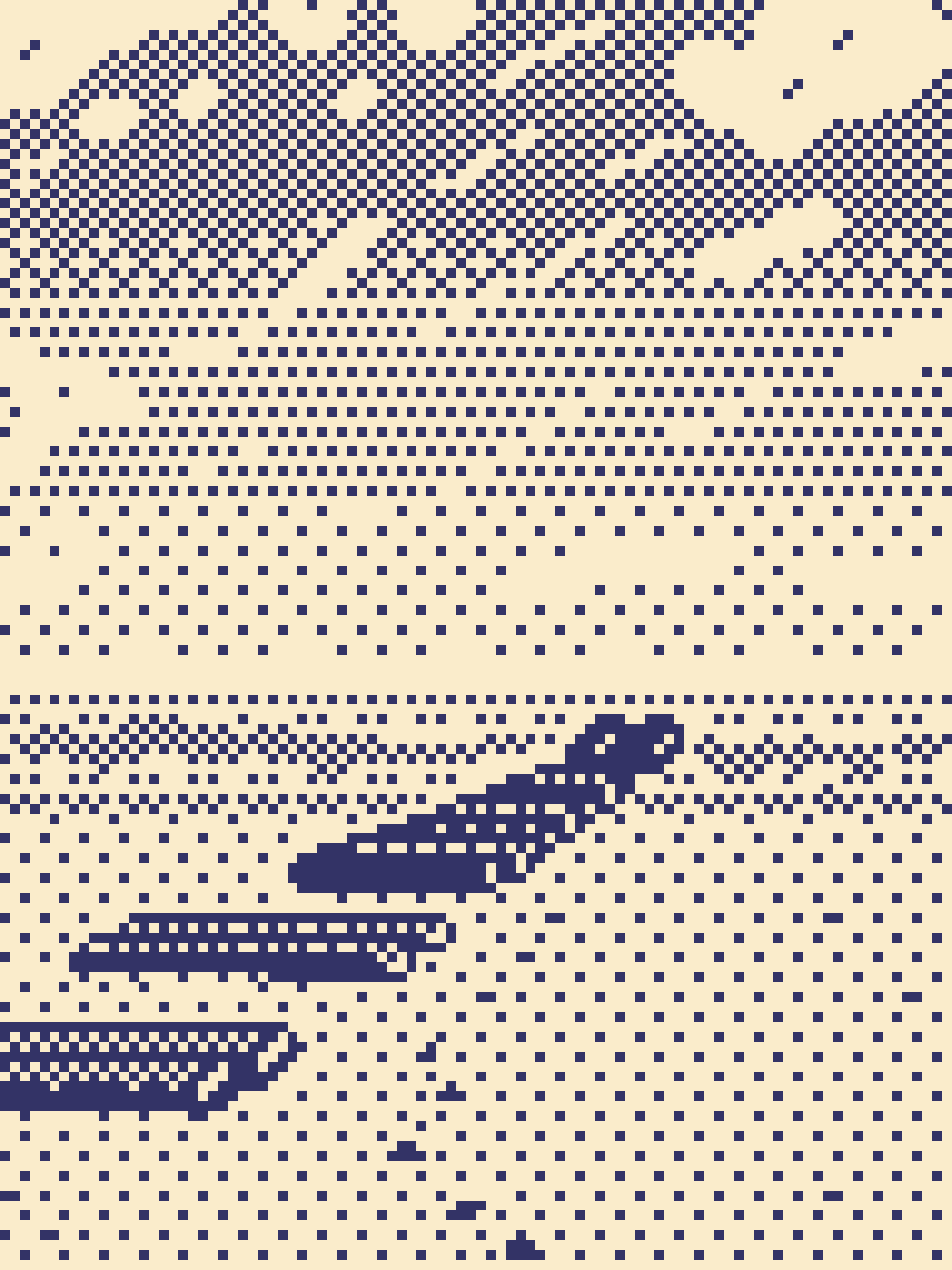
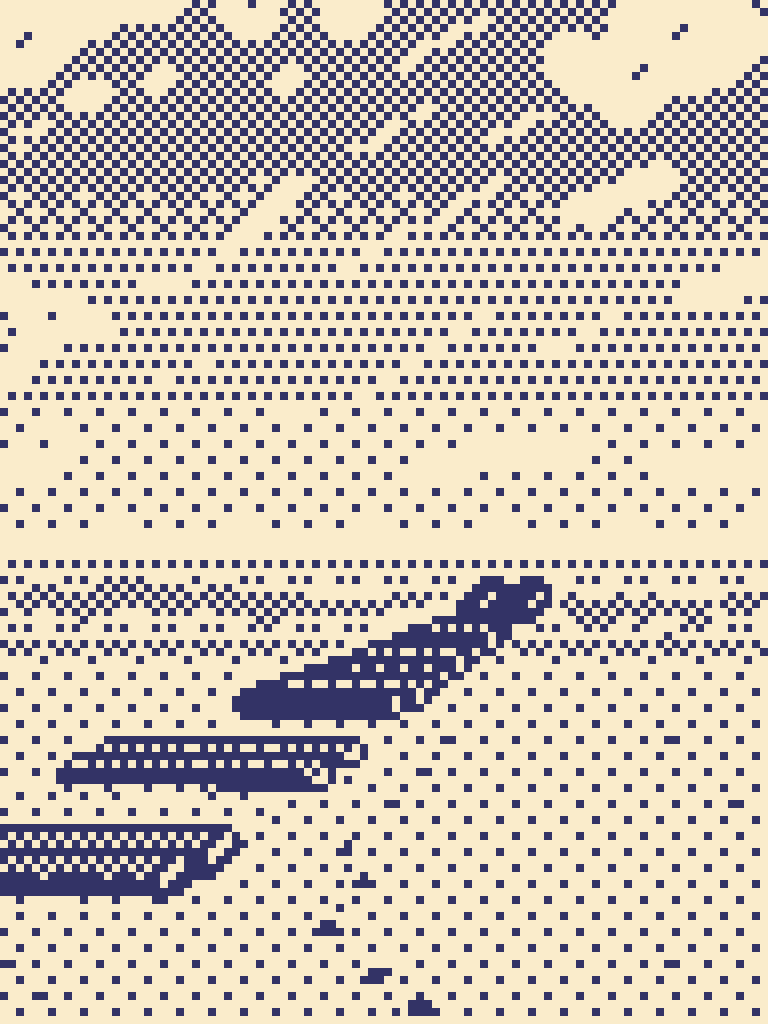
A 1-bit, low-res pixel art image of an outlet pipe and it protective beams on a beach.
A good experiment but I’m not really that happy with how it came out.
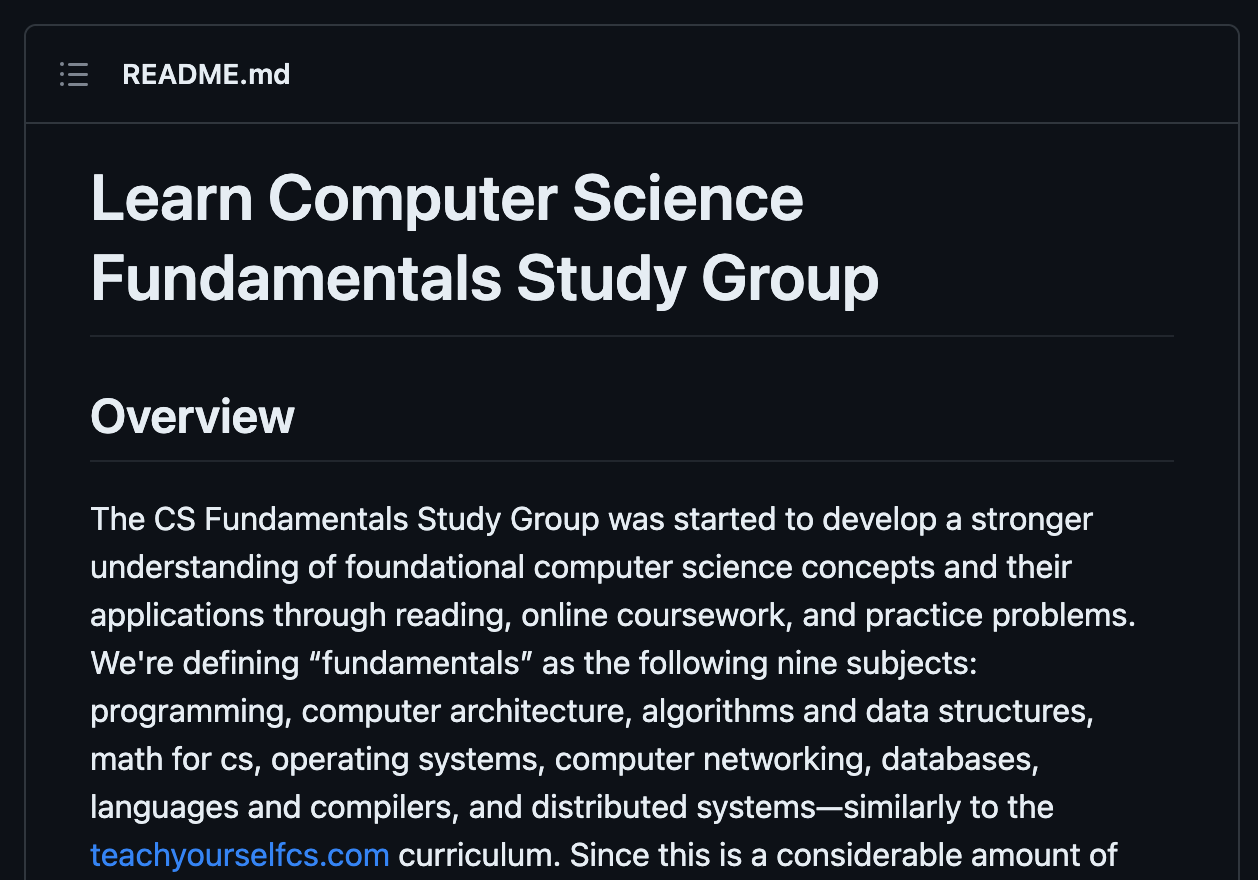
A repository of the work that fellow Azavea co-workers and I went through to learn computer science fundamentals.
See the code here

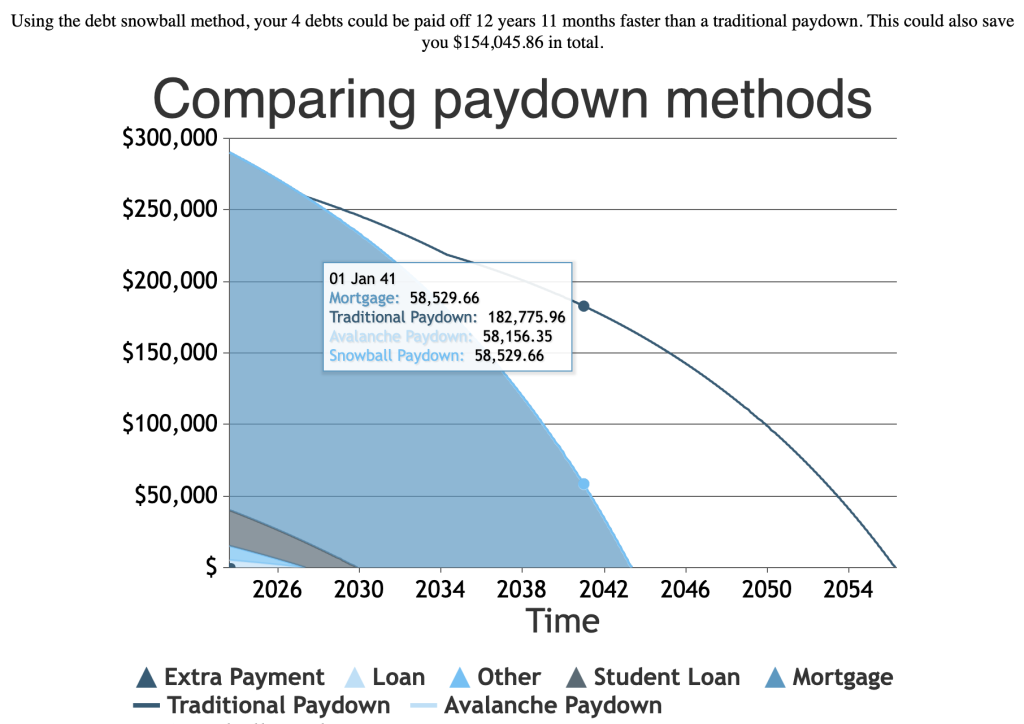
A debt snowball calculator with a chart showing how the different debts pays down as you follow the plan
See the code here
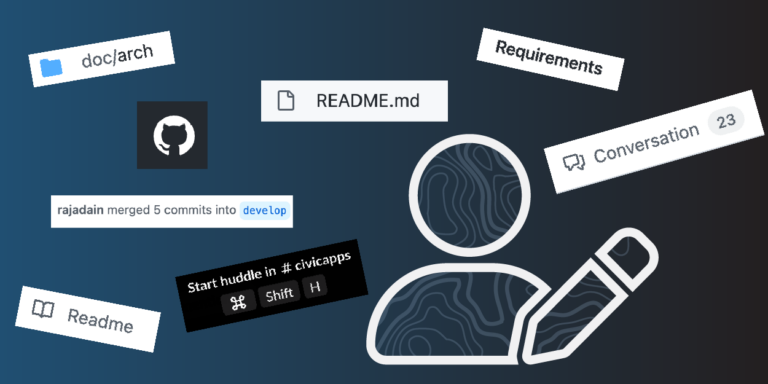
Note: This was originally published on the Azavea blog, but I wanted to put this here in case that blog disappeared.
Documentation is vital for anything open source; from open hardware, to free recipes, to DIY repair tutorials, but it is especially vital when it comes to software. Whether you’re a user or a developer, documentation provides the “how to” for interacting with any piece of software.
Since I first started getting into software development two years ago, I’ve learned that documentation frequently assumes you already know how to use the item in question, and are using the docs as a reference. While acting as a reference material is one of documentation’s important functions, it cannot be the only function, but more on that later.
First off, what counts as documentation? It’s not just the README.md in a project’s repository. Documentation also includes websites, other files in a project repository, comments in your code, commits in your codebase, and also chat app channels and threads. Developers also often look to Stack Overflow and GitHub discussions when looking for existing solutions for a given problem.
Having a single “source of truth” for documentation is ideal, but also largely impossible since there are son many different places we talk about our projects. Even so, there are good ways to distill these conversations into good documentation. At Azavea we are good at taking big architecture decisions and recording them in our repos as Architectural Decision Records, also known as ADRs.
ADRs are excellent for decisions with project-wide implications, but teams also make a lot of decisions inn seemingly innocuous conversations. Sometimes we have a conversation on Slack, a conference call, or even,n sometimes, in person. In many cases, any learnings from these conversations goes unrecorded. On the Civic Applications team (my team), we try to remedy this issue by putting notes from these chats into a relevant issue or pull request on the project’s Github repo.
Knowing who you are writing your documentation for is key to recording the most important elements. When itn comes to software, there are two primary types of people trying to learn how it works: developers and users.
You want your users to know how to use the app, especially parts that they won’t need to touch often and therefore won’t have as much practice and experience with. While it is important to do your best to design the app itself to be intuitive and to be usable without explanation, there will always be users who need an explicit explanation of how to use most features.
In open source spaces we also want to ensure our contributors know how to develop the app. By writing our issues and documentation as clearly as possible, contributors are more able to seamlessly jump into a project and follow the conventions of your project without issue.
Documentation is often frequently used as reference for developers who are experienced with this codebase. Having a skimmable documentation that is clearly visually and logically broken up helps to improve reference-ability so much.
Creating documentation that works for both users and developers is a mutually beneficial effort. When contributing developers know how to use the app in question, it is much easier to develop a smooth user experience. This being said, users do not need to know how to develop the app. My colleague, Terence,n pointed out this is similar to a driver not needing to know how the car works to drive it; they just need ton understand how to use the pedals, wheel, and signals.
One question repeatedly surfaced during my discussions with colleagues about this topic: How much information should the documentation assume the reader already has? According to existing research, it’s important to assume nothing about the reader. Even though it’s important to provide content that avoids leaving readers in the dark, it’s also crucial to avoid overwhelming then reader with a giant wall of text or presenting the reader with extraneous, repetitive information.
In order to prevent overwhelming the reader we recommend visually breaking up the documentation so that it is easier to skim or scan through for important information. Breaking up large documents into smaller chunks is especially important while generating documentation for a library of components.
In journalism, there is a concept called the “inverted pyramid of information” where the broadest, most important concepts are at the top of the piece and smaller, less relevant details appear later in then article. In talking with our User Experience Team Lead, Catherine Oldershaw, she told me that in UX this concept is often reversed, and instead manifests by managing the cognitive load of an application with a technique called “bubble up; drill down”. In other words, more digestible pieces of information bubble to the top and then author drills down to more complex details as the documentation is written.
“A great way to check this is to see if the information hierarchy matches the visual hierarchy. Key information (high in the information hierarchy) should also be visually prominent (high in the visual hierarchy), and more nuanced, detailed information should be lower in the information hierarchy and visual hierarchy.”Catherine Oldershaw
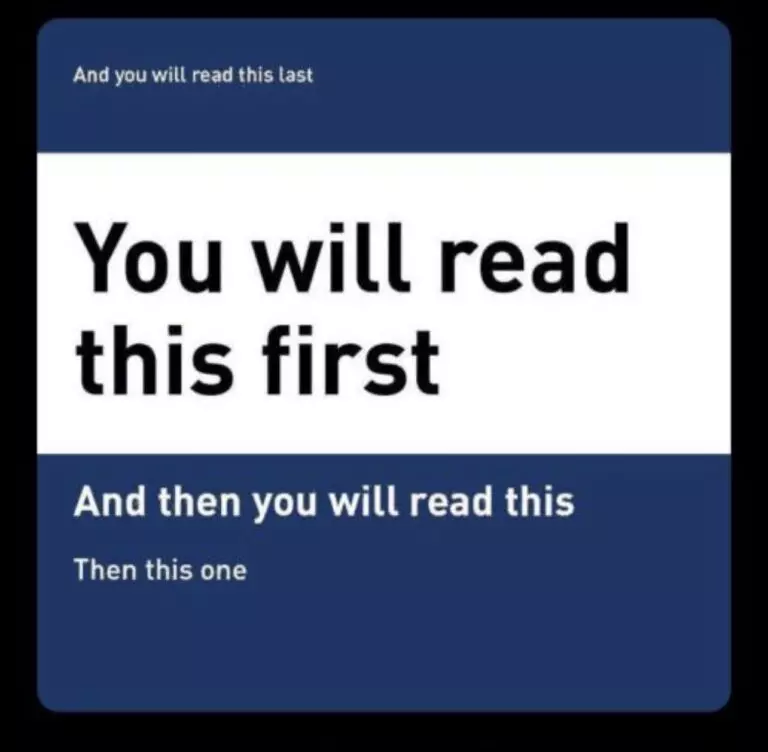
During our conversation, Catherine also shared that developers tend to write documentation that follows then structure of the project, instead of following a structure that would improve readability. In order ton maximize readability, it is much more helpful to structure the documentation in a manner that a developer new to the project would expect (i.e. with clear and skimmable sections), but this is not the norm. There is some serious discretion needed to determine this, but following an organization design the reader is familiar with can lead to great success.
Although it may seem counterintuitive to many developers, repeating important information while generating documentation is crucial and doesn’t take away from the piece’s skimmability. As devs, we are taught ton write DRY code (Don’t Repeat Yourself) which certainly makes more maintainable code. This being said,documentation is for teaching as much for reference, and in a previous career I was trained that repetition is good for teaching. American reading teachers are trained with the idea that you begin ton understand a word after you have heard or read it seven times.
While repetition may seem tedious to read, good documentation will explain a concept or abstraction just about any time it comes up. This reduces how much the reader needs to move back and forth to understand what they are reading and helps to avoid splitting their attention while reading about how to use or develop then app. Repetition also helps to make the documentation more skimmable, which is very desirable.
Ant Design is a library of React components and represents a great example of effective documentation. When looking through their components pages, there is a consistent shape to each component’s write-up.
There is a small description of what each component is and what it is for, followed by a more in-depth description of the particulars of the components and why one may need those different settings. After these descriptions, there are examples of variations on the component that show what the different settings and props do.

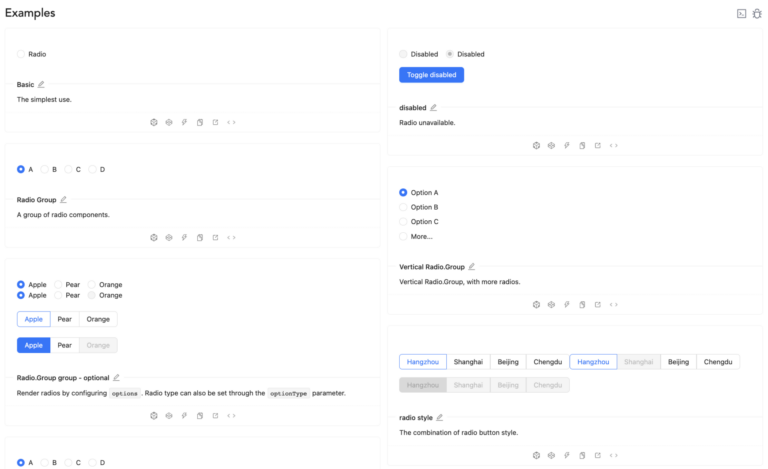
AntD’s component docs also have code examples and interactive sandboxes that are entirely either “opt-in” or collapsed so as not to overwhelm the reader. The documentation finishes out with an API reference chart for experienced developers to find the particular details like default values or the list of options for any specific quality the dev is looking for.
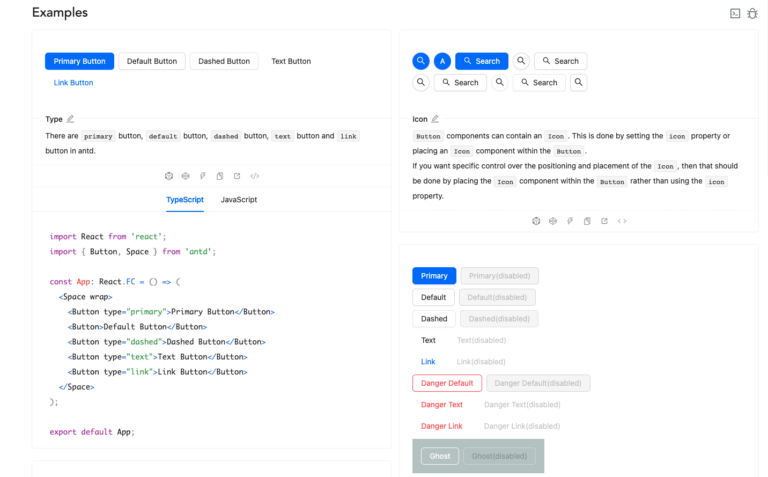

The shape of these documents make it easy for devs new to AntD to easily get a descriptive walk through what this component does and why its different pieces are useful. Having an API chart at the bottom is also great for veteran AntD users to quickly look up specifics like default values, types, and a quick reminder. Having benefits for both audiences doesn’t detract from either experience, and the consistency of this format amongst all the different components means once you understand the pattern it’s very easy to look through any component’s doc for the details of any specific needs.
As said above, documentation is more than just README.md and /docs pages. One of the bits we do well at Azavea, especially on the Civic Applications team, is using commit messages as documentation. This may seem odd to some developers, since many do not consider this to be documentation.
When looking at what may read at first as an odd piece of code, we check the git blame and see what commit and PR this piece of code came from. Ideally this PR will say what was trying to be solved as a whole and the commit will say what was specifically changed to do this.
Our local master of this technique is Senior Software Engineer, Terence Tuhinanshu of the Climate Applications team, who gave some great insight into this. At Azavea we try to write pull requests that address a particular issue and contain an list of commits that each make one change and title that change clearly in less than 50 characters (then limit to display in one line in GitHub), with optional details for further motivation. Each of these commits should appear in order, start with a present tense verb, and ideally read like steps in a recipe for how ton make this PR.
Here are a few examples of this that Terence has put together over the years, including one while Terence was into Gitmoji
The recipe part here is a nice analogy since recipes often fit a clear format that we often skim through and recheck each time we want to make a particular piece of craft. These steps should each be performed on their own and written with simple language to describe the action taken. A developer looking through this should be able to look through these steps and see how to recreate this themself or undo this work.
So, what makes good documentation?
There are many things that contribute to quality of documentation but to boil it down to a referenceable list we can say that good documentation is:
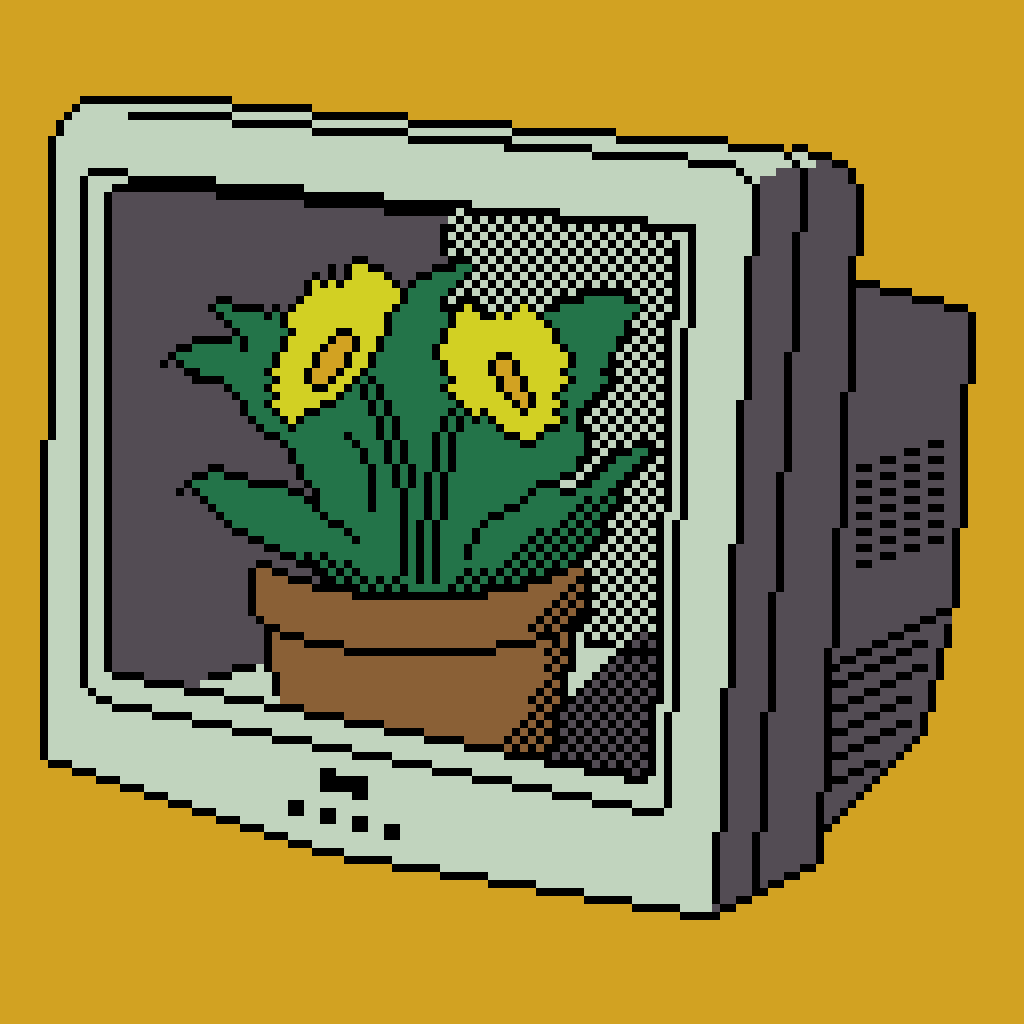

A low-color pixel art image of a potted flowering plant growing inside of an empty CRT TV
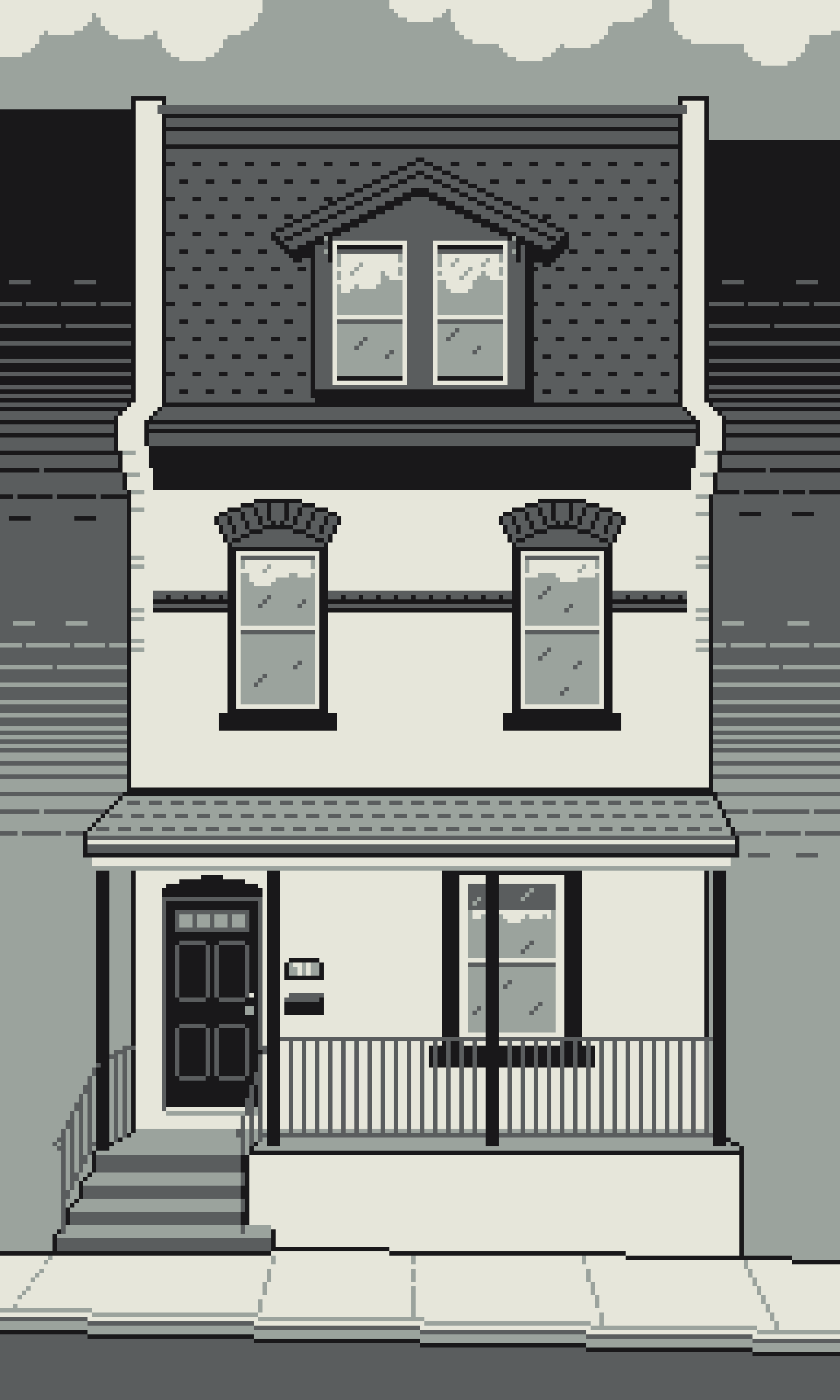
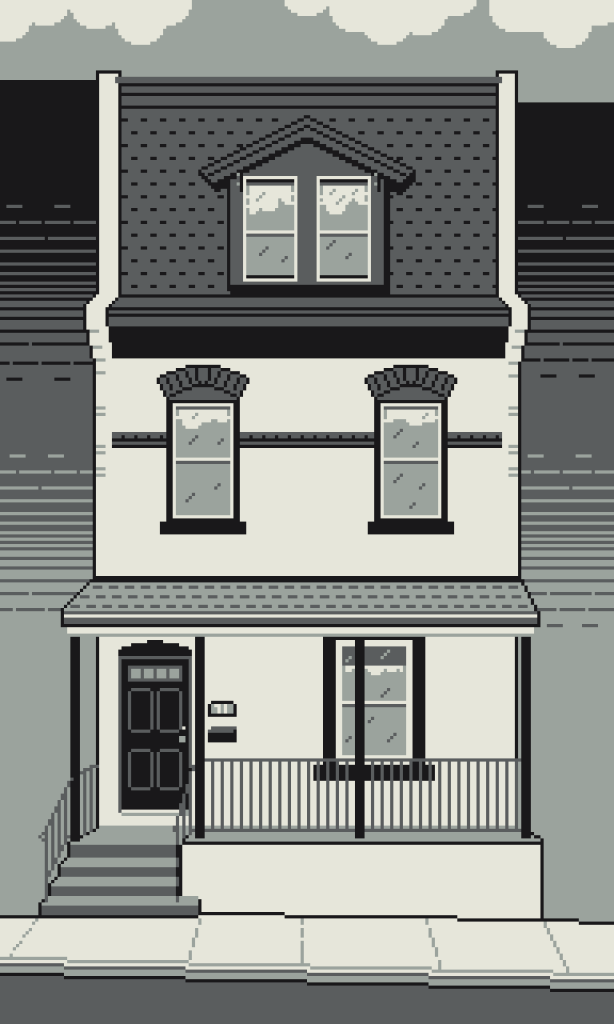
A 4-color grayscale art image of a rowhome
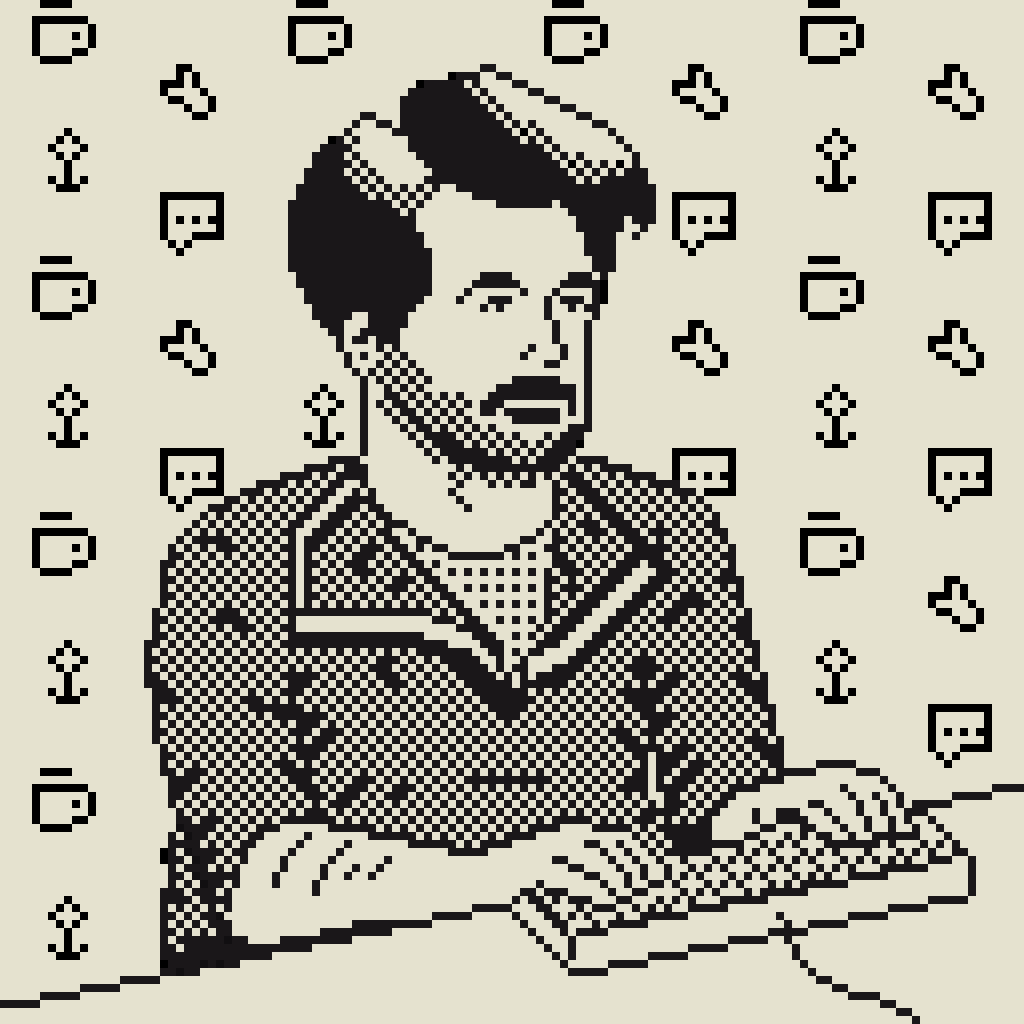

A 1-bit art self portrait of me using a keyboard
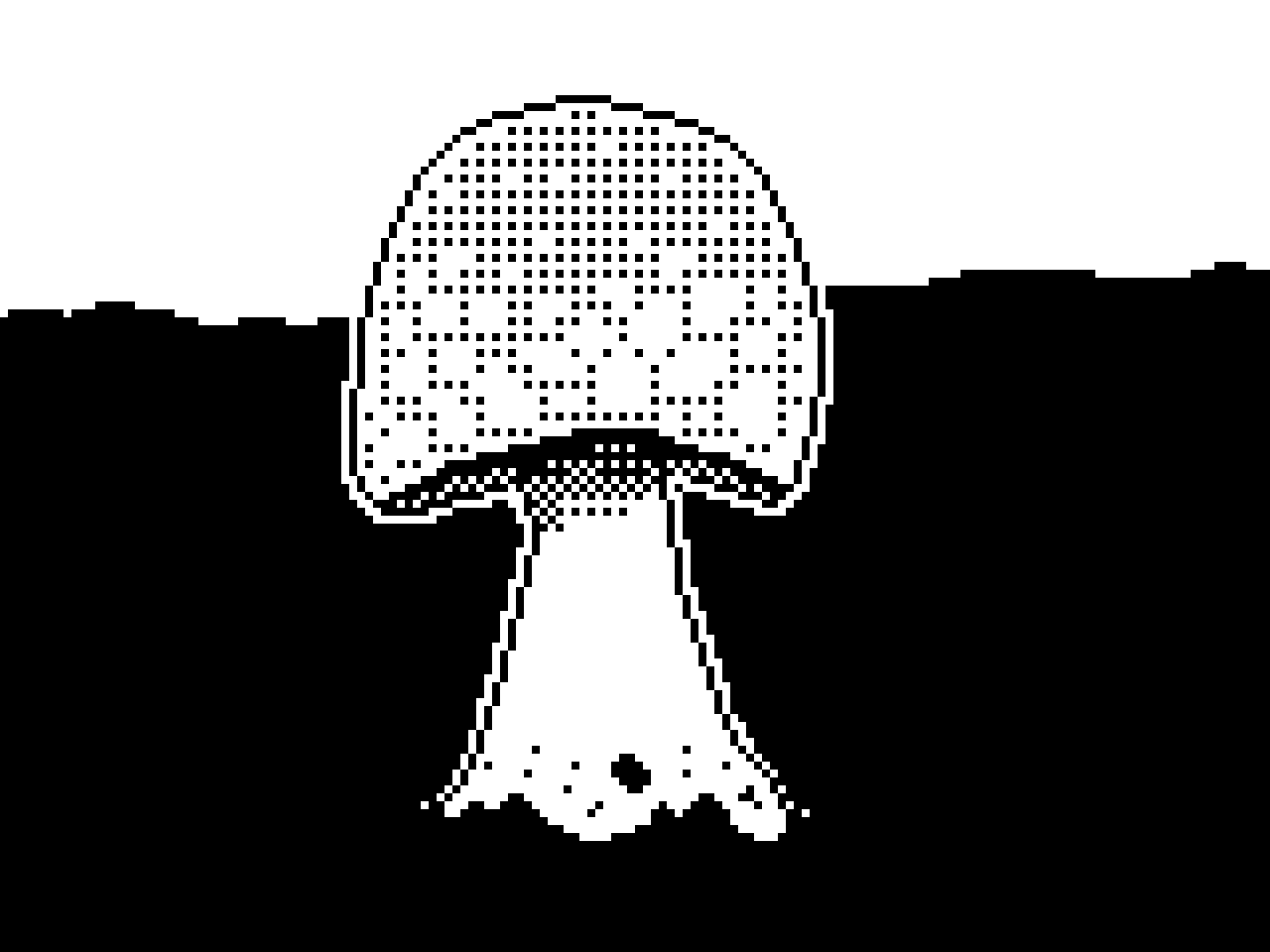
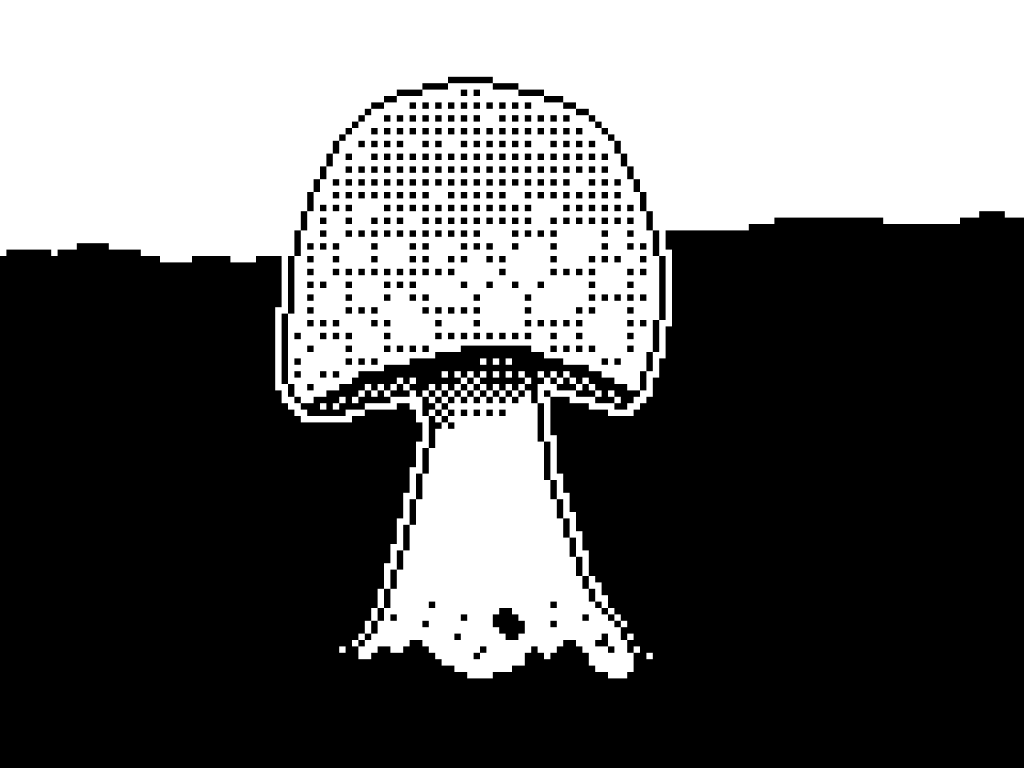
A 1-bit art closeup image of a whitecap mushroom
Azavea | Philadelphia, PA
December 2021-February 2023
I worked on the Civic Applications team working on client services projects to build and maintain geospatial web applications built in React, Django, MapBoxGL, and PostGIS for governments, non-profits, and corporations.
Azavea | Philadelphia, PA
May 2021-December 2021
Spent 6 months with a mentor extending my knowledge of React, Django, and geospatial tools like PostGIS and MapboxGL.js with reading materials, hands-on ‘breakable toy’ projects, as well as independent and supervised client work. Besides my mentor, I also worked with a small cohort of two other apprentices sharing what we worked on each bi-weekly sprint and helping to bridge each other’s skillsets.
Urality | Philadelphia, PA
February 2021-May 2021
Built new features for and maintained a community mapping and digital placemaking web application and content management system using React Hooks, Bootstrap, MapboxGL, and various NPM modules.
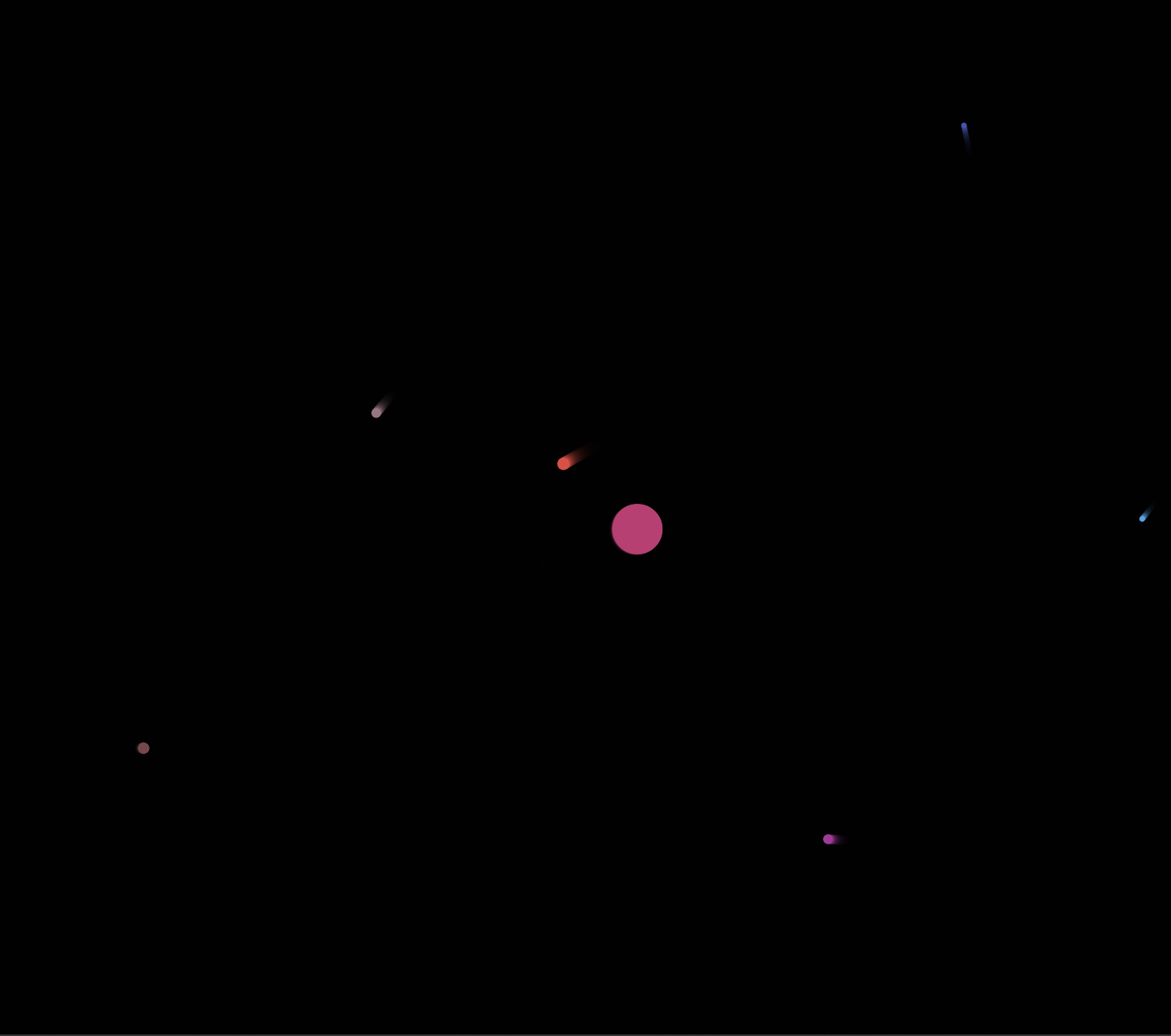
A small 2D simulation of particles enacting gravity on each other and combining as they get close together.
See the code and play with it here
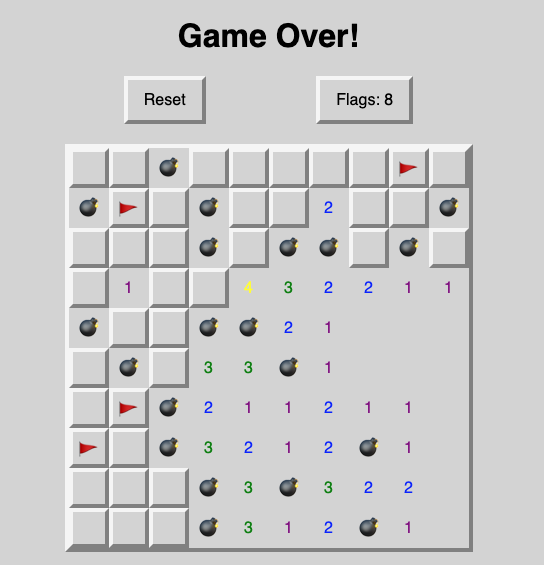
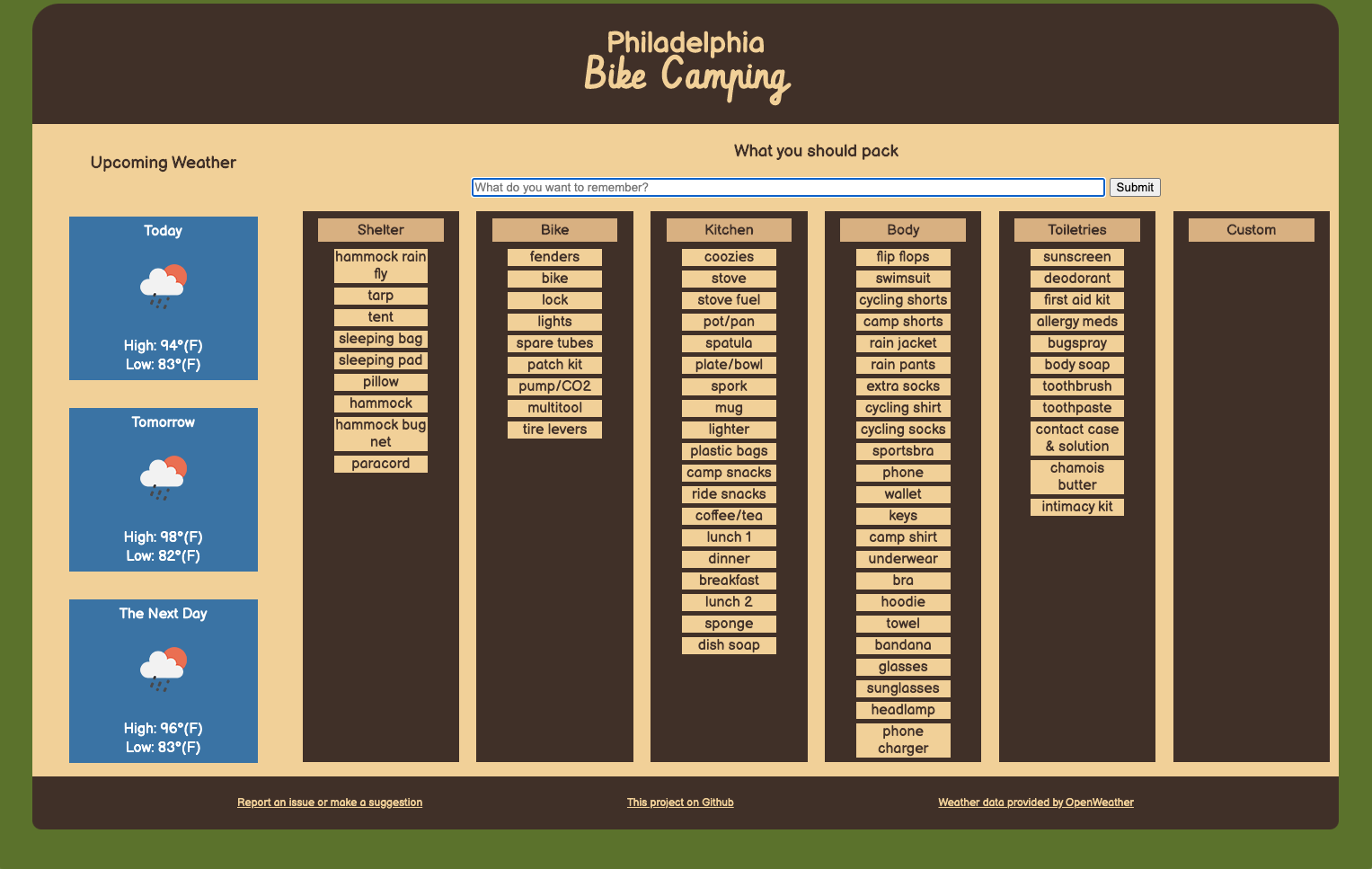
General Assembly | Philadelphia, PA
May 2020-August 2020
Learning frontend and backend programming alongside frameworks and languages like Javascript, jQuery, React, Python, and MongoDB. Building and deploying a portfolio of functional projects that all address various needs.
Cycles PHL | Philadelphia, PA
April 2017-January 2021
Repaired and sold bicycles in a community-oriented shop in North Philadelphia. We also provided adult camping programming and fix-your-own-bike workshops. Our shop catered to local neighbors and university students. I worked on bicycles, kept the shop in order, and ran programming like our Cycles Campout overnight camping trips and Bike Salon, our do it yourself repair program. We helped adults and youth alike keep rolling and to enjoy their bikes.
Bicycle Revolutions | Philadelphia, PA
February 2016-January 2017
Bike & Build | Providence to Seattle
December 2015-August 2016
I co-led a group of 29 young people on a bike tour from Providence, RI to Seattle, WA to raise money and awareness for affordable housing. We rode roughly 4000 miles, built in 13 different cities, and raised roughly $60,000 to give away in affordable housing grants.
WHYY | Philadelphia, PA
September 2015-January 2016
Served as a production assistant on the WHYY Friday Arts show providing field production assistance, transcribing interviews, and editing shorts and extras for the web.
Freelance | Philadelphia, PA
October 2013-April 2020
I have been making digital content like video, photography, and comics from a few different outlets. My video works have been a variety of works ranging from music videos to talk shows to fiction stories to vlogs to documentary style shorts
Bike & Build | South Carolina to Santa Cruz
May 2013-August 2013
n the summer of 2013, I and 27 other young people crossed a continent by the power of our own legs. We saw the United States at a pace, scale, and perspective that few have or will ever have. We crossed plains and deserts, climbed hills and mountains, and built homes along the way. As a team we rode 4,250 miles through 13 states, raised $154,895 for affordable housing, ate countless peanut butter and jelly sandwiches, and built for a collective 3,584 hours with Habitat for Humanity.
CORA Services | Philadelphia, PA
July 2012-February 2016
With CORA Services I worked at 3 different schools in different capacities working with a variety of students, age-groups, and lesson materials. I have worked with all grades between Kindergarten and 8th grade and have taught acting, better behavior, science lessons, photography and film lessons, a variety of crafts, and even managing a public group profile for projects with my current group. I have also helped all of my students in countless hours of homework help and different tutoring sessions.
City Year Philadelphia | Philadelphia, PA
June 2011-June 2012
I served as a Diplomas Now Team Leader for City Year and will lead a team in addressing the Drop-Out Crisis at a Philadelphia school. I will be in charge of tracking the data for my team, building and maintaining relationships with service partners, collaborating with a School Transformation Facilitator from the Philadelphia Education Fund and a Site Director from Communities in Schools in helping to create a beautiful environment for our students to work in and to tutor and mentor students to help make sure they are on-track and inspired to graduate high school.
City Year Philadelphia | Philadelphia, PA
August 2010-June 2011
My corps year, I served on the TEVA Pharmaceuticals Team at Thurgood Marshall Elementary. I followed a class of 8th graders from class to class providing classroom support, tutoring, behavior and attendance coaching, and helping to make sure my students had everything they needed to work hard in school. I also created and ran a project to have all the students at Marshall write letters to the President of the United States, helped to run our after school programming, played at recess with my students, and helped to organize many assemblies including a play at the end of the year.
Shawnee Playhouse | Shawnee-on-Delaware, PA
December 2009-April 2010
Siamsa Irish Pub | Stroudsburg, PA
October 2009-August 2009
Shawnee Playhouse | Shawnee-on-Delaware, PA
October 2009-December 2009
Five Star Staffing | Philadelphia, PA
October 2008-August 2009
Shawnee Inn and Golf Resort | Shawnee-on-Delaware, PA
September 2007-June 2009
Brainerd Presbyterian Center | Philadelphia, PA
June 2007-August 2007
Aramark | East Stroudsburg, PA
September 2004-August 2005